- Tours & Experiences
- Tailor-made Trips
- Bahasa Indonesia
We are happy to see you again!

Continue with
Or use email.
No Account? Create one
Create account
Already have an account? Sign in
Quickly Sign up with
I agree to Japan Travel's Terms of Service and Privacy Policy . Terms of--> and acknowledge that Japan Travel's Privacy--> applies to me.-->
Email reset password link
Please check your inbox and click the link we will send to you.

Aizu-Wakamatsu
Things to do in aizu-wakamatsu.
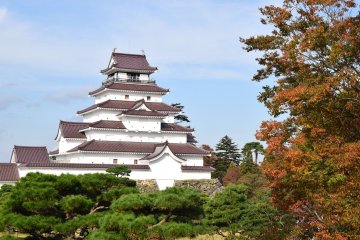
Tsurugajo Castle
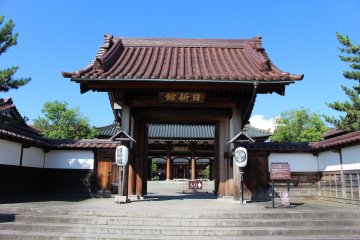
Cat Stationmaster at Ashinomaki Onsen

Aizu-Wakamatsu: Day 2
Upcoming aizu-wakamatsu events.

Aizu Festival in Fukushima 2024
Aizuwakamatsu City is well-known for its rich samurai heritage. Every year, a 3-day festival takes place around the castle and down..
About Aizu-Wakamatsu
Aizu-Wakamatsu is the capital of the Aizu region on the southern part of the Aizu basin, and came to be central to the region with the construction of Tsurugajo Castle in 1384.
Fukushima Top 10
- Recommended

Fukushima: Food Guide

Another Look at Aizu-Wakamatsu

Oze Gourmet Trip

Escape to the Countryside!

Sakura Spots in Iwaki City, Fukushima

Koriyama City Parks

Peachman Cafe

Kataoka Tsurutaro Art Garden

Aizu Festival in Fukushima

Adatara Illuminations

Aizu Sazaedo Temple

Goshiki-numa

Waraji Festival

Abukuma Oktoberfest

Aizu Wakamatsu Castle

Aizu Hongo Morning Pottery Market

Giant Buddha Statue in Fukushima

A Foggy Autumn Day at Aizuwakamatsu Castle
Where to eat in aizu-wakamatsu.
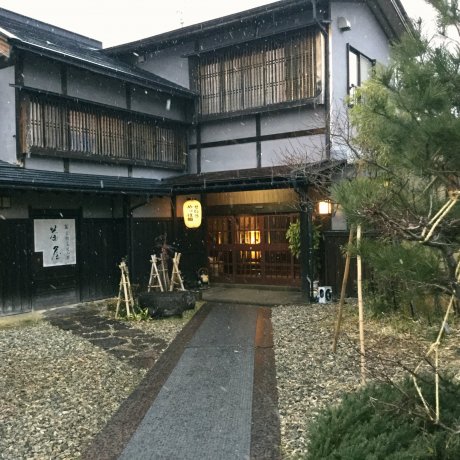
Tagoto Cuisine Inn
Tagoto Cuisine Inn, Aizu Wakamatsu City is an ideal respite for those who would prefer a slow and traditional pace. Tagoto is convenient..
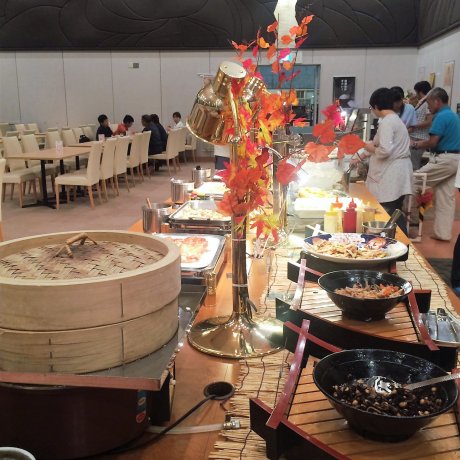
Fukushima Hot Spring & Lunch Buffet
Visit Yuya Aizu Hot Spring Hotel in Aizuwakamatsu City in Fukushima Prefecture for a rotating buffet (Japanese and other types of..

Suehiro Sake Brewery
Suehiro Sake Brewery is one of the most famous in the Tohoku region. You can do a free tour and tasting and see how this traditional..
Places to stay in Aizu-Wakamatsu
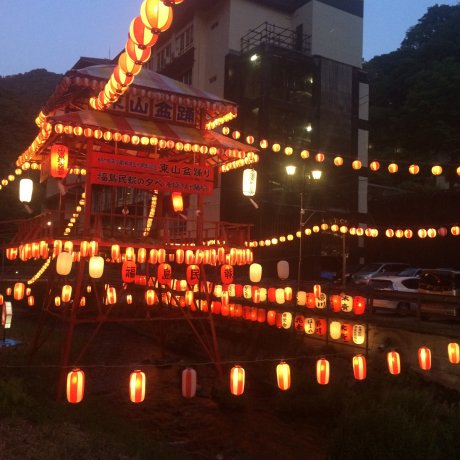
Higashiyama Hot Spring Town
Visit the hidden gem of Fukushima, located a short distance out of the main samurai city of Aizuwakamatsu. Accessible by shuttle..
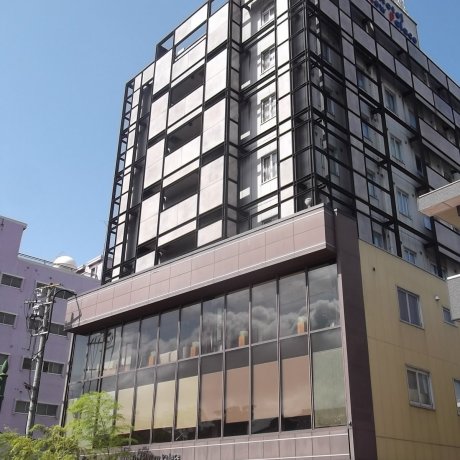
Aizu Wakamatsu New Palace Hotel
In Aizu Wakamatsu, a historical town in northern Japan's Fukushima prefecture, New Palace hotel is affordable and conveniently..
Latest Aizu-Wakamatsu Reports
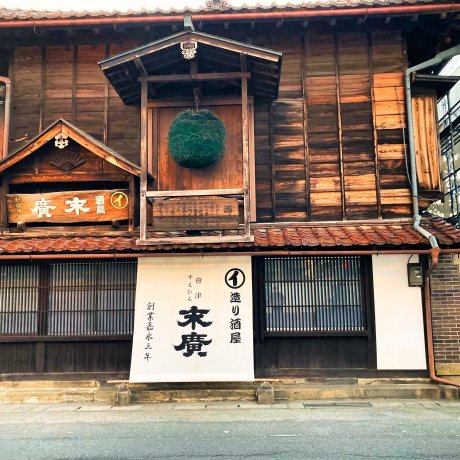
Hiking the five ponds area and second day exploration of Aizu-Wakamatsu

A visit to Aizu-Wakamatsu,the Samurai City. Enjoy Tsurugajo Castle, Rinkaku Tea Ceremony Room, Oyakuen Garden, and Sazaedo, a one..
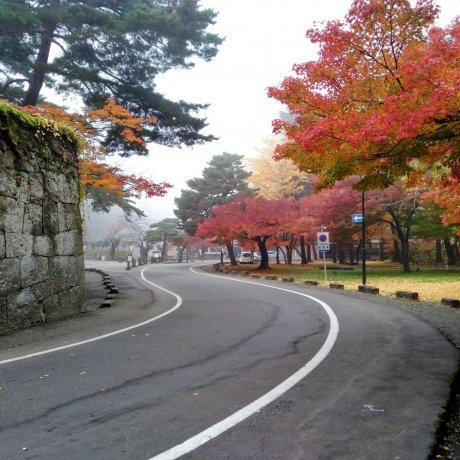
Tsuruga Castle (鶴ヶ城), also known as Aizu-Wakamatsu Castle (会津若松城 ) is a popular sightseeing location in Aizuwakamatsu ..
Let us know how we can help.
- Things to Do
- Tourist Spots & Attractions
22 Things to Do in the Aizu-Wakamatsu Area

- tsunagu Japan
Don't know where else to go that isn't just a big city? Want to make unique memories outside of the usual tourist areas? Try Aizu-Wakamatsu, a historical area that's beautiful and full of surprises!

This post may contain affiliate links. If you buy through them, we may earn a commission at no additional cost to you.
The Aizu-Wakamatsu area is situated in a valley, leading to beautiful landscapes but heavy snowfall in the winter. It was a very important base for the shogunate, and was the setting for one of the largest battles between the shogunate and the imperial Meiji government during the Boshin War. The famous story of the Byakkotai, the 19 teenaged samurai who killed themselves when they thought Aizu had fallen to the imperial forces, occurred on Mt. Iimori, one of the mountains that surrounds the area.
Because of the high amounts of snow, the water in the area is very clean due to the high amounts of runoff, which leads to beautiful hot springs and delicious sake and great food. Between the breathtaking scenery, the dramatic history, and the great food, you should add a trip to Aizu-Wakamatsu to your itinerary.
1. See the Munakata climbing kiln
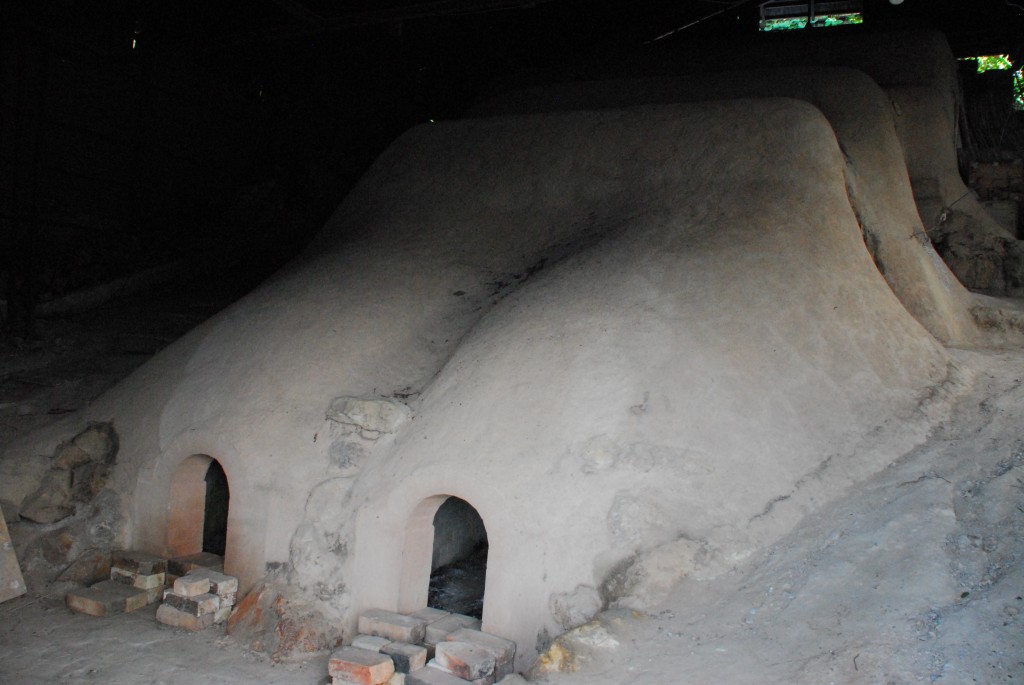
Photo by Hikaru Kamo .
A climbing kiln is a kiln that takes the slope of the mountain its built on so the heat rides through the chambers like stairs. The Munakata climbing kiln is a designated cultural property and was originally built in the middle of the Edo period, making it the oldest climbing kiln in the whole Tohoku region. Originally it had 7 chambers, but due to the damage of the Tohoku earthquake in 2011, only 3 have been restored. In honor of the restoration, they made and donated about 80 tea bowls for the Todaiji Temple in Nara. You can see the kiln (unfortunately, they cannot accommodate tours when the kiln is being used) and also peruse the pieces available for sale created by Toshihiro Munakata, the current master.
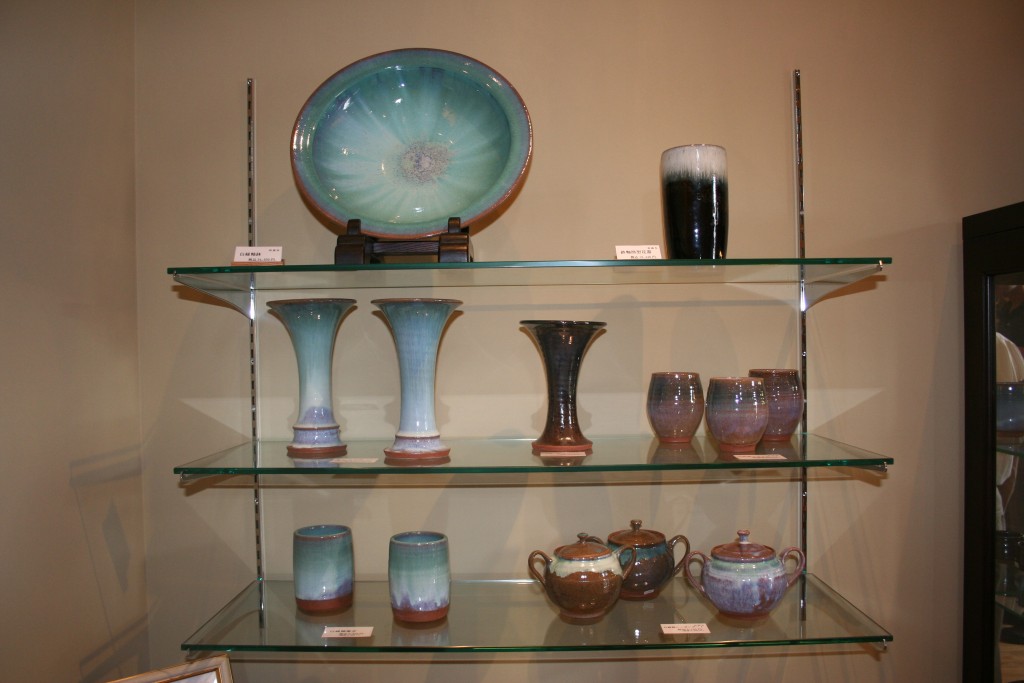
3115 Hongo-Kamiko, Aizu-Misatomachi, Onuma-gun, Fukushima-ken
Homepage: http://www.munakatagama.net/index.html
Click here for Aizu's special tour option that comes with bilingual guides.
Enjoy the traditional culture and hot springs of Aizu region
Discover the real rural japan and its traditions in oku aizu.
Click here if you would like to know more about the attractions of the Tohoku region including Aizu
Discover the natural wonders and traditional lifestyle of Tohoku region
2. make your own pottery.
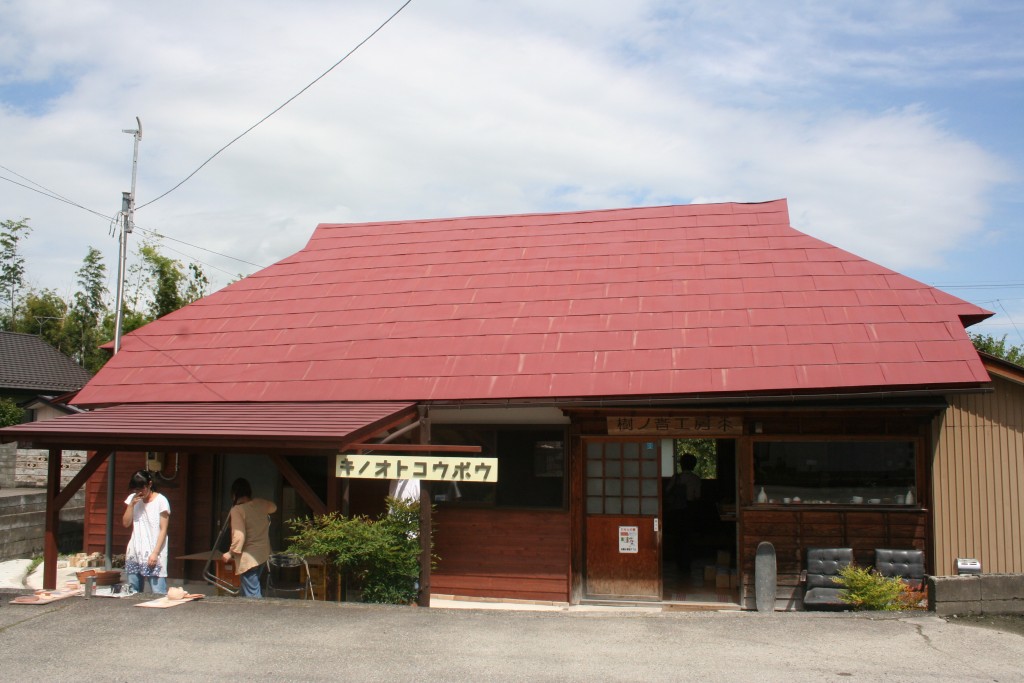
After seeing the pottery at the climbing kiln, you can make and/or decorate your own at Ki no Oto Koubou. You can make your own pottery, with help from staff, using a process called teniberi where the clay sits on a rotating wheel that you control with one hand. You can make items out of 500g of clay for 1000 yen or 1 kg for 2000 yen. If you don't want to challenge making your own items, you can decorate your own for 800 yen. It takes about two months before it's ready to be delivered to your home; shipping within Japan costs 1000 yen and international costs 2000-3000 depending on weight.
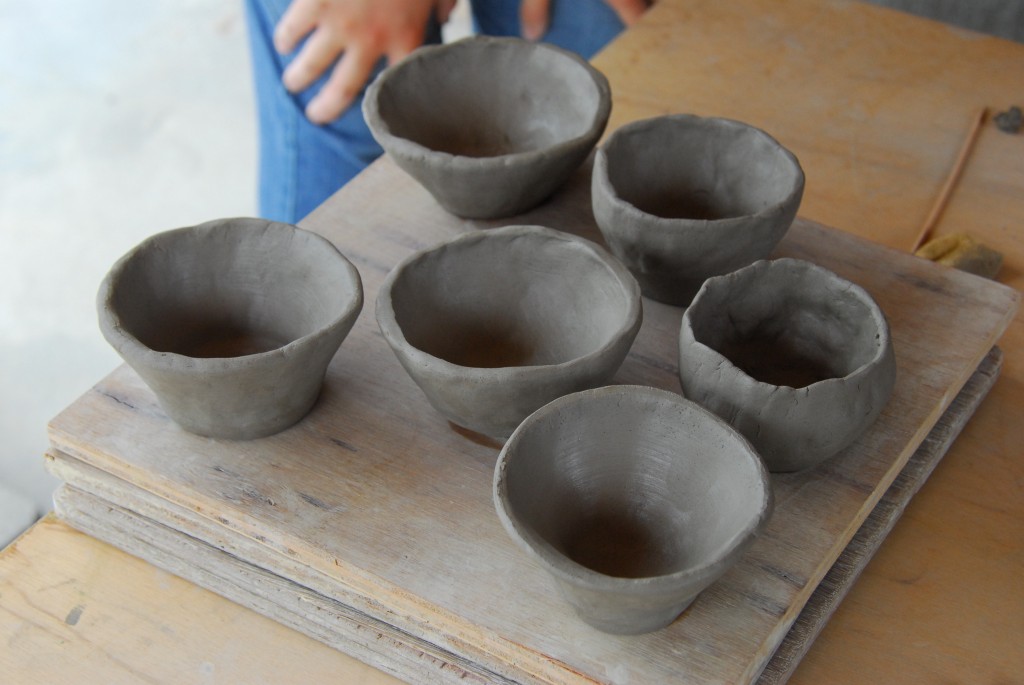
Photo by Hikaru Kamo.
3272-1 Setomachi, Aizu-Misato, Onuma-gun, Fukushima-ken
Homepage (Japanese only): http://www.kinooto.com/
3. Eat traditional Aizu food at Takino
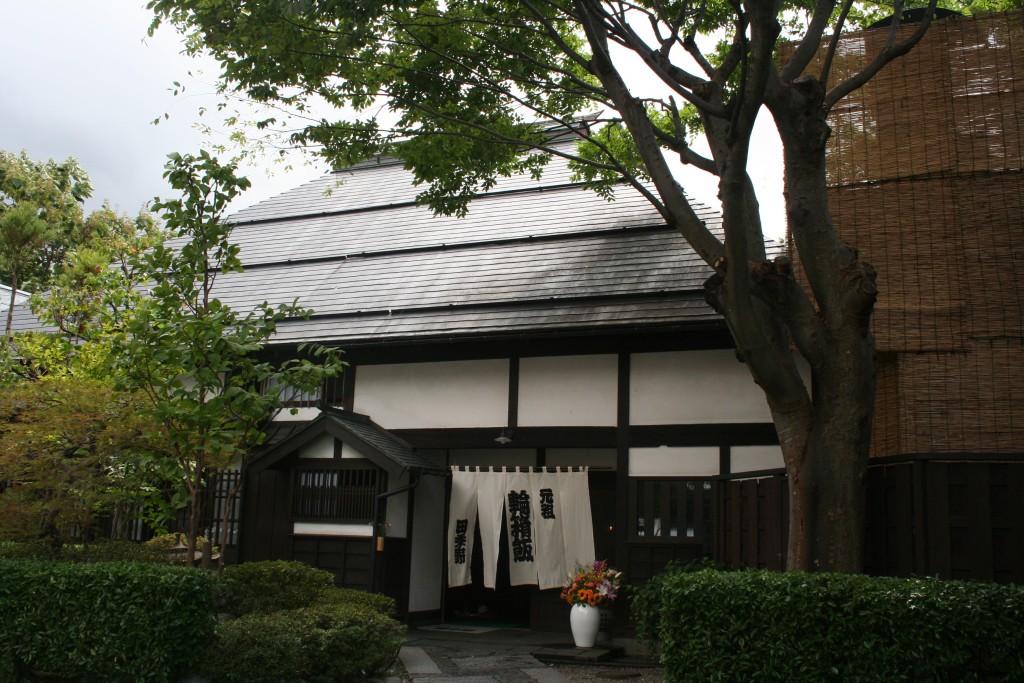
Takino is a famous Japanese restaurant that has been in business since the Kamakura era (1185-1333). You can have traditional Tohoku fare, such as nishin no sanshozuke (herring pickled in malt vinegar with pepper plants) and wappameshi. Wappameshi is a meal with rice and various toppings prepared in a container called wappa, which is a container made of thin sheets of wood used by Aizu woodcutters to take their lunch with them to the mountains. They also have soba that is eaten with a leek and bonito flakes, as shown in the photo below.
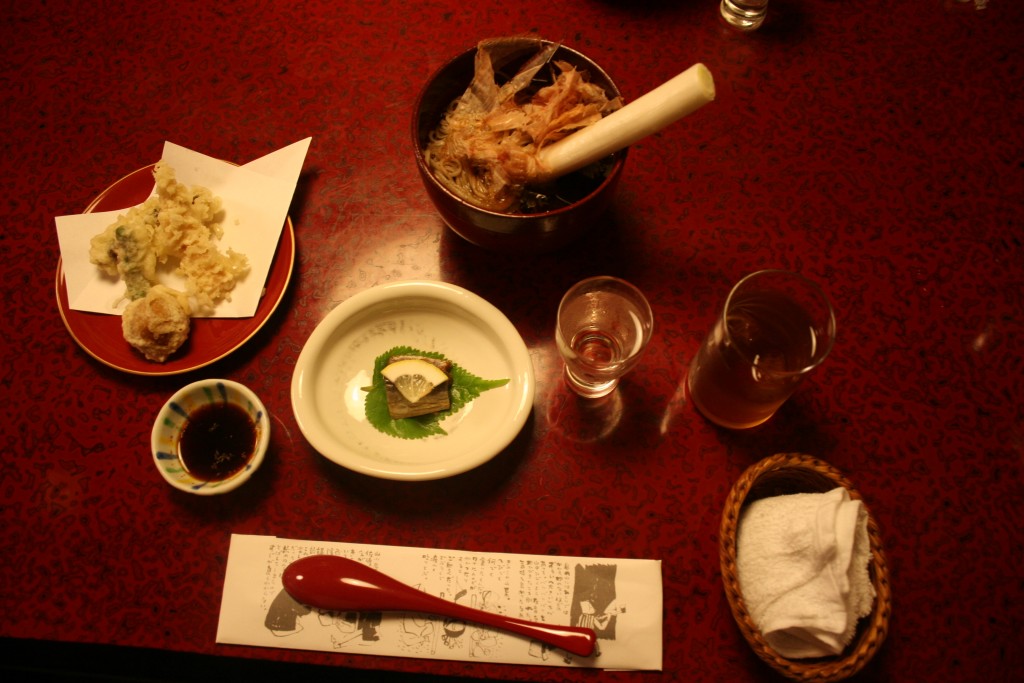
5-31 Sakaemachi, Aizuwakamatsu-shi, Fukushima-ken
Homepage: http://www.takino.jp/frame.html
4. Have a sake tasting at Aizu Homare Sake Brewery
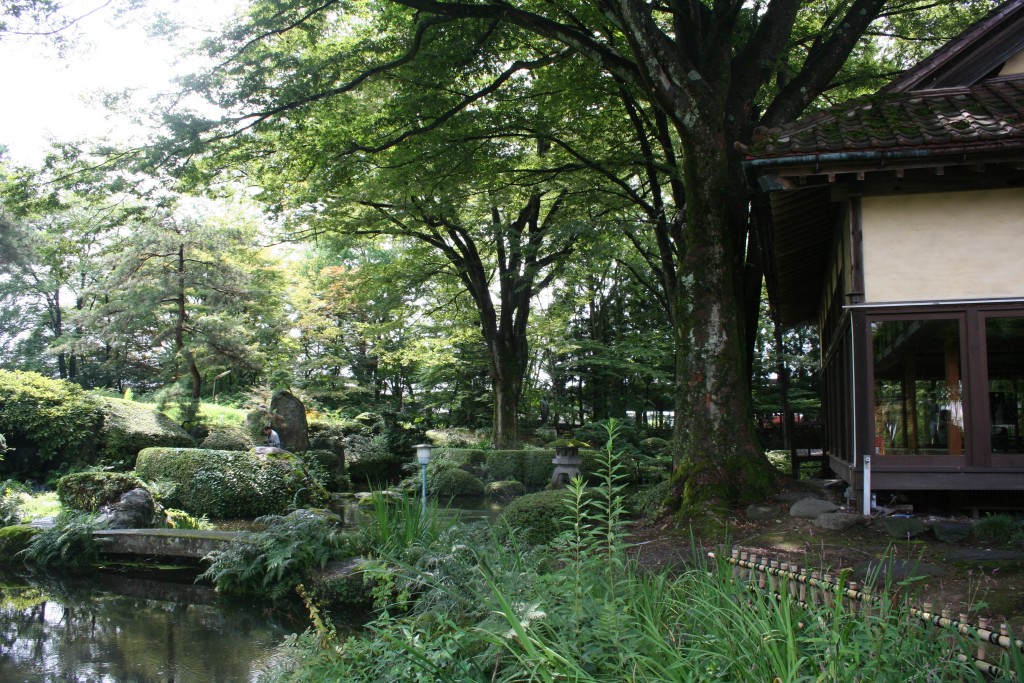
Aizu Homare is one of the best breweries in Tohoku, and has repeatedly won awards at the International Wine Challenge. Here you can take a tour and learn about the sake process before enjoying over 10 varieties of the sake and liqueurs on offer. Their large Japanese garden is also an attraction. There is no entrance fee, and they also offer tours in English.
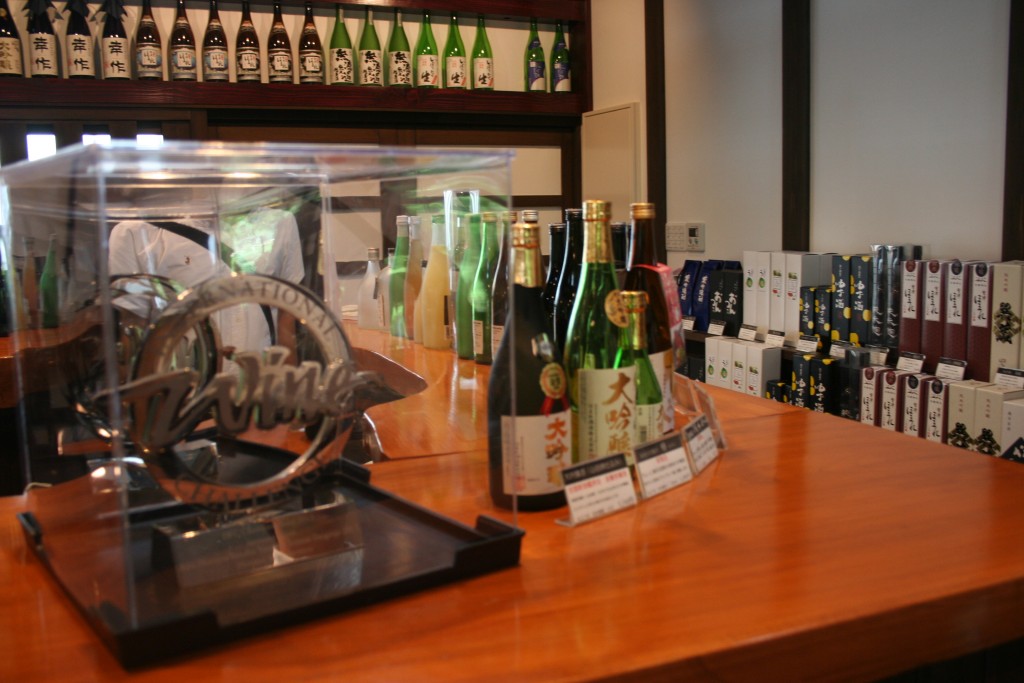
2706 Tokiwa-cho, Muramatsu, Matsuyama-machi, Kitakata-shi, Fukushima-ken
Homepage (Japanese only): http://www.aizuhomare.jp/
5. Make your own painted candles
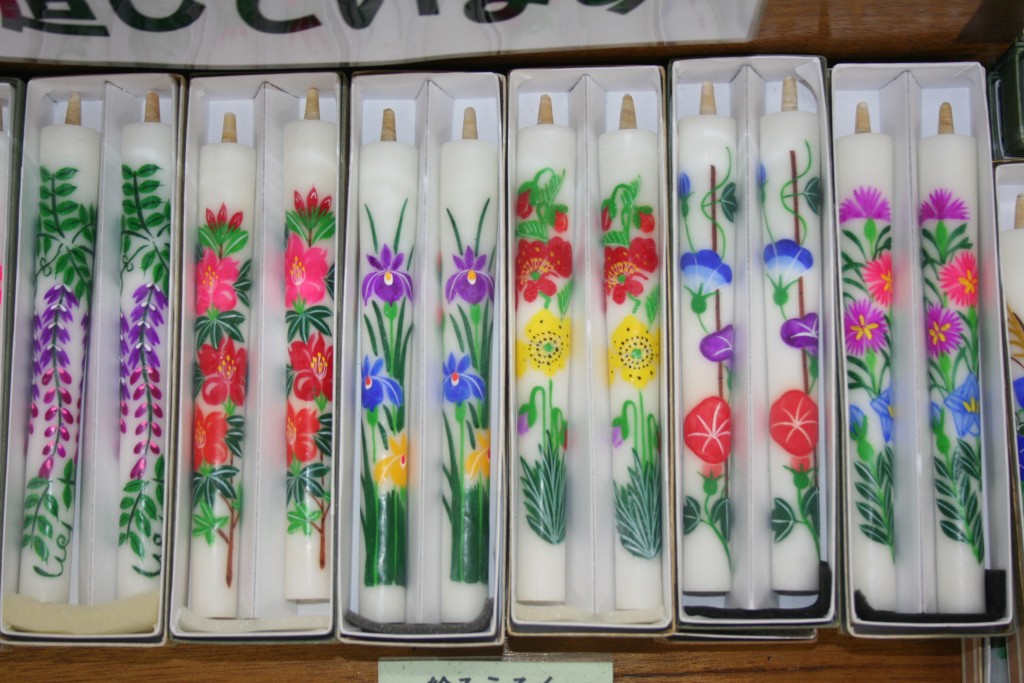
Candles came into use in Japan 500 years ago, and the people of Aizu began painting them 80 years after. In snowy prefectures like Fukushima, these painted candles were used on altars in place of flowers during the winter. Hoshiban has been creating painted candles using wax made from Japanese wax tree seeds since 1772. While most other painted candle makers today make candles using a combination of machinery and craftsmanship, Hoshiban is the only maker in the area that does the entire process by hand. You can paint your own candles as well! It's 1620 yen per person and they take groups of up to 75 people. Reservations are required two days in advance.
3-33 Nanokamachi, Aizu-Wakamatsu, Fukushima-ken
Homepage (Japanese only): http://hoshiban.com/
6. Visit Tsuruga Castle
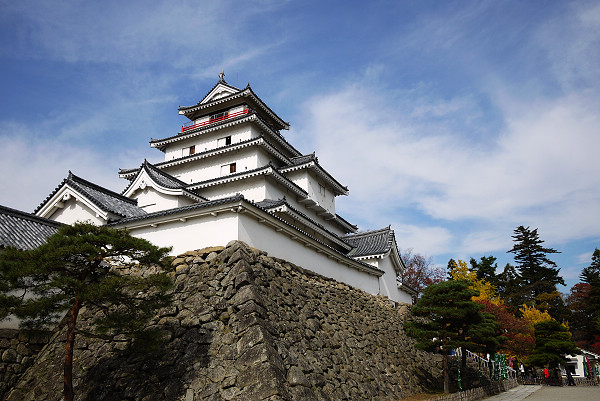
The Aizu area was one of great importance in the control of eastern Japan during the shogunate area and this castle, originally built in 1591, was an outpost that many generals were sent to for a few years during their careers. The castle and the Tokugawa shogunate had very close ties, and as a result they fought against the Meiji government in the Boshin War. The Meiji government attacked the castle using guns for a month before the castle fell. It was rebuilt in 1965, so this year is its 50th anniversary. Entrance fees are 410 yen for adults and 150 yen for children. You can reserve a tour guide in English or Chinese two weeks in advance and choose from three different tour courses. If you're lucky, you might be able to take a photo with a samurai!
1-1 Otemachi, Aizu-Wakamatsu, Fukushima-ken
Homepage: http://www.tsurugajo.com/language/eng/index.html
7. Visit a samurai's home at the Aizu Bukeyashiki
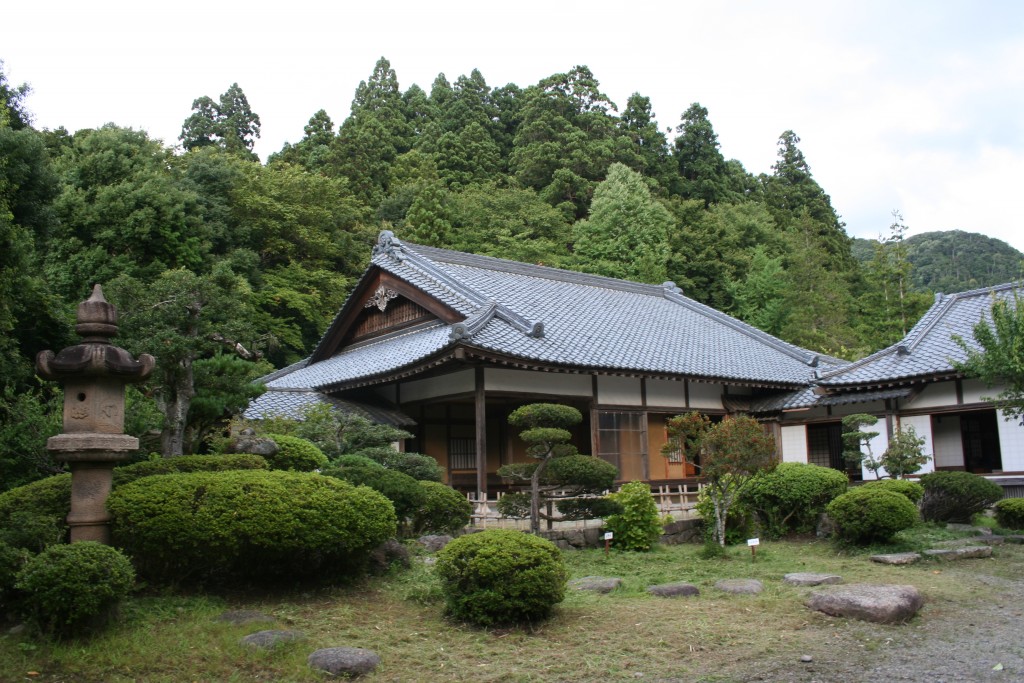
A bukeyashiki is a samurai residence, and this one served as the quarters for the region's highest ranked samurai, his family, employees, and servants. It was originally burned down during the Boshin War but it was then rebuilt to replicate its appearance as it was in the Edo period. There are dozens of rooms and some of them have mannequins showing scenes from everyday life in the period or dramatic historical events. Entrance fee is 850 yen.
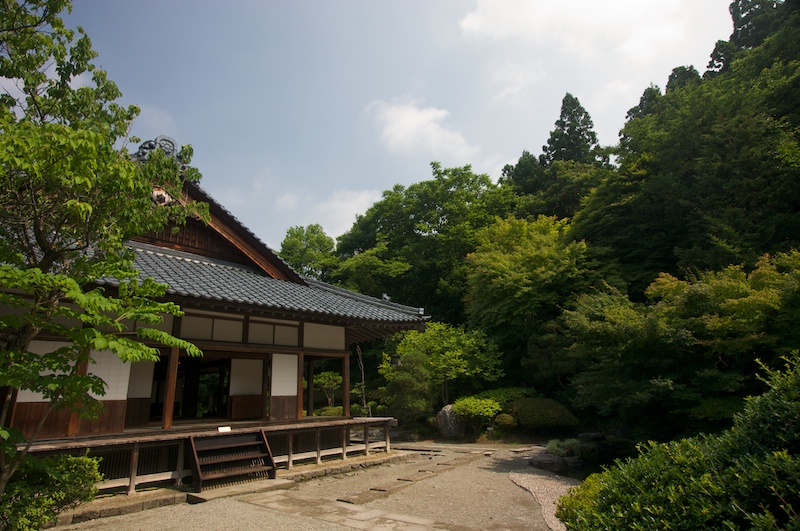
Innai-1 Higashiyamamachi Oaza Ishiyama, Aizu-Wakamatsu-shi, Fukushima-ken
TripAdvisor: http://www.tripadvisor.com/LocationPhotoDirectLink-g780850-d1423889-i87465433-Aizu_Old_Samurai_Residences-Aizuwakamatsu_Fukushima_Prefecture_Tohoku.html
8. Stay at Harataki
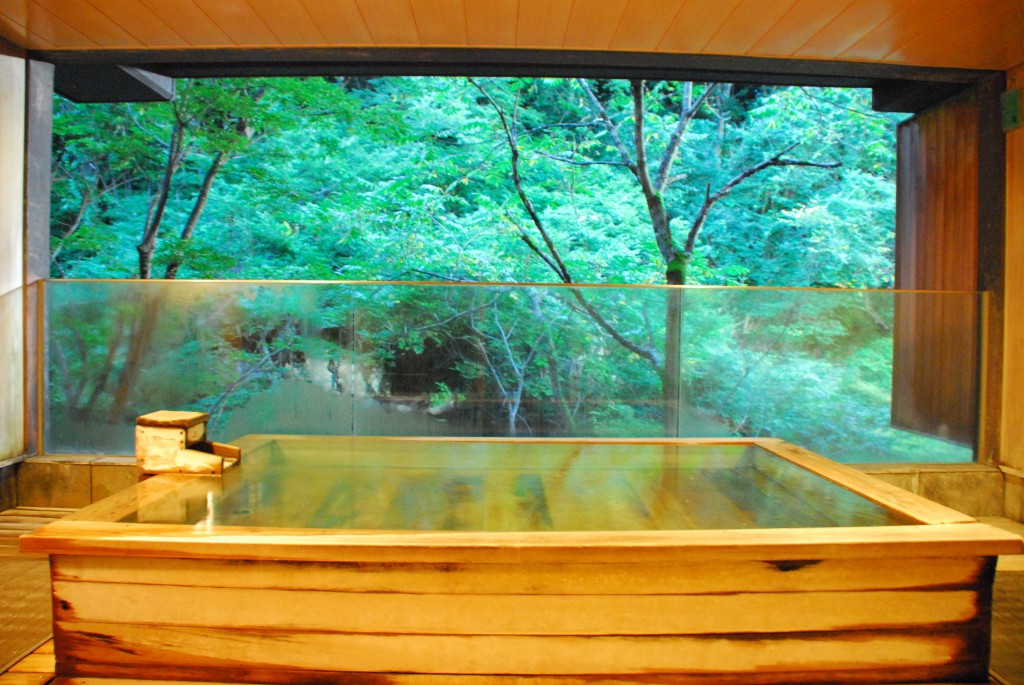
Higashiyama Onsen is a hot spring resort just east of downtown Aizu. While there are many ryokan and hotels in the area, Harataki is particularly great due to its facilities. There is a large public bath on the premises as well as 6 private open-air baths that you can rent for 50 minutes. They also offer entertainment options such as Go and mahjong boards, ping-pong, karaoke, a lounge, and yukata rental. They also have spa facilities.
Shimohara-235, Higashiyama-machi Oaza Yumoto, Aizu-Wakamatsu-shi, Fukushima-ken
Homepage (Japanese only): http://www.yumeguri.co.jp/
9. Eat at Kawadoko
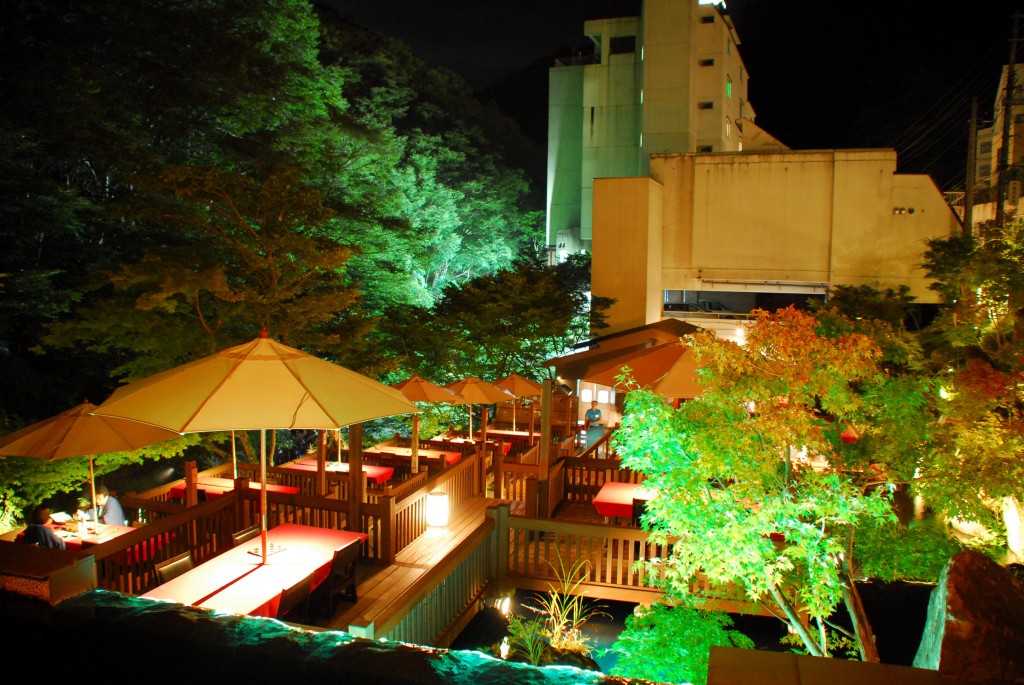
Kawadoko is an open-air restaurant run by Harataki that sits next to a river fed by a waterfall. In the evening the restaurant is lit up, giving it a perfectly cozy atmosphere. There is also a foot bath that you can enjoy while waiting for your meal. Many people go in their yukata after enjoying the baths at Harataki. Kawadoko offers fresh, delicious traditional meals. Lunch is available from April 28th to November 3rd, while dinner is available from April 28th to September 30th.
Homepage (Japanese-only): http://www.yumeguri.co.jp/kawadoko/
10. Visit the Sazae-do
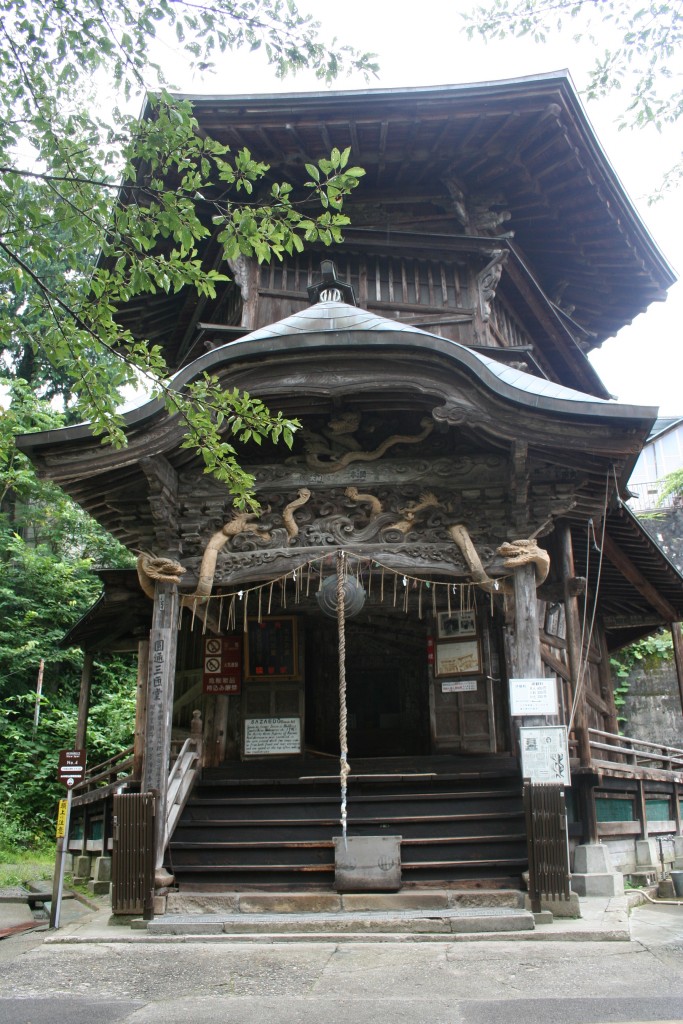
Halfway up Mt. Iimori, where the Byakkotai sleep, is a hexagonal temple called Entsu Sansodo but is more popularly known as the Sazae-do. "Sazae" is Japanese for turbo, a kind of shellfish, and the temple has earned that name due to its twisted exterior. The inside is also a twisted slope, making it a building with a double helix structure. It once held 33 statues of the Buddhist Kannon goddess of mercy, but the Meiji government removed all the statues from the premises after they passed a law abolishing Buddhism. The interior is covered in stickers that are actually graffiti from previous visitors. Entrance fee is 400 yen for adults, 300 yen for high school and college students, and 200 yen for children. It's said that Hayao Miyazaki took inspiration from the Sazae-do for the castle in Howl's Moving Castle.
Takizawa-166 Ikkimachi, Oaza Yahata, Aizu-Wakamatsu-shi, Fukushima-ken
Homepage (Japanese-only): http://www.geocities.jp/aizu_sazaedo/
11. Make your own phone strap out of wild grape tree bark at the Traditional Crafts Center
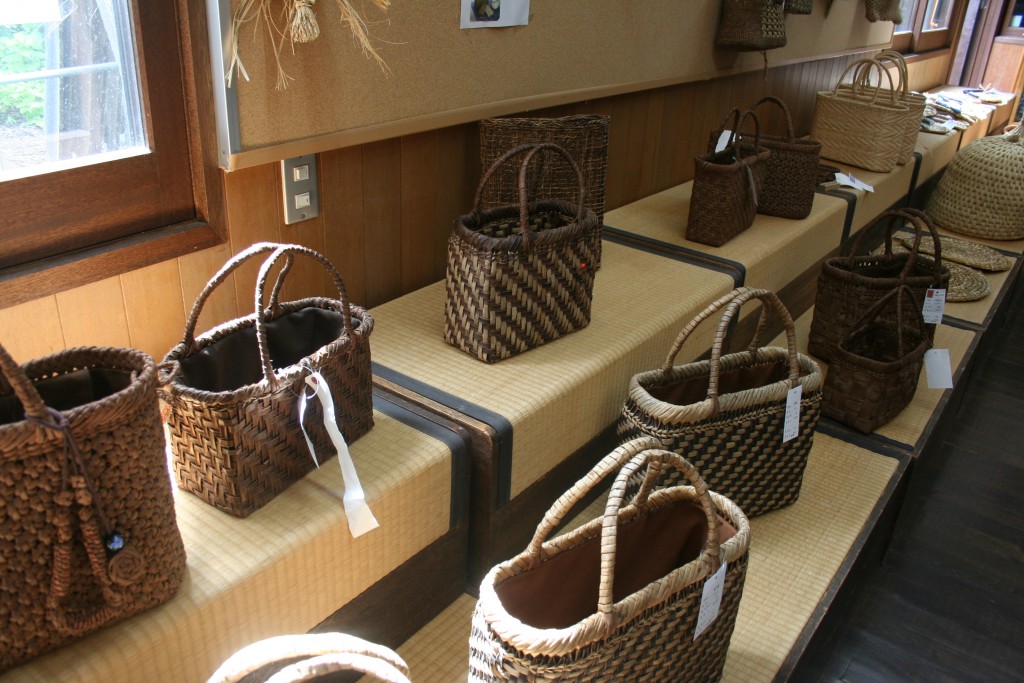
Because of the high amounts of snowfall that fall in Fukushima, farmers make items out of wild grape tree bark during the winter to support themselves. Because wild grape tree bark is very strong and only becomes stronger the more it's used, it's a prized material for purses and other kinds of bags. Wild grape tree bark can only be harvested two weeks out of the year in June. Because of the labor-intensive process and the rarity of the bark, items made out of this material can be very expensive, but it also comes with the guarantee that a craftsman will repair it if it does get damaged in any way. You can make your own phone strap out of this material for 700 yen. The Center also offers other craft trials, such as making coasters out of Japanese sedge.
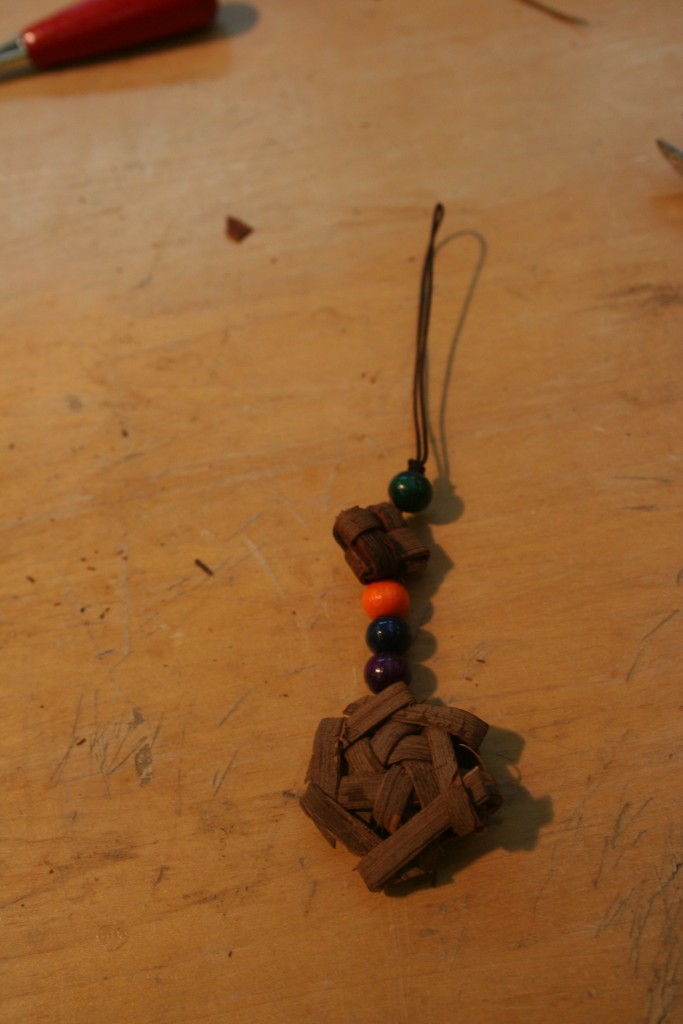
12. Eat at Donguri
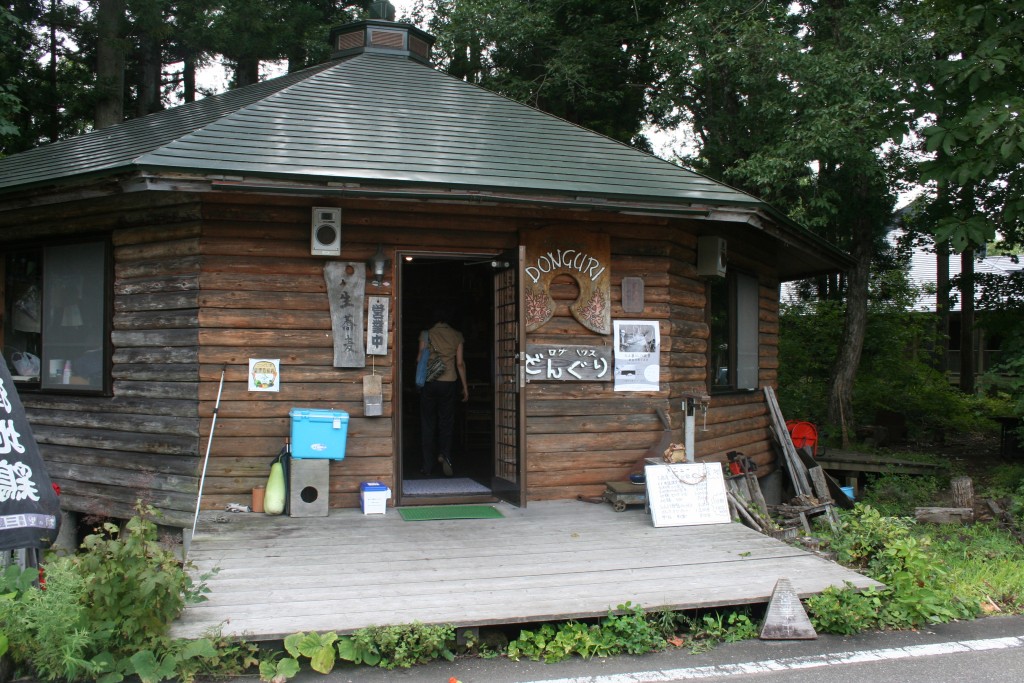
After you spend a full morning learning about all the traditional crafts created in the local area, head to Donguri for a hearty meal. The vegetables are all fresh and local, with many of them being from the restaurant's own garden. Its specialty is soba, so definitely give that a try. Teresa Teng once ate there in 1977 when she visited the area, so there are many photographs of her posted by the entrance.
Suwanoue-410, Nairi, Mishima-machi, Onuma-gun, Fukushima-ken
Information (Japanese-only): http://www.aizu-concierge.com/oku/map/spot/10779/
13. See items made from paulownia wood
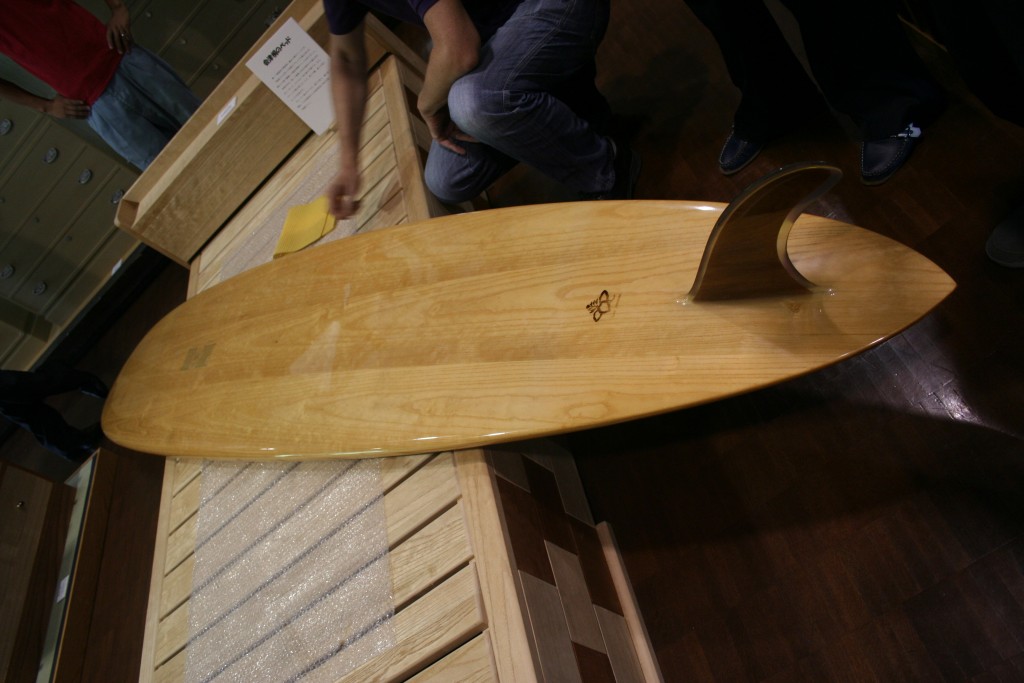
Paulownia wood is a material used to make traditional chests of drawers called tansu. It's a very meticulous process that requires skilled techniques by craftsmen. At Ozegaido Mishima-juku rest area, you can see not only tansu chests, but also beds, chairs, and experimental items made from paulownia wood. There is also a surfboard on display. A surfboard made from paulownia wood is said to be the Rolls Royce of surfboards due to its lightness and high quality.
Tenyabara-610 Kawai, Mishima-machi, Onuma-gun, Fukushima-ken
Homepage (Japanese-only): http://www.thr.mlit.go.jp/road/koutsu/Michi-no-Eki/fukusima/fu13.html
14. Wait for the train to pass over the Tadami River
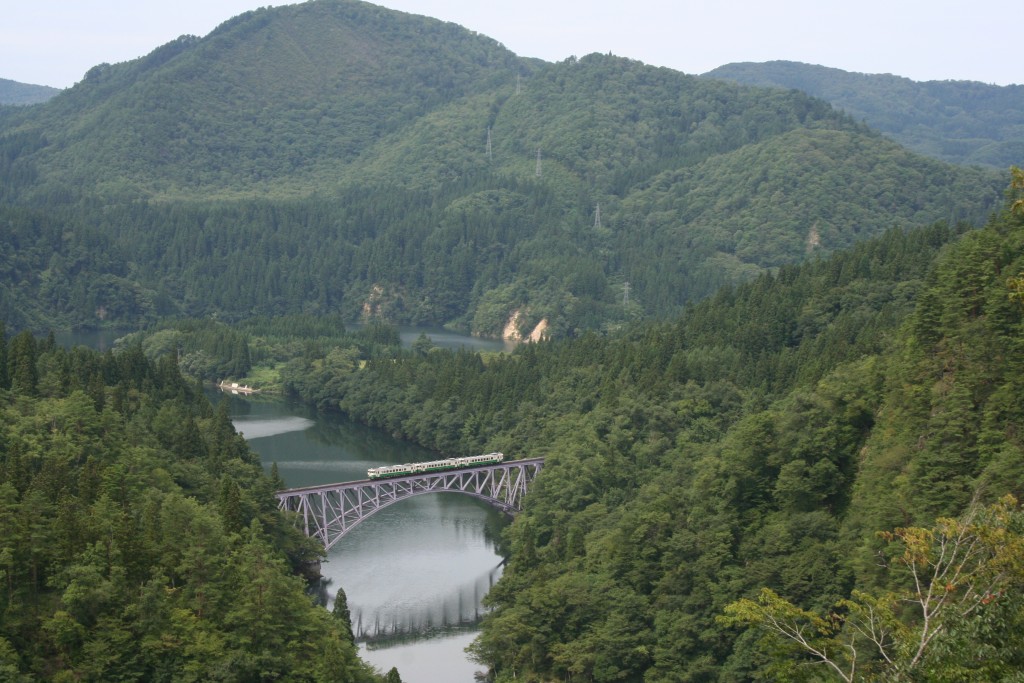
The view of the Tadami Line train passing over the lavender Daiichi Tadamigawa Kyourou bridge will make you understand the feelings of trainspotters. The bridge is painted the color of paulownia flowers, and the picturesque sight of the small train chugging along the rails will make you feel like you're watching a scene right out of a Ghibli movie. Walk from the Ozegaido Mishima-juku rest area to the mountains right nearby and hike about 10 minutes to reach the view point.
Information page (Japanese-only): http://dc-fukushima.jp/kanko/disp.html?id=2230
15. Weave your very own coaster
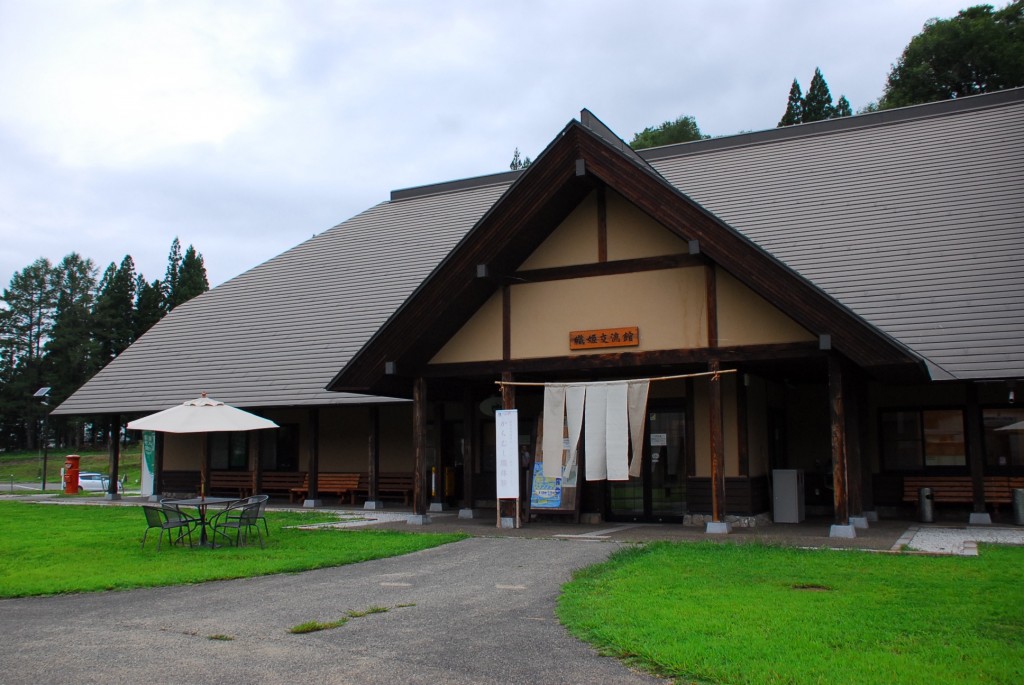
Photo from Hikaru Kamo .
At the Showamachi Karamushiori no Sato, you can learn about the traditional art of weaving using fibers made from the ramie plant and view pieces at the museum. There is a program here where they accept four applicants from around the country to work here as apprentices who learn how to weave from scratch. You can learn from one of these apprentices (women are called Orihime, men are called Hikoboshi from the Tanabata story) how to make your very own coaster using a loom for 1080 yen. Reservations are not required but are accepted.
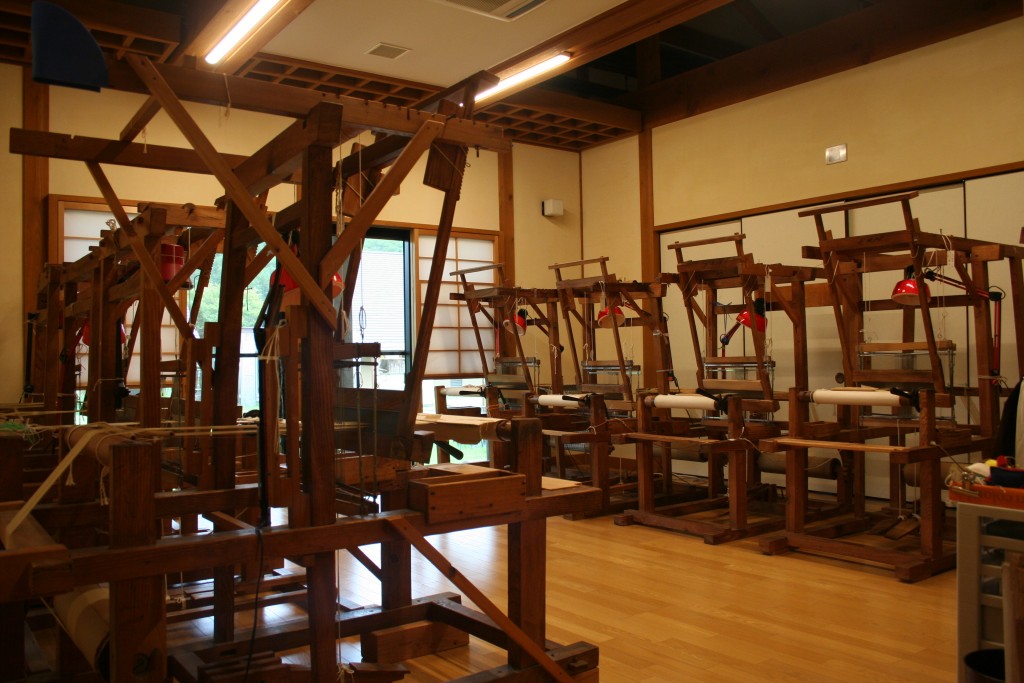
Uenohara-1 Sagura, Showamachi, Onuma-gun, Fukushima-ken
Homepage (Japanese-only): http://www.vill.showa.fukushima.jp/sato.stm
16. Enjoy the beautiful scenery from the Kaneyama Fureai Hiroba
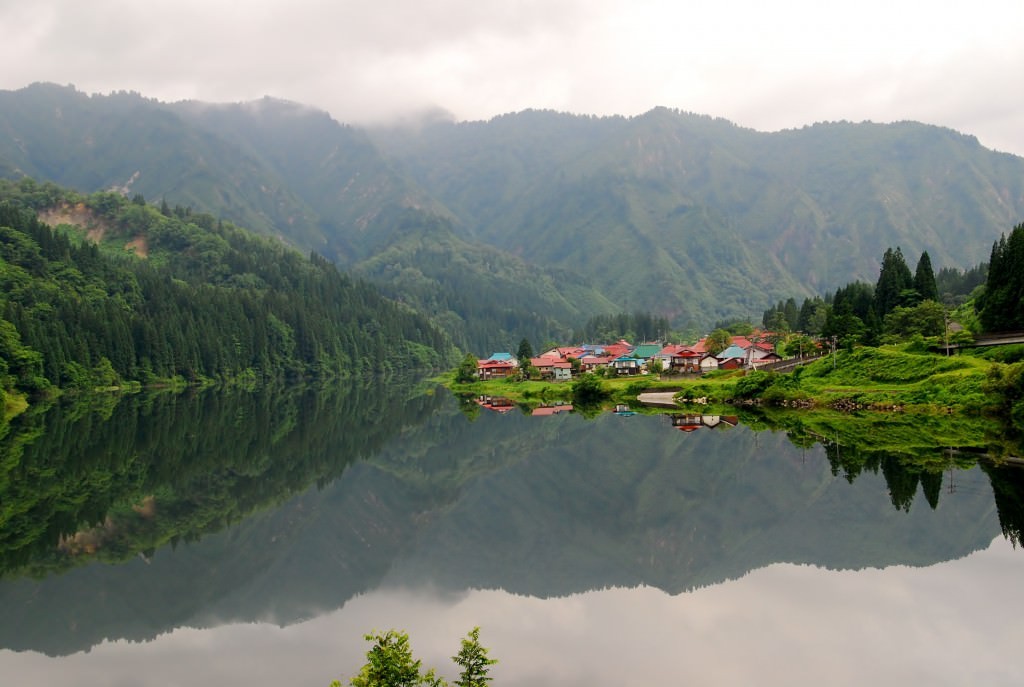
The Kaneyama Fureai Hiroba is a viewpoint on the side of the road where you can gaze out at the beautiful sight of the village of Oshi sitting on the very edge of the calm Tadami River. This is the same river that you saw from the mountain viewpoint, and if you're lucky, you might be able to catch another glimpse of the Tadami Line train running along the coast of the river heading towards Oshi. This viewpoint sits along the side of national highway 262 but if you take the train to Aizukawaguchi, you can walk to it.
Information (Japanese-only): http://www.pref.fukushima.lg.jp/uploaded/attachment/32651.pdf
17. Stay at Taki no Yu
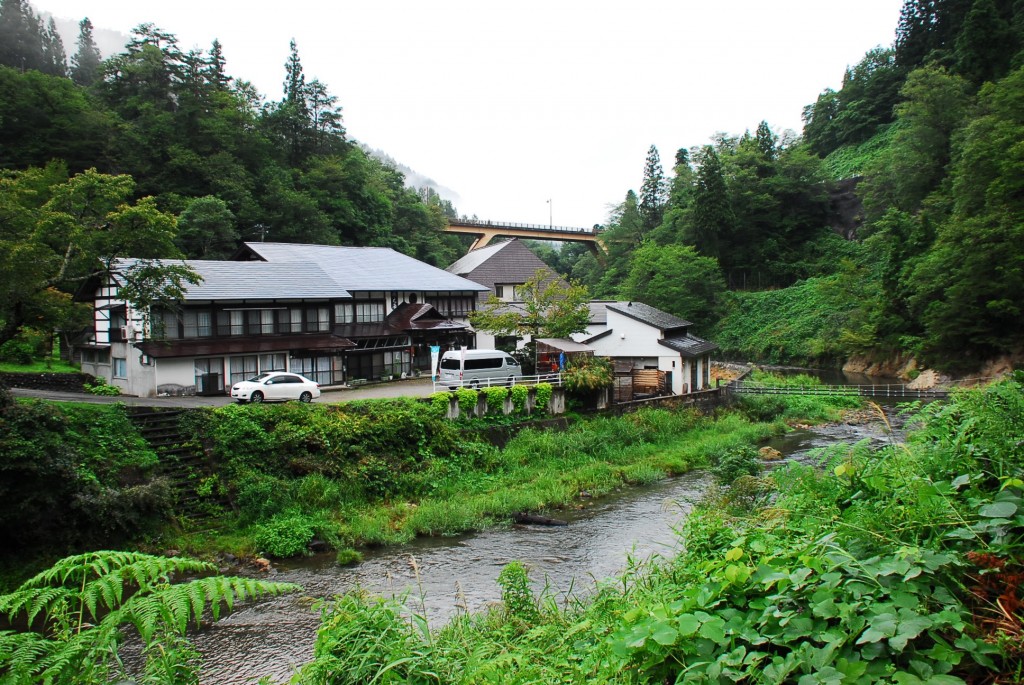
Nishiyama Onsen is another hot spring resort in Aizu, and the recommended ryokan to stay at is Taki no Yu. At Taki no Yu, there are two medium-sized baths as well as an open-air bath. You can go just for the day and enjoy the baths and a meal, or stay the night in a room with the view of river. They also offer skincare products made using the water of Nishiyama Onsen, which is known for its mineral properties that are good for your skin.
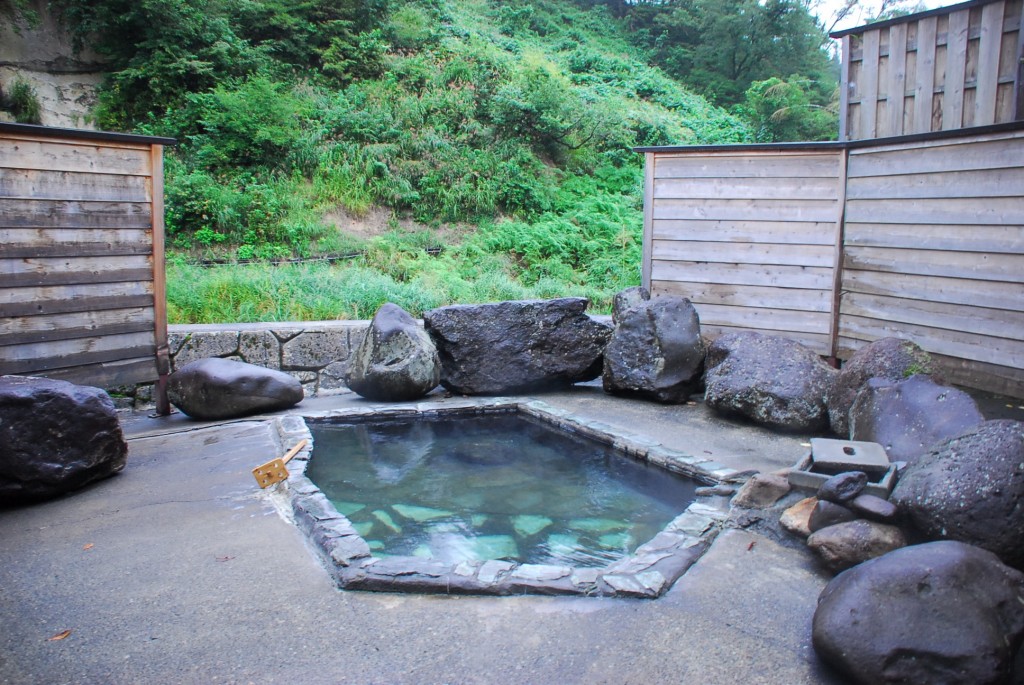
Nagasaka-829 Sunakohara, Yanaizu-machi, Kawanuma-gun, Fukushima-ken
Homepage (Japanese-only): http://www.takinoyu.info/
18. Enjoy Aizu wine
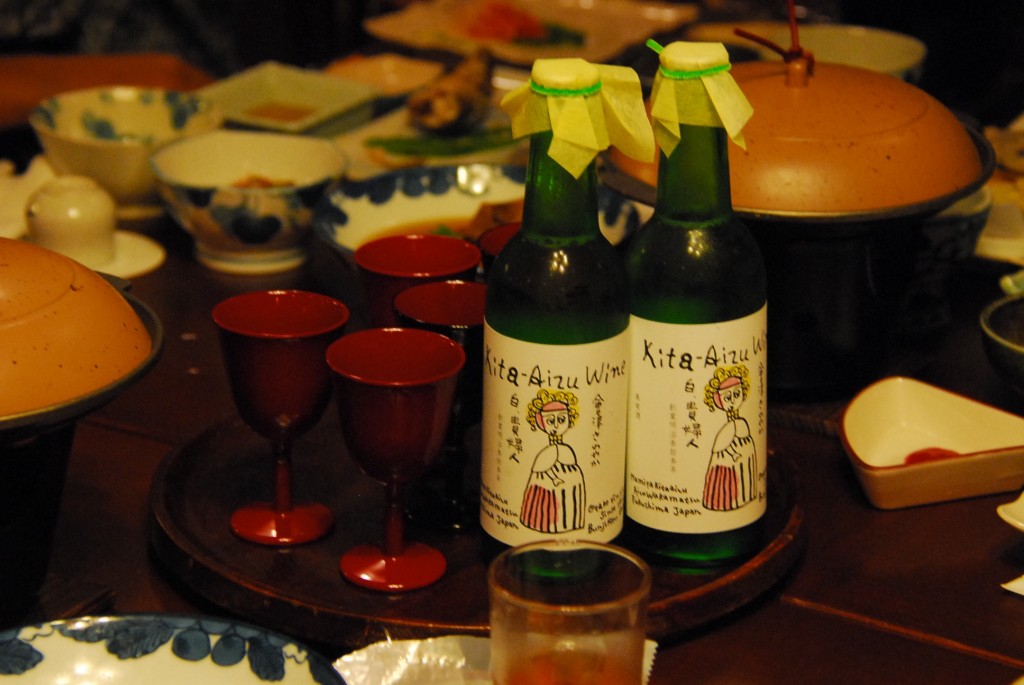
While you're at Taki no Yu, you can also enjoy Kita-Aizu wine with your meal. This wine is brewed at the Ootake Vineyard in Kita-Aizu and they've been brewing wine since the year 1900. There are red, white, and rose varieties. When people think of Japanese liquors, very rarely does wine come up; try it while you have the chance.
19. Have a sake tasting at Suehiro Brewery
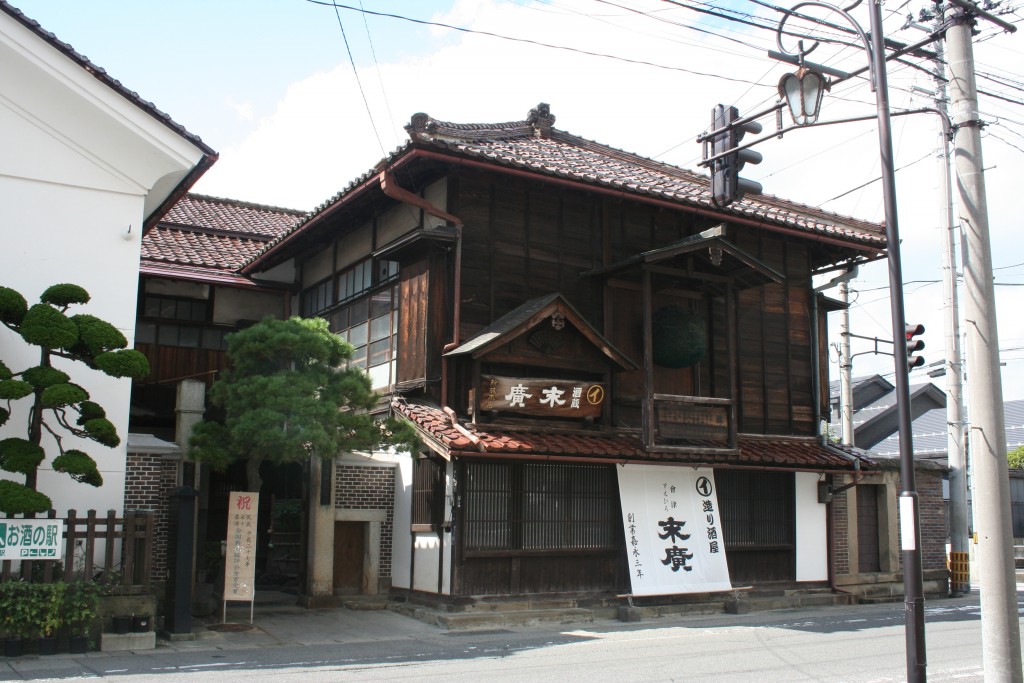
Suehiro Brewery is one of the largest and most famous breweries in the Tohoku region. It is a family-owned brewery started in 1850 and is on its eighth generation. They offer tours every 30 minutes from 9AM to 4:30PM, and you can take a tour without a reservation unless it's a group of more than 10 people. There is also a cafe that offers original sake-infused recipes that are designed by the owner's wife. Occasionally they host events like small concerts as well. If you buy more than 5000 yen worth, then shipping is free.
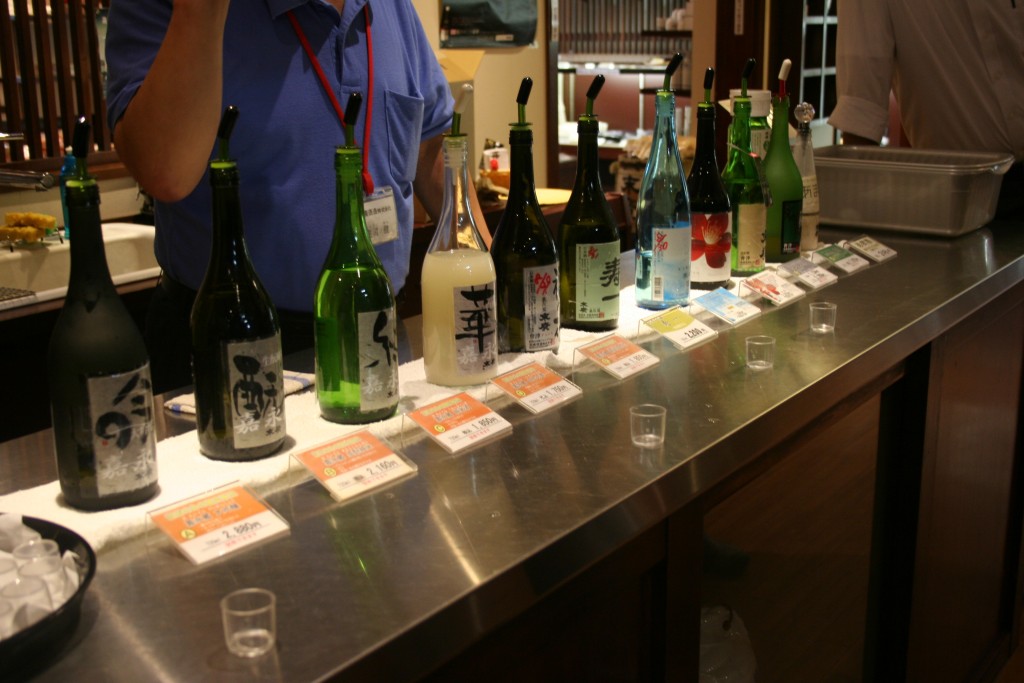
12-38 Nisshinmachi, Aizu-Wakamatsu-shi, Fukushima-ken
Homepage (Japanese-only): http://www.sake-suehiro.jp/top.html
20. Stay at Tokyu Hotel Grand Deco
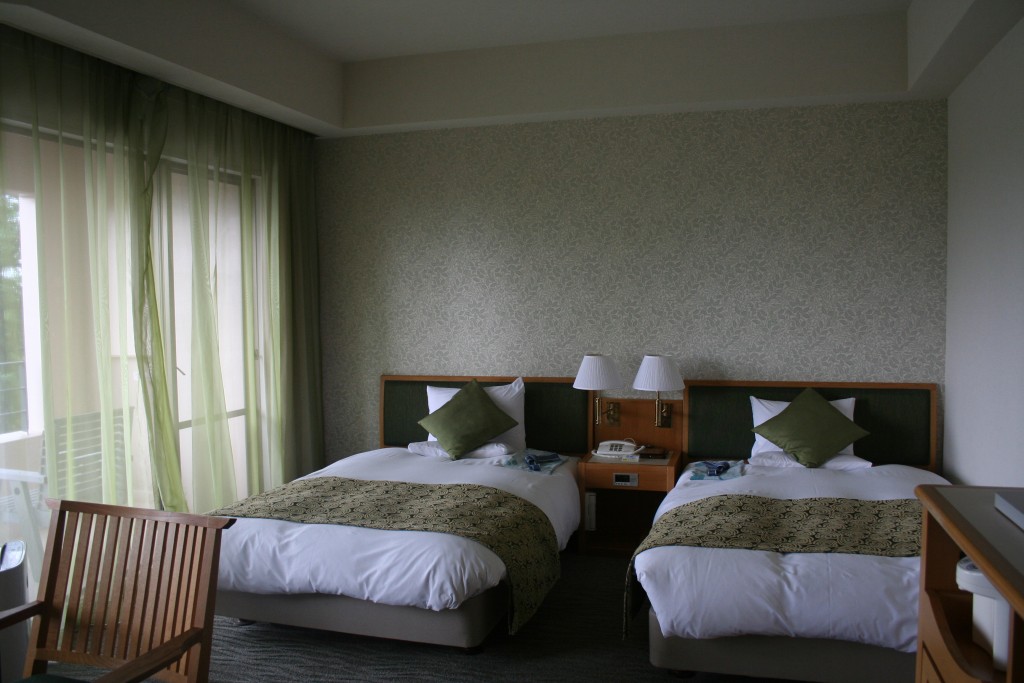
The Hotel Grand Deco is popular especially in the winter for its ski facilities, but it's beautiful throughout the whole year thanks to its verdant facilities situated in the mountains. The fall foliage is a treat for the eyes, the spring blooms are beautiful, and in the summer you can walk to the waterfalls to cool down. On top of skiing, you can rent items for sports such as golf clubs or tennis rackets. Many people also get married here, even in the winter, so you might be able to catch the sight of a wedding party in the snow!
Arasunasawayama Hibara, Kitashiobara, Yama-gun, Fukushima-ken
Homepage: http://www.grandeco.com/english/
21. Go canoeing and camping in Matsubara
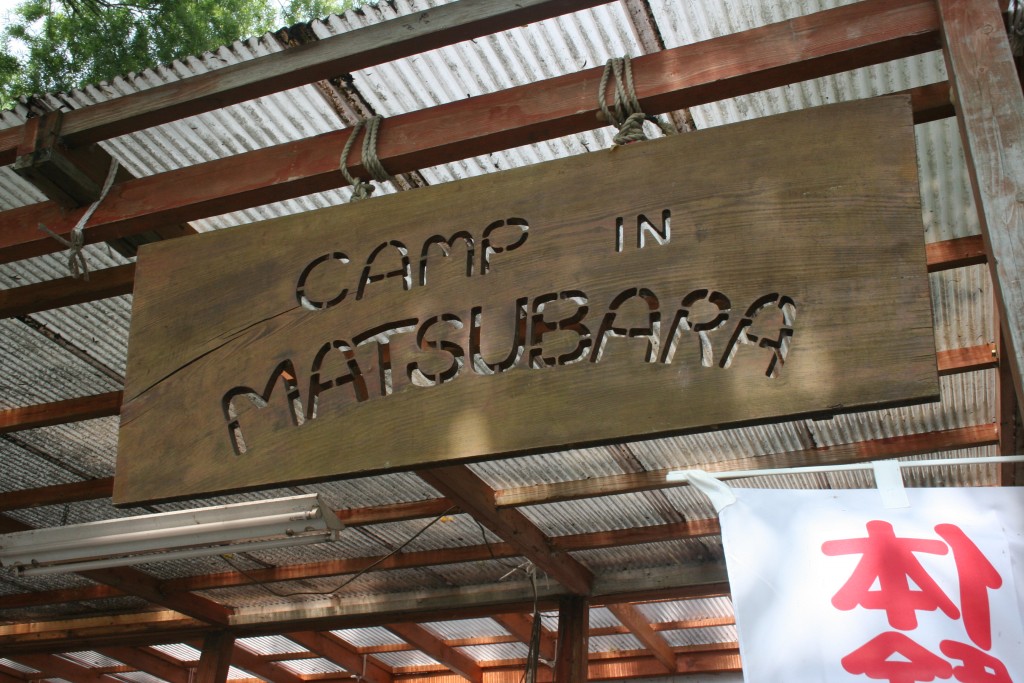
Matsubara is a camping area by Mt. Bandai that's open all year. In the warmer months, you can canoe, swim, fish, kayak, make a raft, and ride a mountain bike around the rough terrain. In the winter months, you can go ice fishing on the lake! Many of the plans come with a steak barbecue dinner included. If overnight camping's not your thing, you can simply go for the day for a fun few hours.
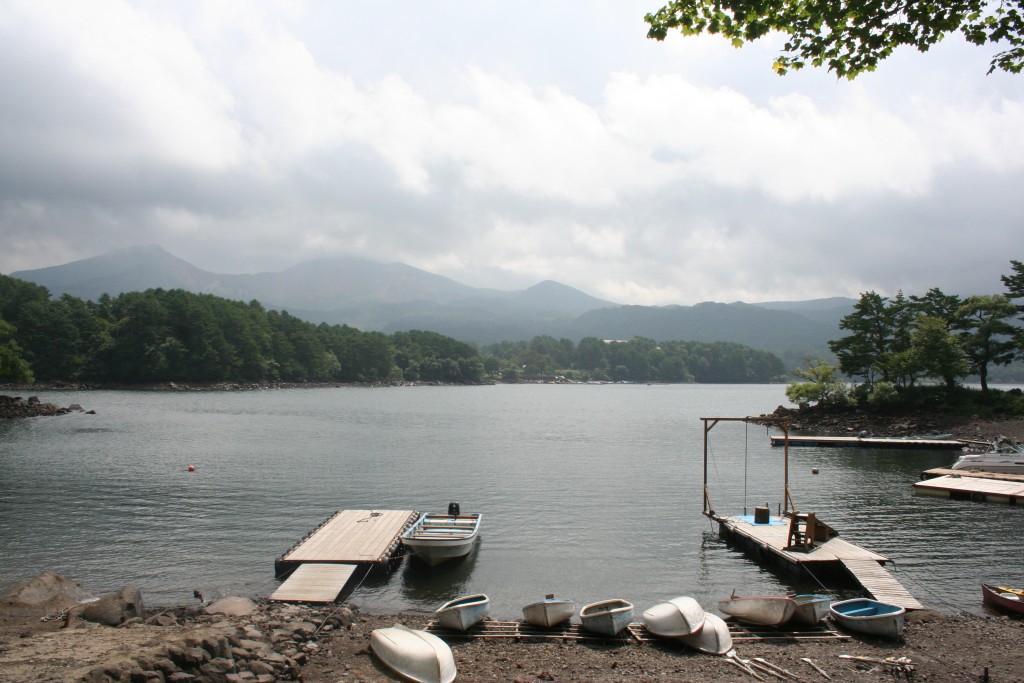
Kengamine-1093 Hibara, Kitashiobara, Yama-gun, Fukushima-ken
http://www13.plala.or.jp/hibarako/index.html
22. Check out the Goshiki-numa
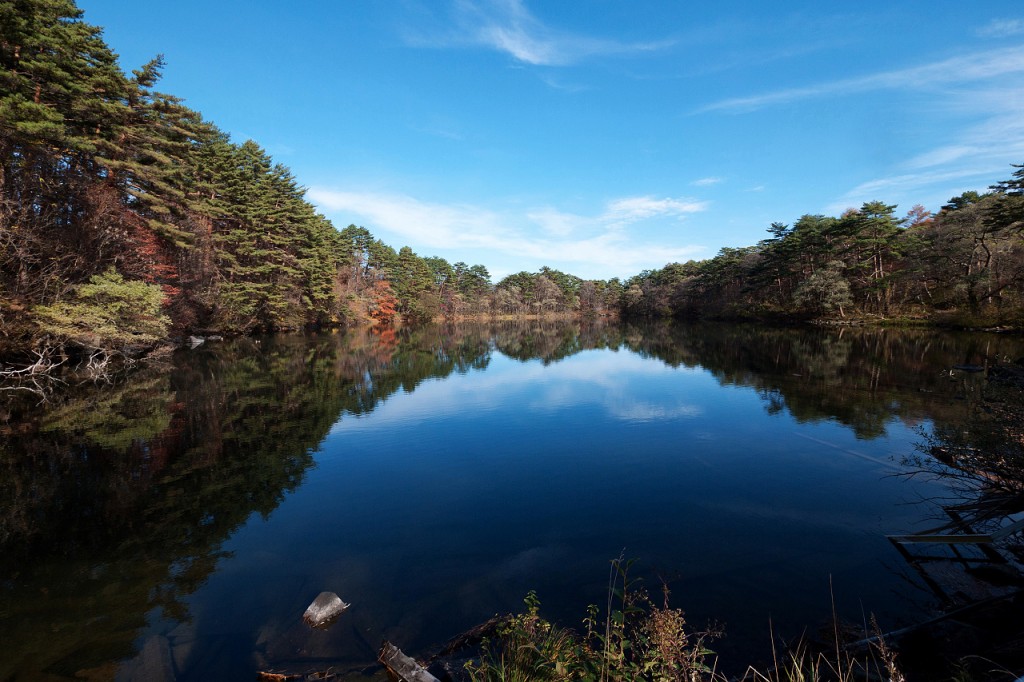
The Goshiki-numa are a cluster of five volcanic lakes at the foot of Mt. Bandai that each have a unique color due to the mineral deposits in the water. The colors can change depending on time of year and the weather. There is a walking trail of about 4km that allows people to see every lake and it's rather popular when the weather is nice. You can also row in the lakes, something that is particularly popular with couples. There is a fish in the lake that has a heart-shaped mark on its side; it's said that if you see this fish, your love will last forever. Try to look for it!
Kengamine, Hibaraaza, Oaza , Yama-gun, Kitashiobara-mura, Fukushima-ken
http://www.jnto.go.jp/eng/location/regional/fukushima/urabandai.html
Many of these activities require a car, and it may be difficult to do some of these things if you don't speak Japanese. If you're interested, there are plans and tours that include both transportation and a bilingual guide that will take you around the Aizu area for a fun 3-night 2-day tour!
The Power of Water tour highlights the bounty that clean water brings by focusing on sake breweries and onsen, as well as traditional crafts. For more details, click the below link
The Power of Water tour
This tour gives you transportation and a guide for the first day but gives you your second day to walk around freely and create your own memories. For more details, click the below link.
Enjoy the history and traditions of beautiful region with delicious food and liquor and relaxing baths while you're in Japan!

The information in this article is accurate at the time of publication.
tsunagu Japan Newsletter
Subscribe to our free newsletter and we'll show you the best Japan has to offer!

About the author
Related Articles
Related interests.
- Otaru canal
- Umeda sky building
- Rainbow bridge
- Tokyo skytree
- Tokyo tower
- Imperial Palace
- World heritage sites
Restaurant Search
Subscribe to the tsunagu Japan Newsletter
Sign up to our free newsletter to discover the best Japan has to offer.
Connect with Japan through tsunagu Japan
Let us introduce you to the best of Japan through our free newsletter: sightseeing spots, delicious food, deep culture, best places to stay, and more!
Aizu Wakamatsu Japan – All Our Travel Tips To Visit The Samurai City

Aizu Wakamatsu is a former castle town located in the Fukushima Prefecture with a long and eventful history. Nowadays, it brings in tourists in droves due to its wonderful variety of local landmarks and attractions that highlight its history (which is entangled with samurais!) as well as reputation for producing award-winning sake.
During the Boshin War in the mid-1800s, Aizu-Wakamatsu actually became the very last stronghold for the last samurais battling the Meiji government reign. You will get to witness many aspects of samurai lifestyle in this region, something that we think will appeal to many people of the masses.
The region itself is surrounded by many mountains, and thus hiking and skiing are popular activities during the appropriate months because not only do you get to do what you love, but to do so whilst being surrounded by the epic scenery around here will make all your friends and family absolutely envious.
How To Get To Aizu Wakamatsu
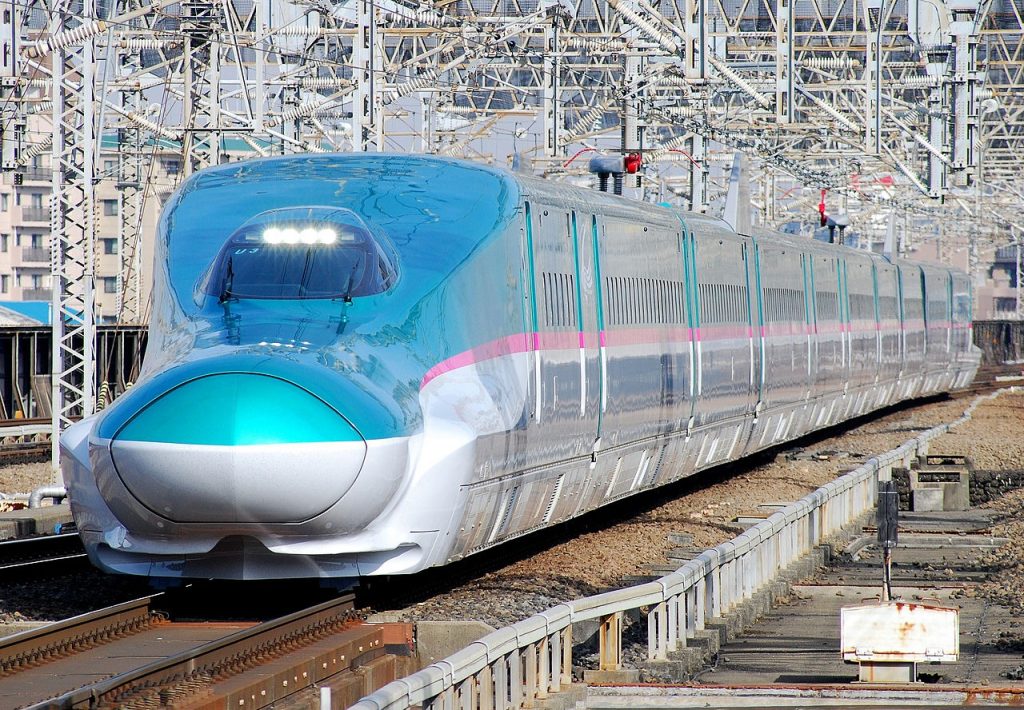
From Tokyp, take the JR Tohoku Shinkansen to Koriyama Station, and then transfer to the JR Banetsu-sai Line for Aizu Wakamatsu. It will take approximately three hours and cost 9,000 yen. If you have a JR Pass , this entire trip will be covered. For itineraries and timetables, check out Hyperdia website .
If you’re looking to save some money, there are buses that operate between Tokyo and Aizu Wakamatsu Station. The trip will take 4.5 hours and cost roughly 4,800 yen one-way. You can book it at kosokubus .
Where To Stay in Aizu Wakamatsu
Guesthouse in aizu wakamatsu – kakurega guest house.
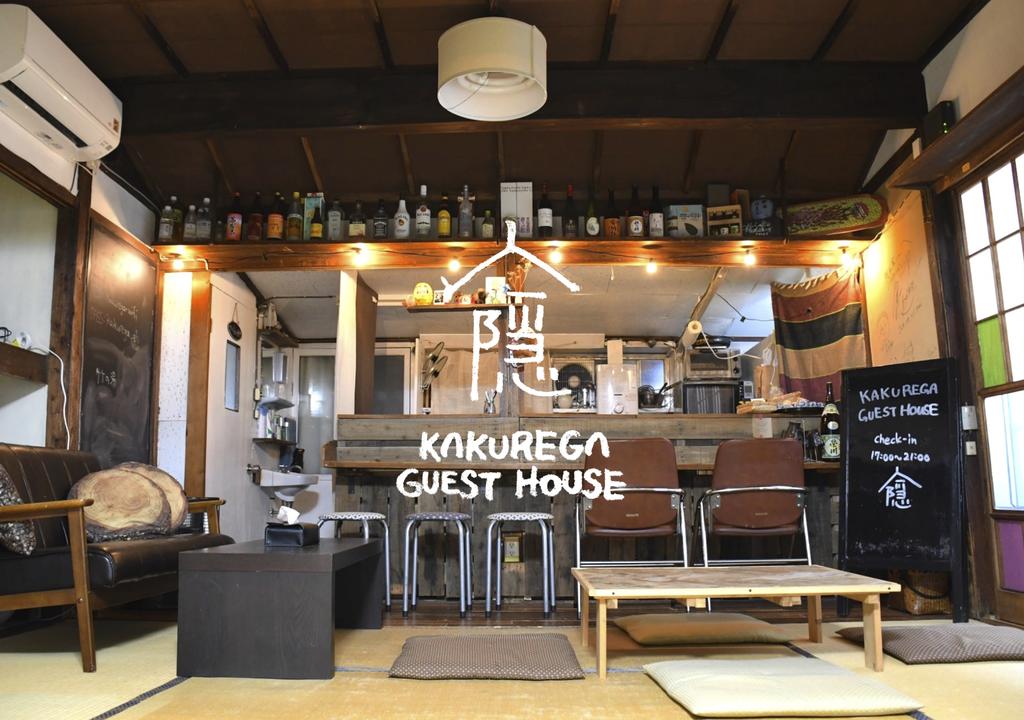
This quaint and humble guest house is exactly what you’re after if you’re looking for a no-frills accommodation that provides all the basics for a comfortable stay at an extremely affordable price. It features some spacious guest and dorm rooms, a cosy common area for lounging around with a bar, and free Wi-Fi throughout.
There is also a family room if you’re looking to book for a few people and want some privacy. The location is great, and will allow you to visit all the major attractions quite easily.
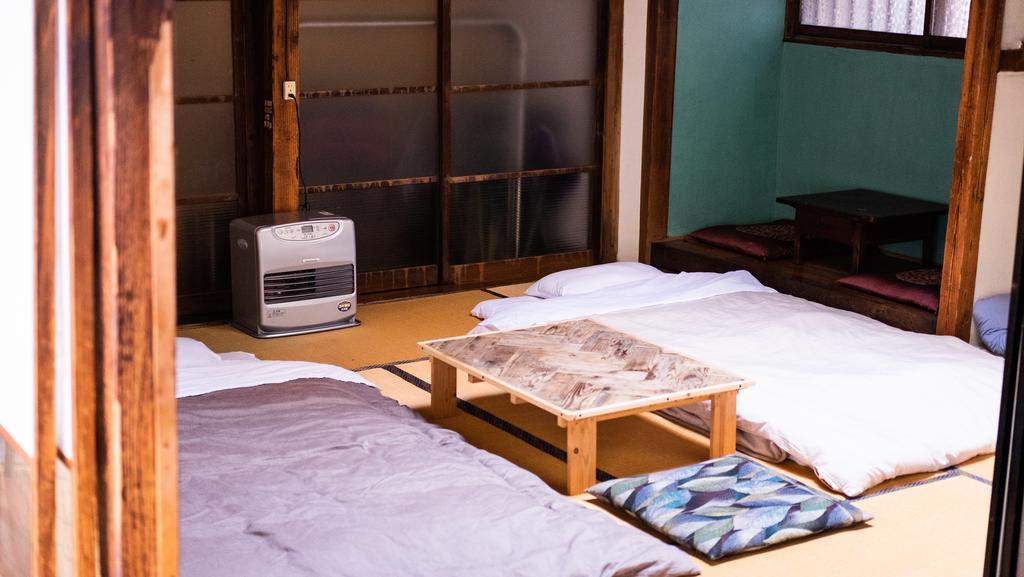
Guest Tips : If you’re interested in getting to know more about the local sake, the host is your guy – simply ask the questions! To get to the place, know that it’s actually at the end of an alley that’s just off the main road opposite a 7-11 convenience store.
Book It Now : Kakurega Guest House
Ryokan in Aizu Wakamatsu – Tagoto
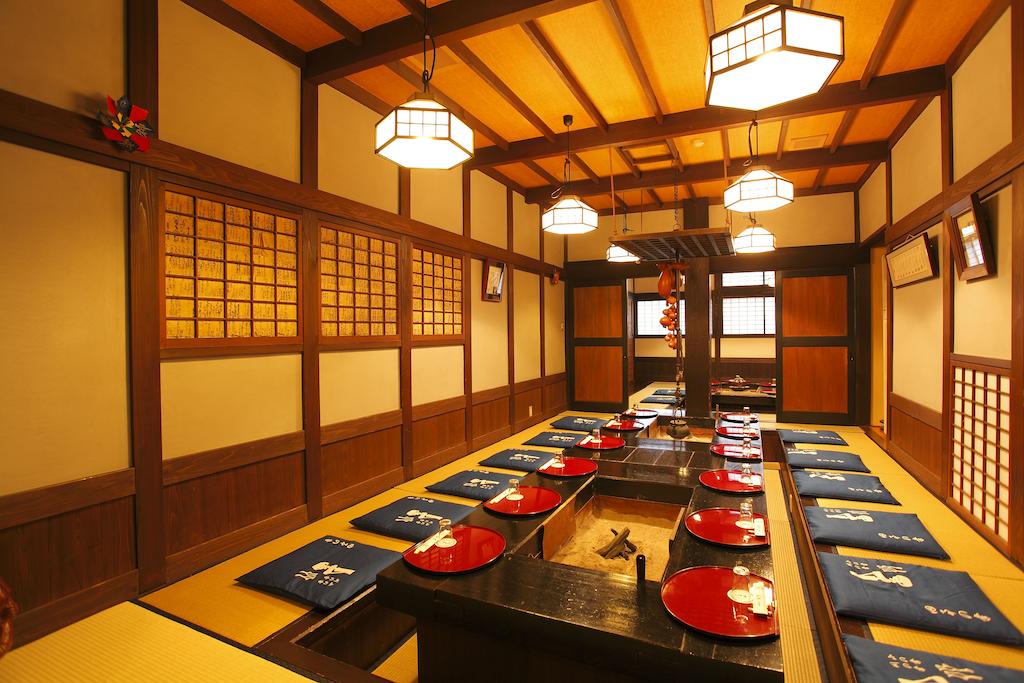
If there were ever a ryokan that suited the atmospheric nostalgia of this ancient city perfectly, it would be Tagoto Ryokan. It’s one of the best sellers in Aizu Wakamatsu, and for good reason. It is very traditional in the sense of tatami mat floors, traditional futon bedding, delicious kaiseki meals served with fresh local ingredients, and with a wonderful onsen onsite. However, for those after a bit of familiarity, western bedding choices are also provided.
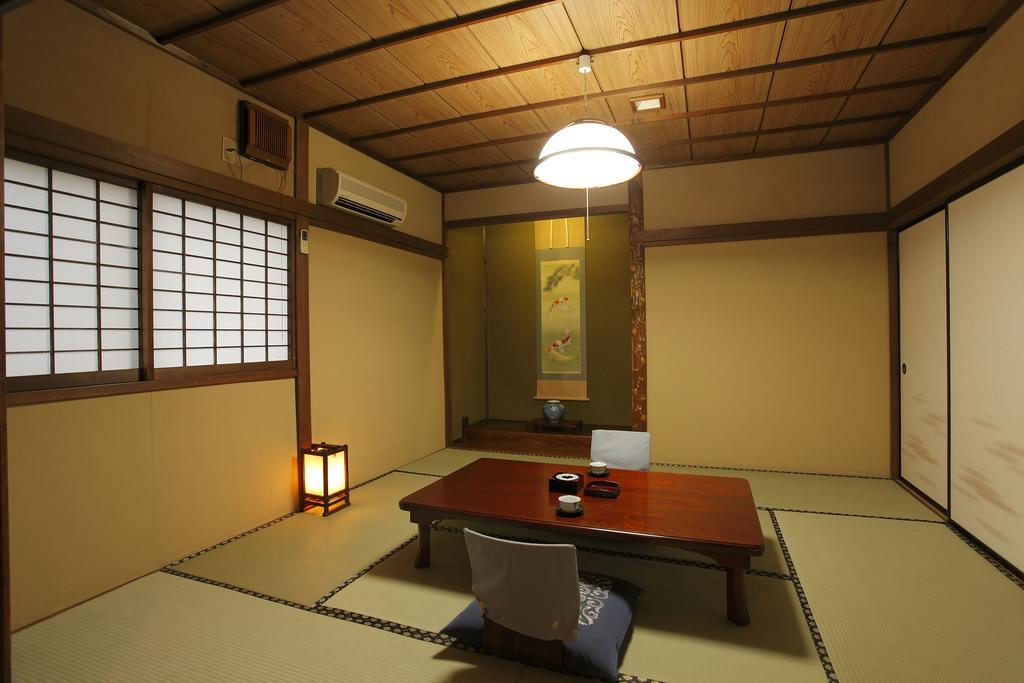
Guest Tips : There are plenty of restaurants around the accommodation so you don’t have to worry if you miss dinner, however, breakfast is served in the most traditional style and is delicious so that is highly recommended.
Book It Now : Tagoto
Ryokan in Aizu Wakamatsu – Kutsurogijyuku Chiyotaki
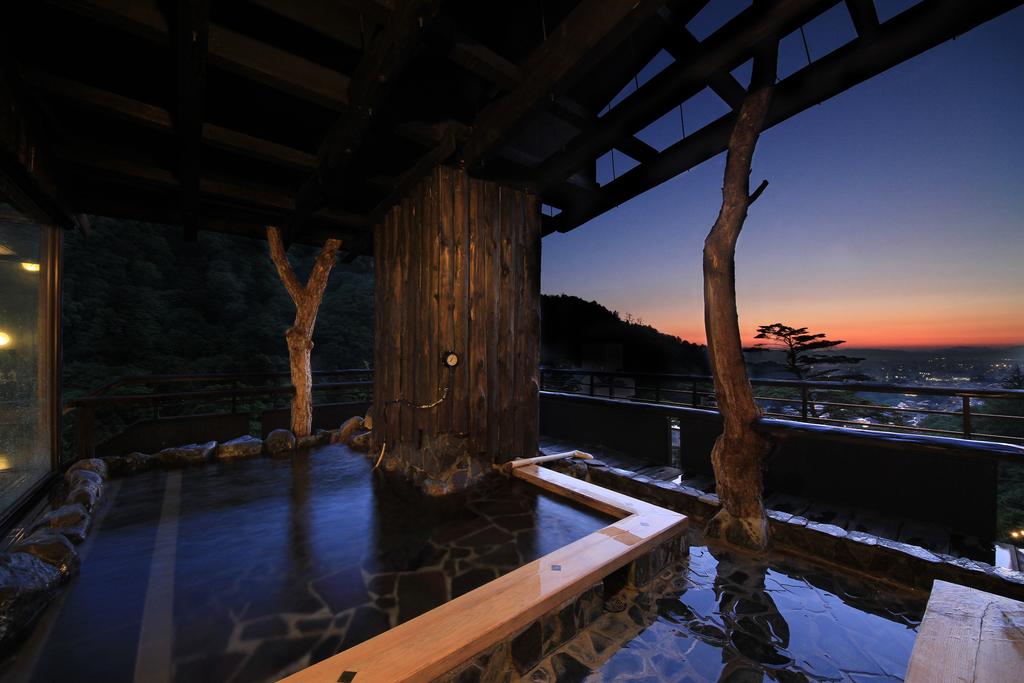
This wonderful traditional ryokan boasts superb mountain views from its onsen – which is reason enough to book it! Kutsurogijyuju Chiyotaki is only a 15-minute bus ride from the station, but it actually feels like it’s miles away.
The large guest rooms boast serene views, the onsite restaurant offers lip-smacking food, and the private onsen baths are just glorious. Make sure you make a reservation! If you’re staying in, there is a sake bar that will open up at night, and dinner is a wonderful premium-grade buffet full of delicious local ingredients.
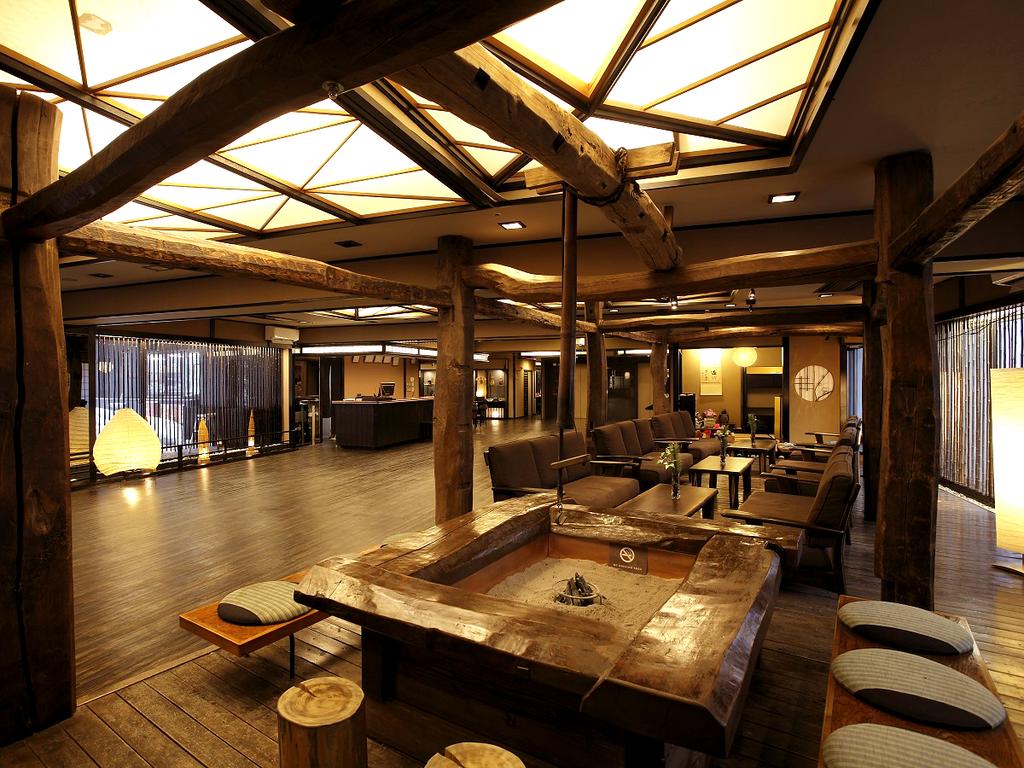
Guest Tips : Both onsen provide great views, but the one on the 10th floor is probably better. If you’re worried about space, the guest rooms are huge so you’re covered.
Book It Now : Kutsurogijyuku Chiyotaki
The Best Restaurants in Aizu Wakamatsu
Fukunishi honten.
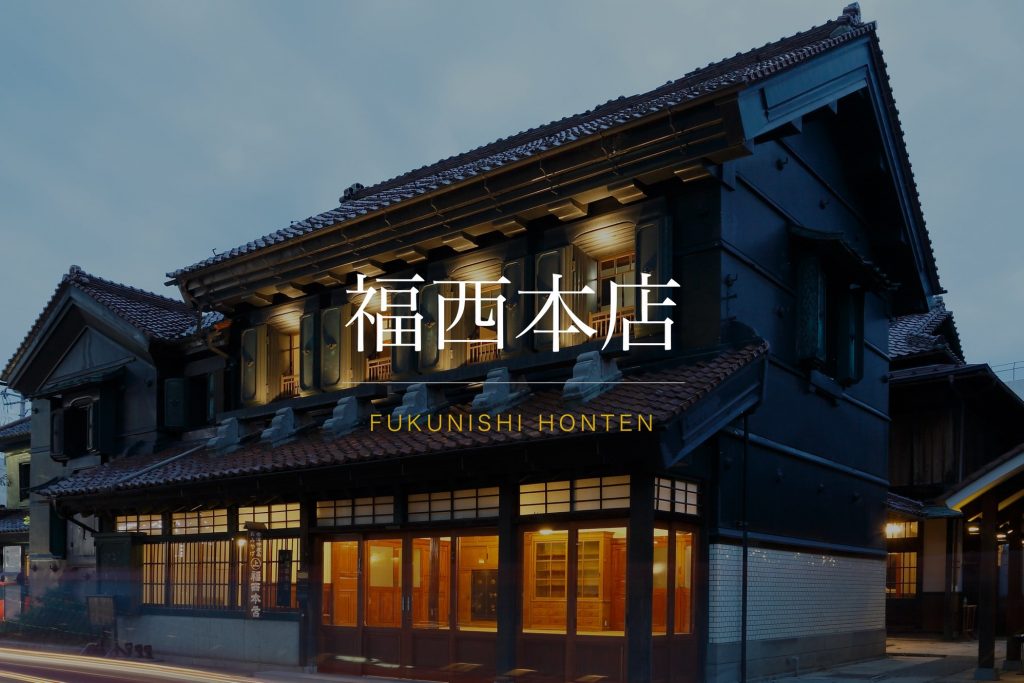
This restaurant offers delicious seasonal dishes that are charcoal-grilled to perfection. If you’re a fan of that delicious smoky aroma wafting through your nose, then this is the place to visit. The charcoal-grilling process here is quite unique: the ingredients are popped on a right and grilled right in front of you! Not many additional flavour and spices are used, so what you’re eating will be honest and authentic. A popular dish is the Fukudori chicken and fresh fish.
- Address : 4-16 Nakamachi, Aizuwakamatsu, Fukushima 965-0878, Japan
- Access : From Aizu Wakamatsu Station, it is a 20-minute walk.
- Hours : 5:00pm – 11:00pm ( closed Mondays )
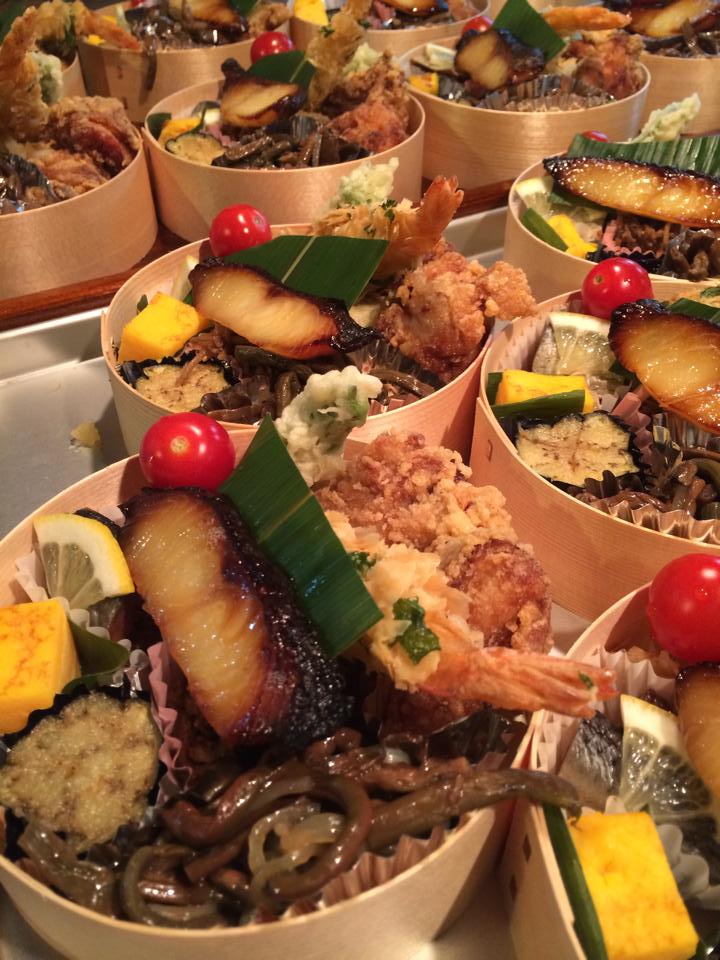
Takino is a restaurant in Aizu Wakamatsu that sells the age-old Wappaeshi, a wooden lunch box that long ago was created specifically for people working in the mountains. This wooden box normally holds a serving of steamed rice alongside a variety of other toppings made with fresh seasonal ingredients.
- Address 5-31 Sakaemachi, Aizuwakamatsu, Fukushima 965-0871, Japan
- Access : You can catch a taxi from Aizu Wakamatsu Station for 15-minutes, otherwise you can catch a bus to Haikara-San “Shiyakushomae” bus stop and walk a few minutes.
- Hours : 11:00am – 3:00pm, 5:00pm – 10:00pm
- Price : from 1,470 yen
The 8 Best Things To Do in Aizu Wakamatsu
Here is our selection of the places we recommend you to visit in Aizu Wakamatsu:
- Hanitsu Shrine Honden
- Aizu Hanko Nisshin-kan
- Oyakuen Garden
- Aizu Bukeyashiki
- Aizu Wakamatsu Castle (Tsuruga Castle)
- Iimoriyama Hill
1. Hanitsu Shrine Honden
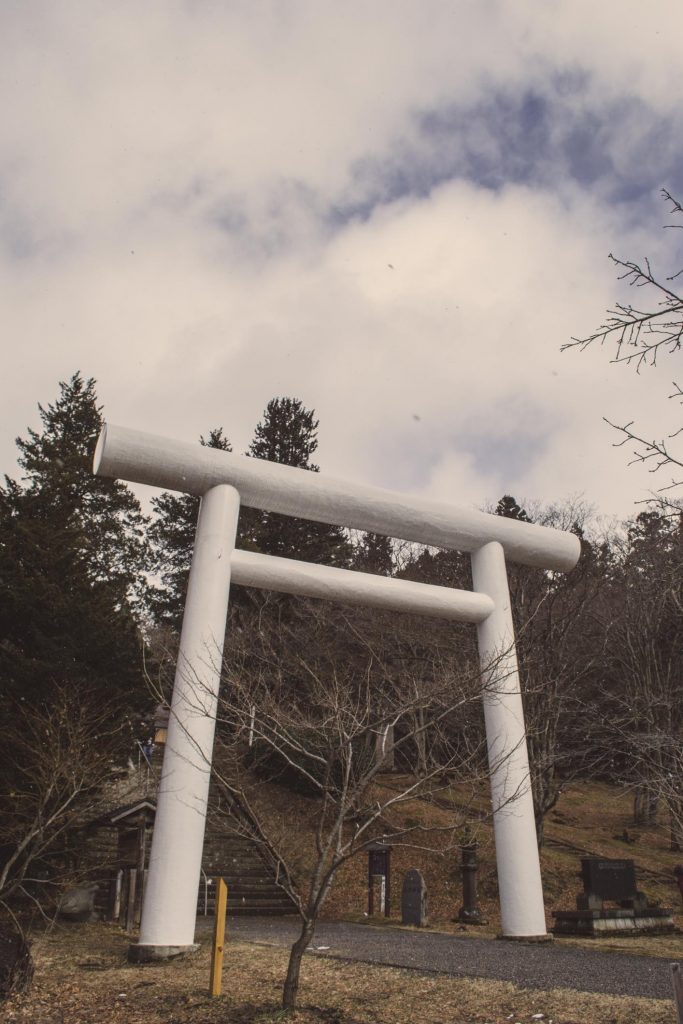
The mystic ancient Hanitsu Shrine Honden was built many years ago to honour Hoshina Masayuki, the first lord of the Aizu Clan. This is historically significant because it was he who upheld utmost devotion to the Tokugawa Shogunate and led his people to do the same, even during the period of civil war.
As Aizu Wakamatsu was the last stronghold during the war, Hoshina’s loyalty spread across the land and earned him respect from those who held the same beliefs.
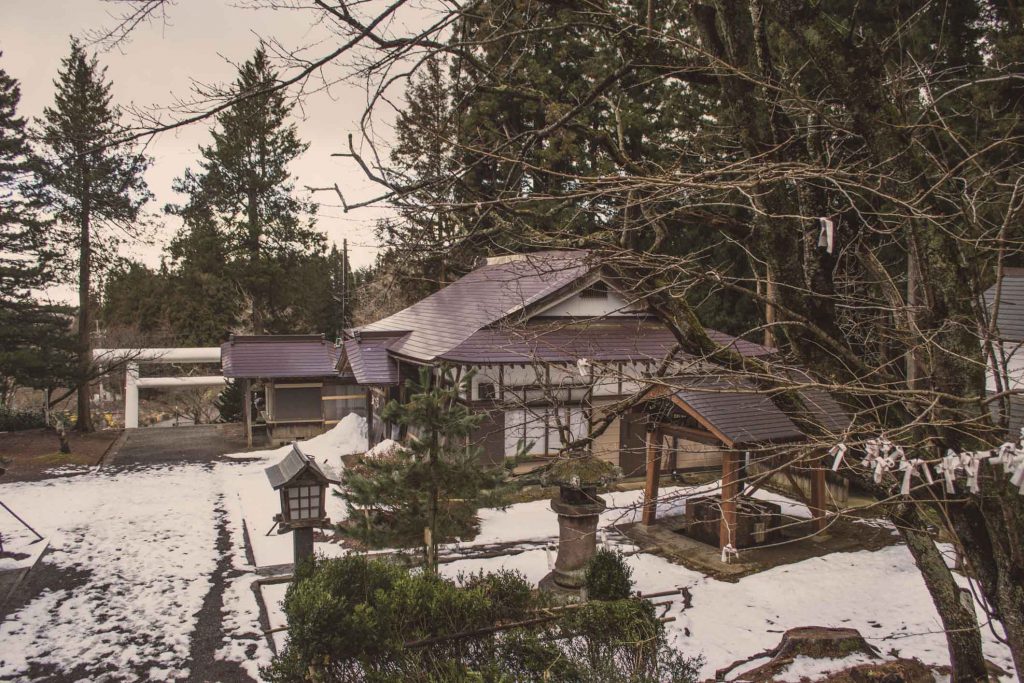
When you visit this shrine, you will get to witness the Kame-shi, which is considered one of the largest stone monuments across all of Japan, a distinct white torii gate, graveyard for the Matsudaira Clan which has now been designated as a National Historic Site, and, during the autumn koyo season, you will get to experience some of the most beautiful foliage scenery in your life. The shrine also hosts a wonderful autumn foliage festival as well.
- Address : Japan, 〒969-3102 Fukushima, Yama District, Inawashiro, Mineyama
- Access : From Haikara-san/Akabe “Innai” bus stop, it is a 5-minute walk.
- Time : 8:00am – 5:00pm
2. Aizu Hanko Nisshin-kan
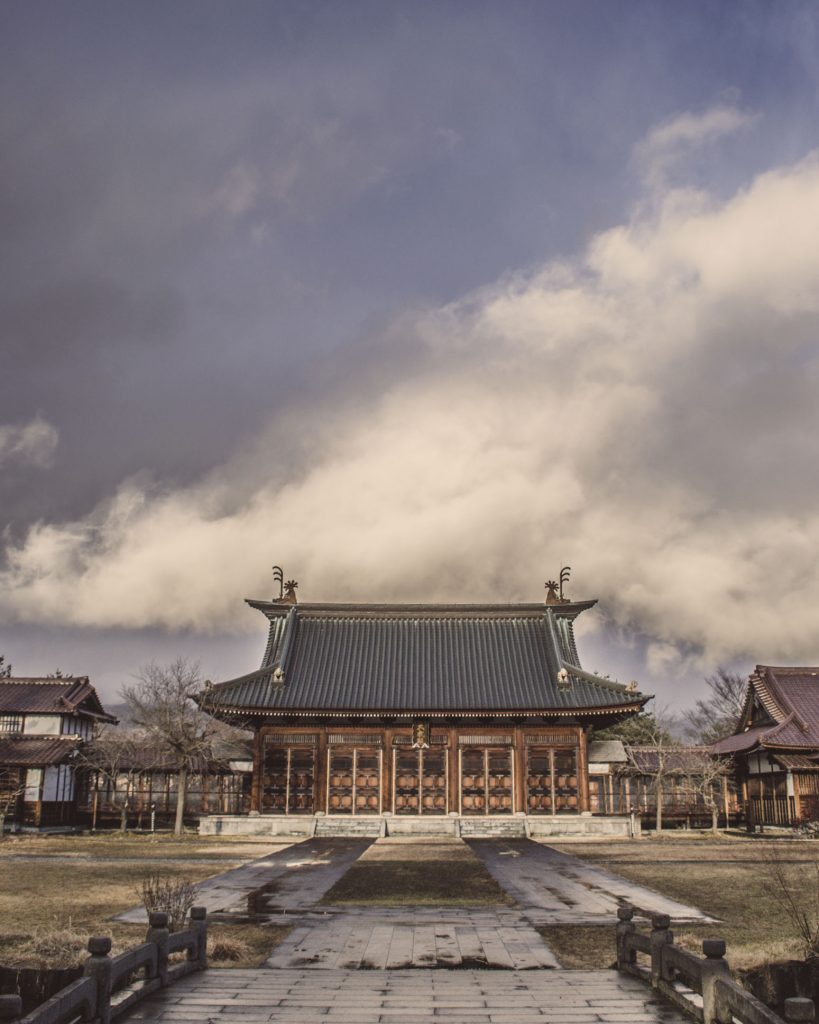
The Aizu Hanko Nisshin-kan is a Samurai school that was considered the best educational institution in all of Japan back in the early 19th century. During this period, Japan was experiencing high levels of famine, and so the Aizu clan established this school to save the future of the clan. Unfortunately, the original structure was burnt down during the great Boshin War, but it was reconstructed during the late 1980s to replicate its original form.
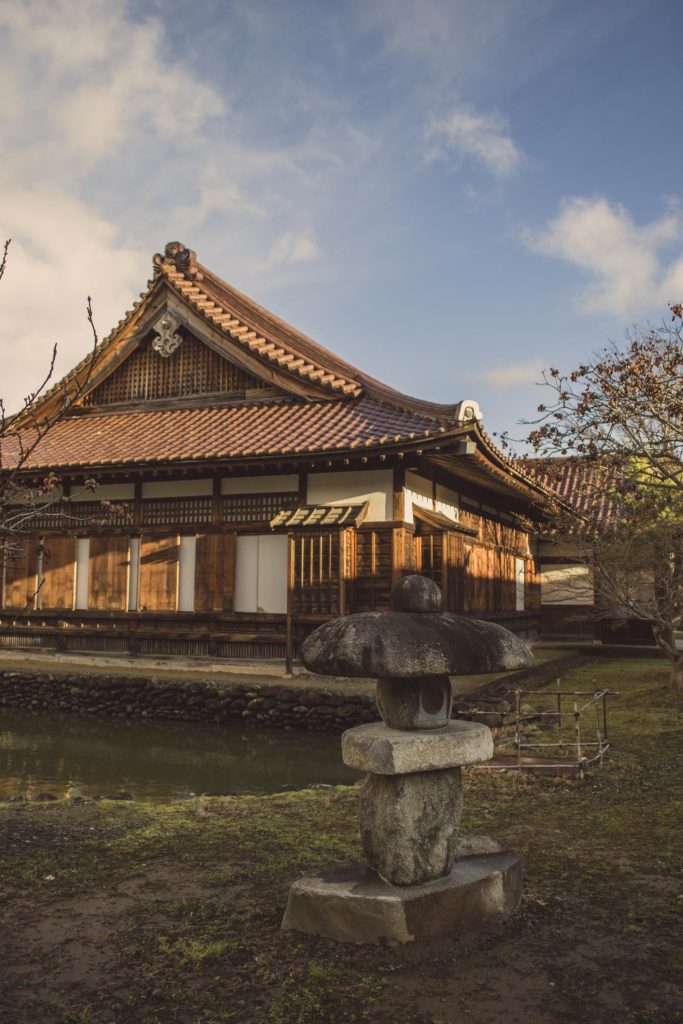
Nowadays, when you stroll through the grounds, you’ll be able to witness some fantastic architectural masterpieces of the Edo period as well as dioramas which display the vigilant lifestyles of the students back then.
This includes learning about how students began calligraphy classes at the age of 13 (because of the different dialects of various parts of Japan, sometimes even conversation was difficult), etiquette classes to uphold the samurai prestige, swimming across the Suiren Buibalke pool in full armour as training, archery training – and that’s not even half of it.
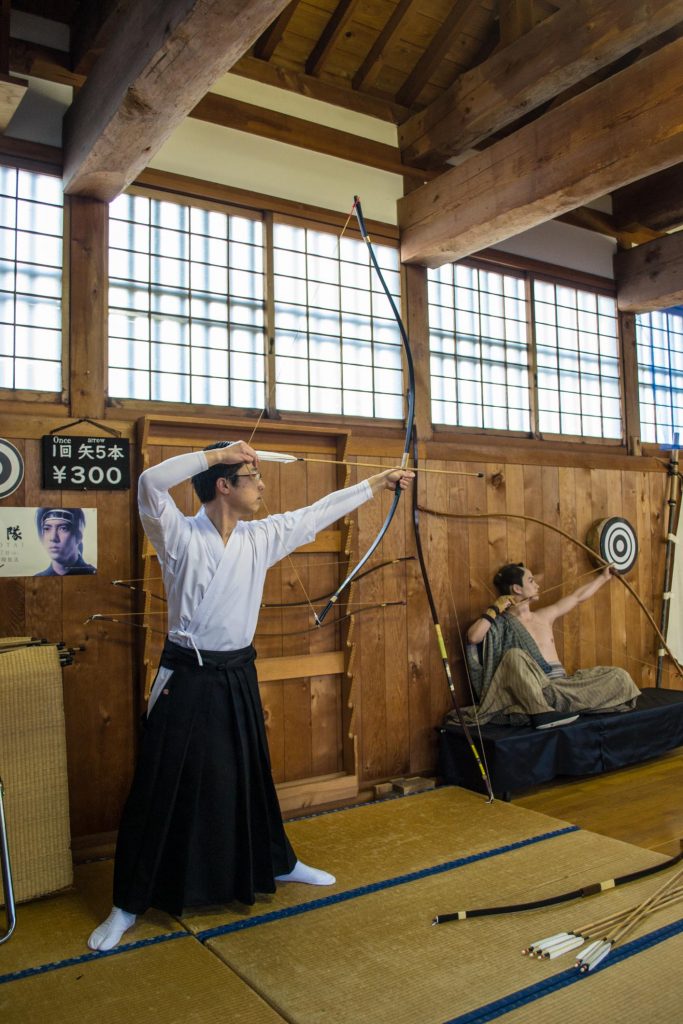
This is a great place to learn about the history of samurais if you’re interested, and let’s face it, all of us harbour a little fantasy of imagining ourselves being strong warriors, fighting for what’s good and right!
- Address : Japan, 〒969-3441 Fukushima, Aizuwakamatsu, Kawahigashimachi Minamikoya, Takatsuka
- Access : From Aizu-Wakamatsu Station, it is a 15-minute taxi ride.
- Hours : 9:00am – 4:00pm
- Price : Adult: 620yen, Child: 450 yen
3. Oyakuen Garden
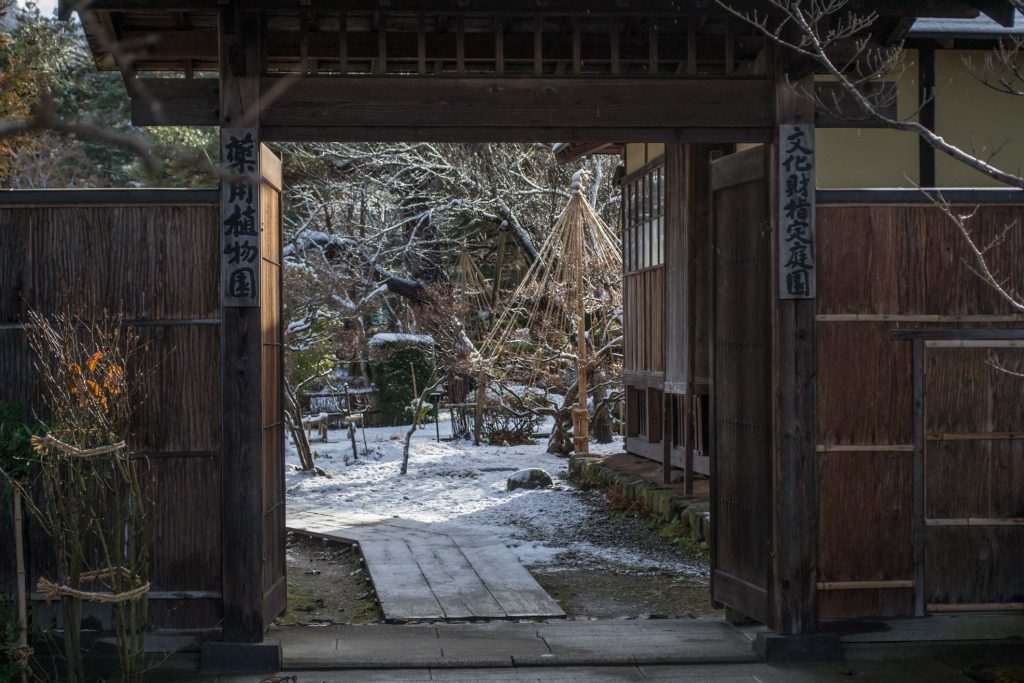
In the very traditional region of Aizu Wakakamatsu, you will be pleased to know that there exists a gorgeous Japanese landscape Garden, perfect for quiet strolls and those who appreciate simple Japanese natural scenery. It was nicknamed “Medicinal Herb Garden” during the 18th century, and now, aside from its pond and the surrounding garden, it also boasts an herb garden that showcases hundreds of various types of medicinal plants.
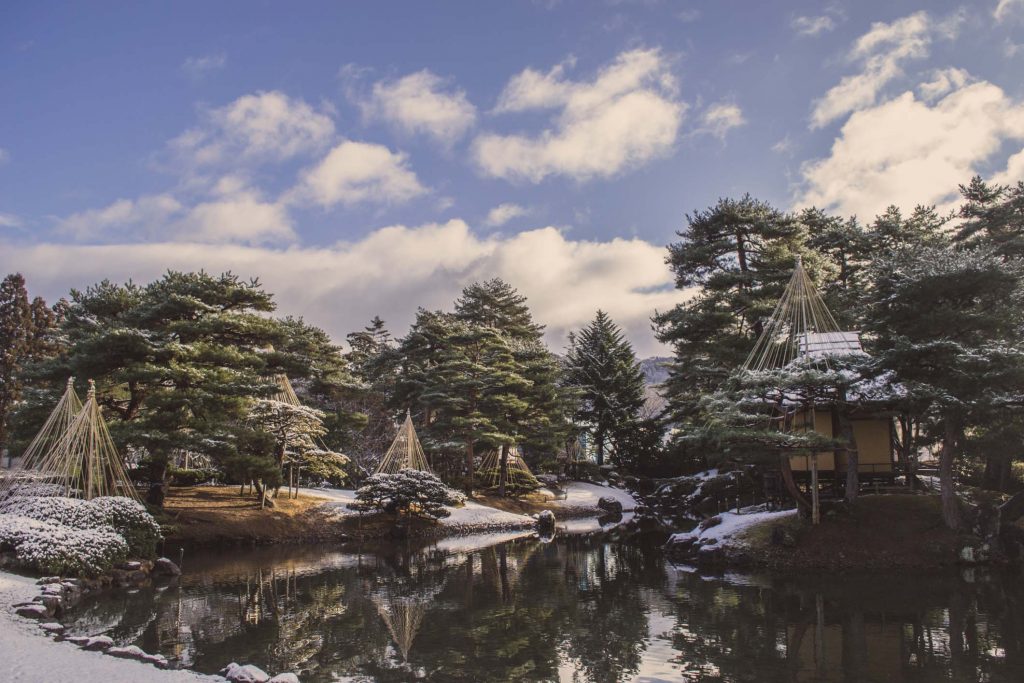
Whilst here, make sure you pay a visit to the Ochayagoten, a tea house which faces the picturesque pond where you can relax, sip on some matcha tea and enjoy some wagashi. The Rakutei is another structure that is worth a visit; it sits right on the pond and can be accessed via a bridge. This is a great photo opportunity!
- Address : Aizuwakamatsu, Fukushima 965-0804, Japan
- Access : From Aizu-Wakamatsu, you can hop on the Aizu Loop bus which will stop at Oyakuen (will take 30-minutes).
- Hours : 8:30am – 5:00pm
- Price : 320 yen
4. Aizu Bukeyashiki
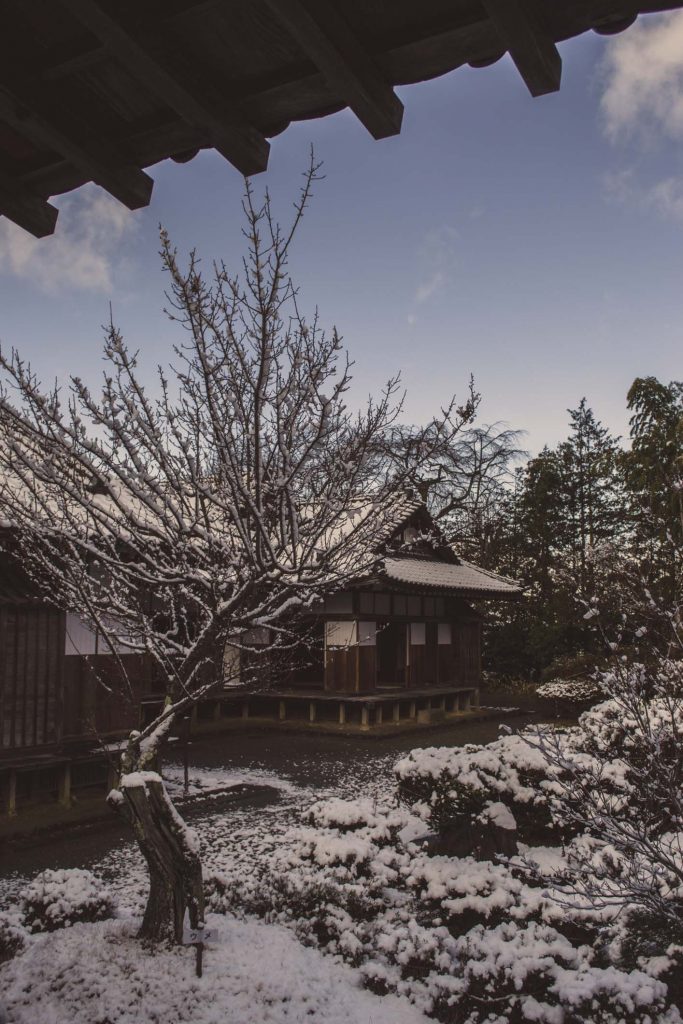
Aizu Bukeyashiki is a huge reconstructed samurai mansion that belonged to a former high-ranking samurai, Tanomo Saigo. Because of his prestige, his residence was built to reflect that, and thus you will find it to house a whopping 38-rooms! They include bedrooms, guest rooms, and other important rooms. The grounds of this property also host a tea house, a rice mill, and even an archery range!
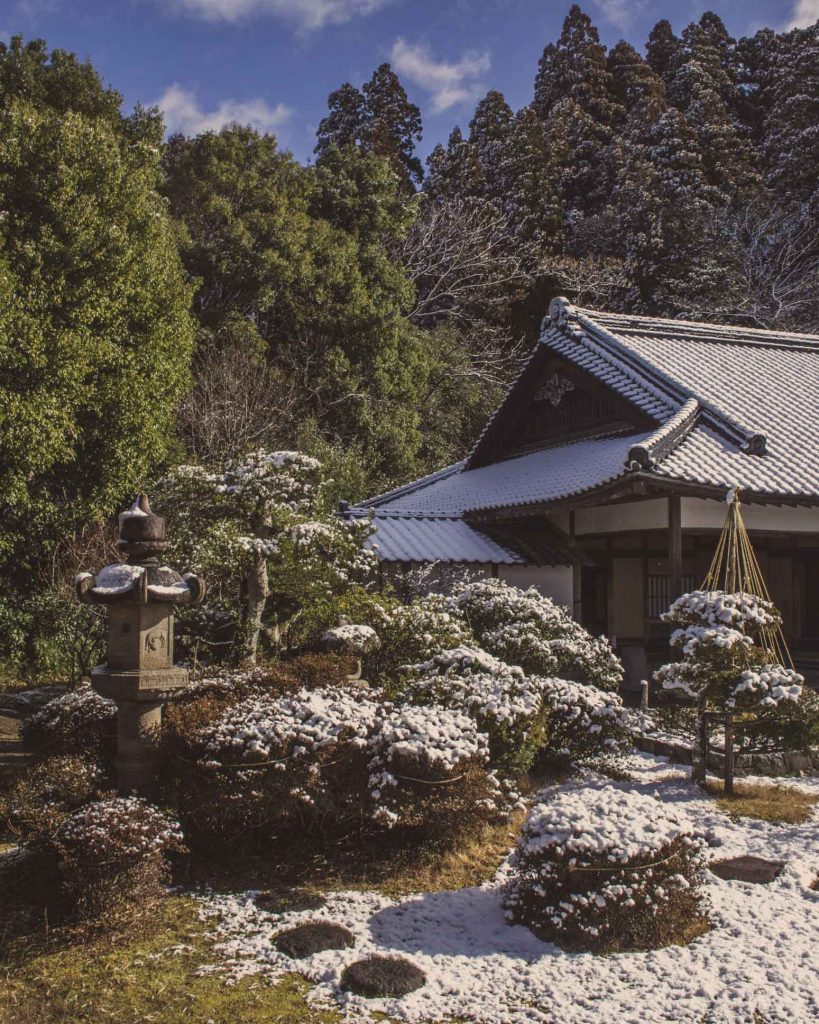
To five you a better idea of how samurais lived, there are waxed figures placed in certain rooms to demonstrate their actions and lifestyles, which is unusual but also a welcoming change to viewing empty rooms, don’t you think?
You can participate in painting or even a quiz about the history and culture of Aizu. After you tour the grounds, you can head to the onsite shop which sells traditional Aizu crafts to bring home as souvenirs, and get a light meal at the restaurant which offers some bangin’ local cuisine.
- Address : Innai-1 Higashiyamamachi Oaza Ishiyama, Aizuwakamatsu, Fukushima 965-0813, Japan
- Access : From Haikara-san/Aizu-Bukeyashiki mae bus stop, it is a 1-minute walk.
- Hours : Apr – Nov: 8:30am – 5:00pm, Dec-Mar: 9:00am-4:30pm
- Price : Adult: 850 yen, Child: 450 yen
5. Aizu Wakamatsu Castle (Tsuruga Castle)
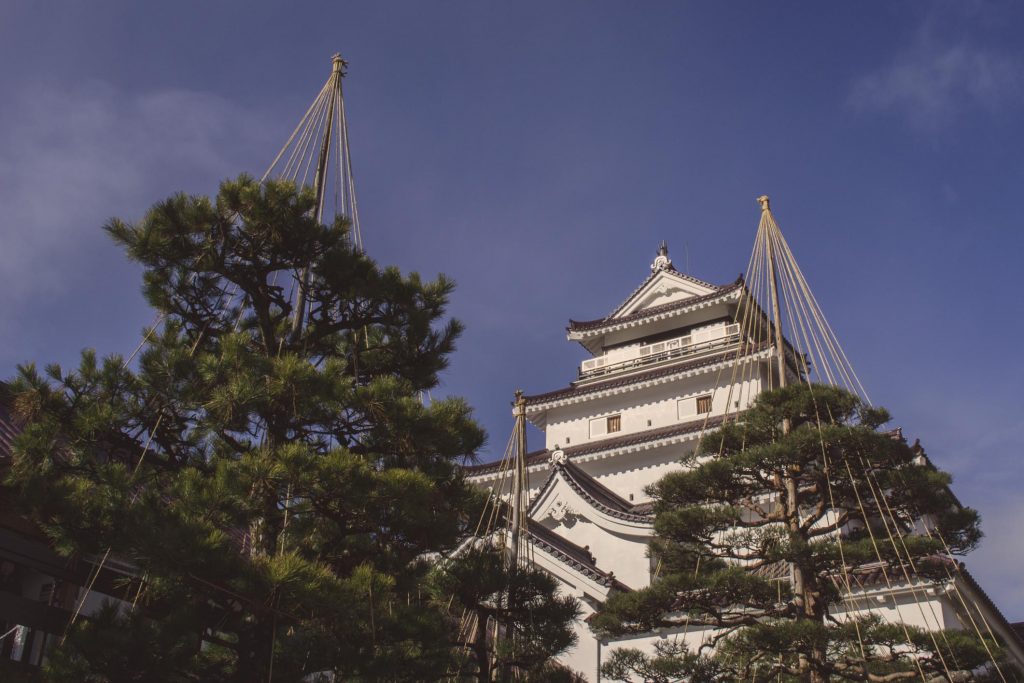
Tsuruga Castle was actually built hundreds of years ago back in the late 1300s, however, throughout its years it was passed through many hands of leaders, eventually becoming the very last stronghold for the Aizu Clan during the Boshin War.
The castle was damaged but not completely destroyed, but in true Japanese style, it was rebuilt to its former glory in the mid-1900s and now serves as a great attraction in the city of Aizu to display the history of the castle and detail the samurai lifestyle. The current castle is actually one of the most beautiful white castles across Japan – you don’t want to miss it!
One of the best things about this castle is that visitors can actually climb to the top floor of the keep and get some amazing views overlooking the city. Surrounding the castle is actually the Tsuruga Castle Park, which features cherry blossom trees and vast expanses of green lawns as well as moats and gorgeous stone walls.
- Address : 1-1 Otemachi, Aizuwakamatsu, Fukushima 965-0873, Japan
- Access : From Aizu-Wakamatsu Station, hop on the Aizu Loop Bus and alight at “Tsurugajo Kitaguchi” which is 20-minutes away.
- Price : 410 yen
6. Iimoriyama Hill
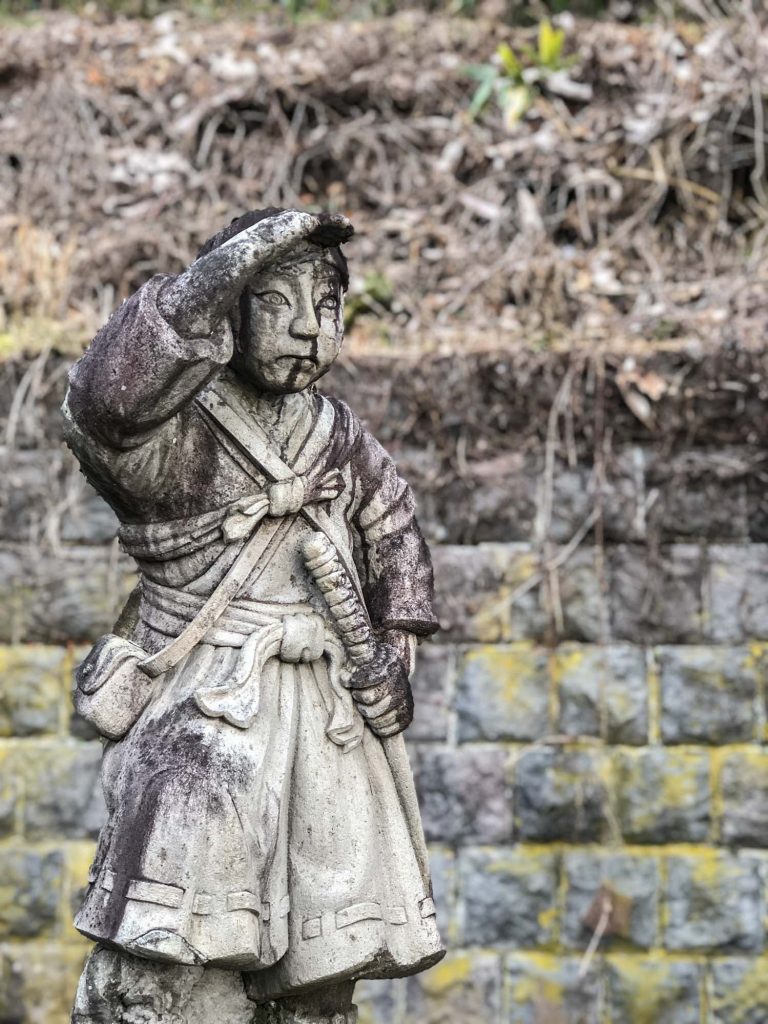
Iimoriyama Hill is a historically significant site for the Aizu Clan. During the end of the Boshin War, a small group of about 20 young Aizu samurai soldiers became separated from their division and escaped, eventually ending up at this very hill.
Looking over its edge, they thought what they saw was their stronghold castle, Tsuruga Castle, burning up in flames. In horror, they realised that there would be nowhere to return to, and true to samurai honour, instead of giving in the possibility of being captured by the enemy, they all committed ‘seppuku’, the ultimate act of suicide.
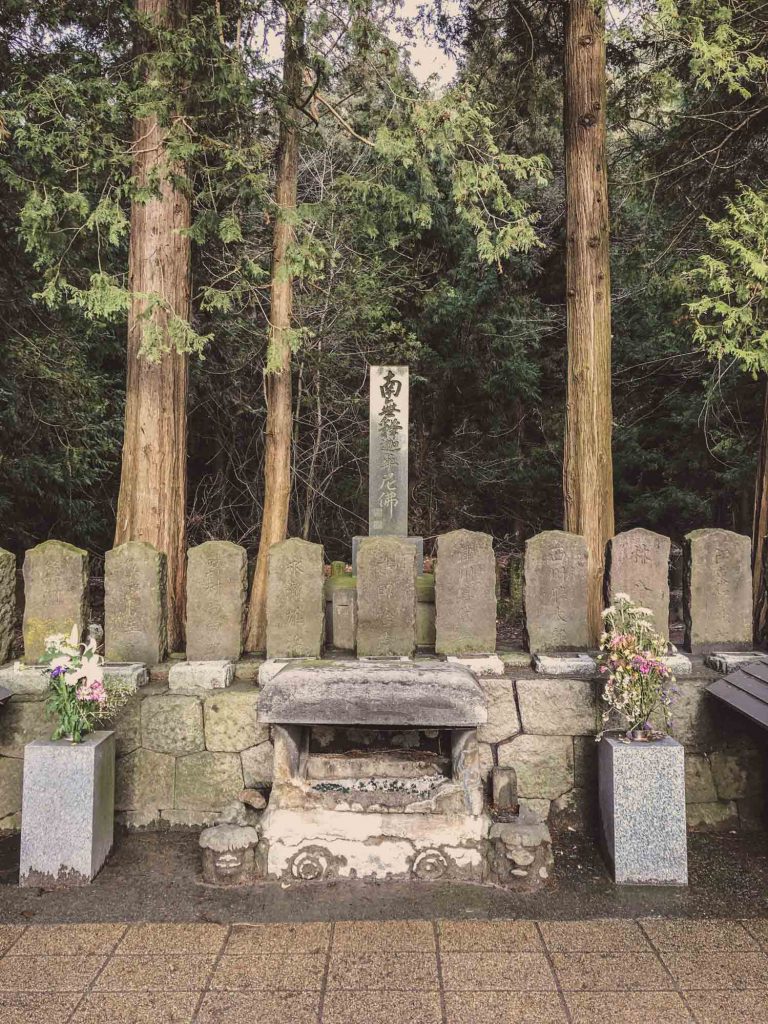
Unfortunately, what they witnessed was not their castle engulfed in flames, but the smoke coming from surrounding houses. One of the soldiers named Iinuma Sadakichi was fortunately saved, and thus the tales of the courageous boys have been passed on. Their tombs now lay on the hills of Iimoriyama and have become quite a popular attraction.
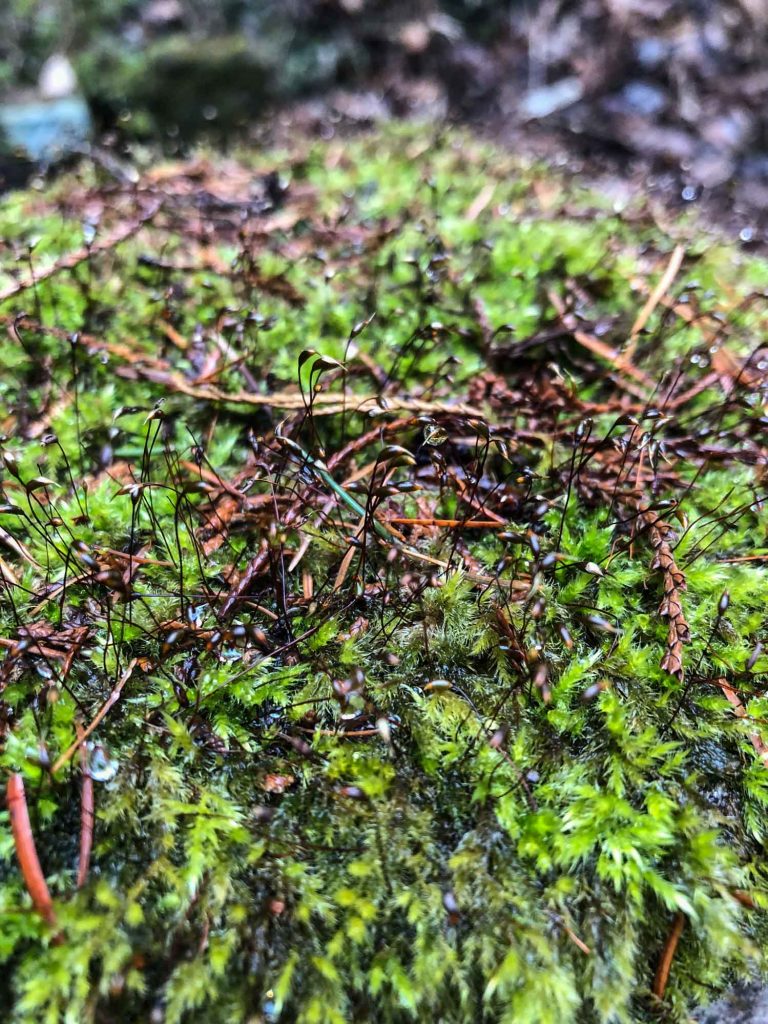
- Address : Yamatoyamaotsu Itsukimachi Oaza Yahata, Aizuwakamatsu, Fukushima 965-0003, Japan
- Access : From Aizu Wakamatsu Station, tahe the Aizu loop bus and alight at Iimoriyama-shita bus stop.
7. Sazaedo Temple
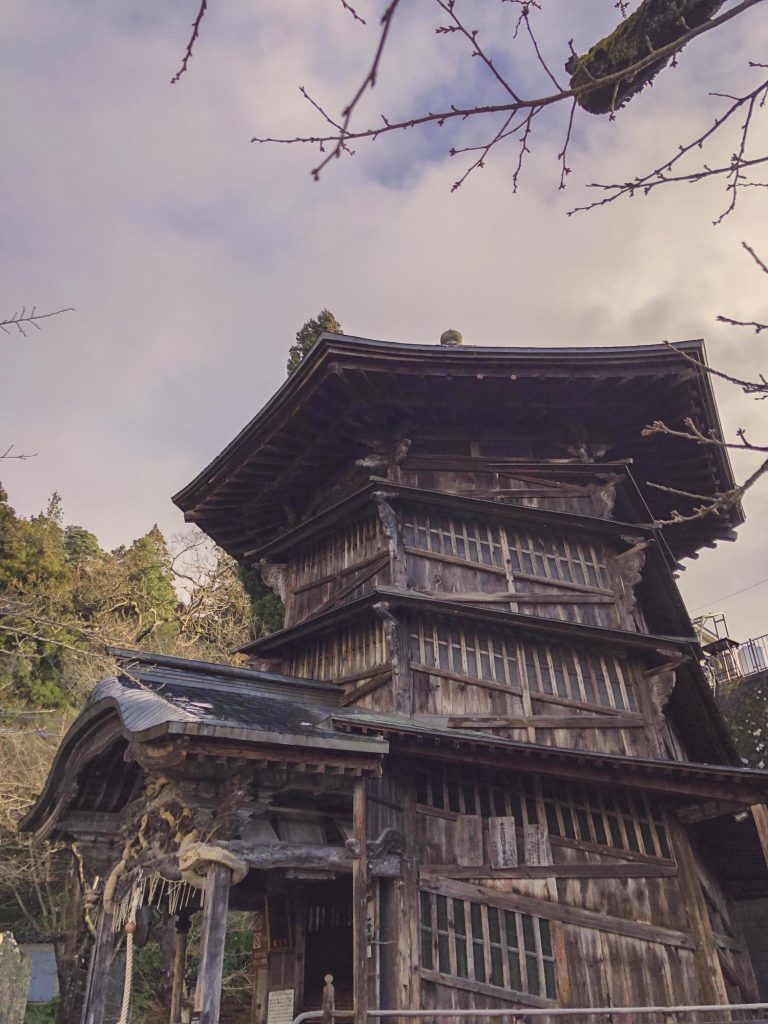
Close by to the Iimoriyama Hill is the unique Sazaedo Pagoda, most famous for its double helix staircase in which all those going up will never cross paths with all those going down. Completed in the late 1700s, visitors to this pagoda will get to witness a very unique historical monument indeed. It is said that those who reach the top of storey have actually completed the ‘Saigoku Kannon Pilgrimmage’ to 33 Buddhist Temples. The inside has some interesting details to capture, and the view at the top overlooks Aizu Wakamatsu. It’s also said that those who visit this pagoda will run into good luck afterwards, so what are you waiting for!
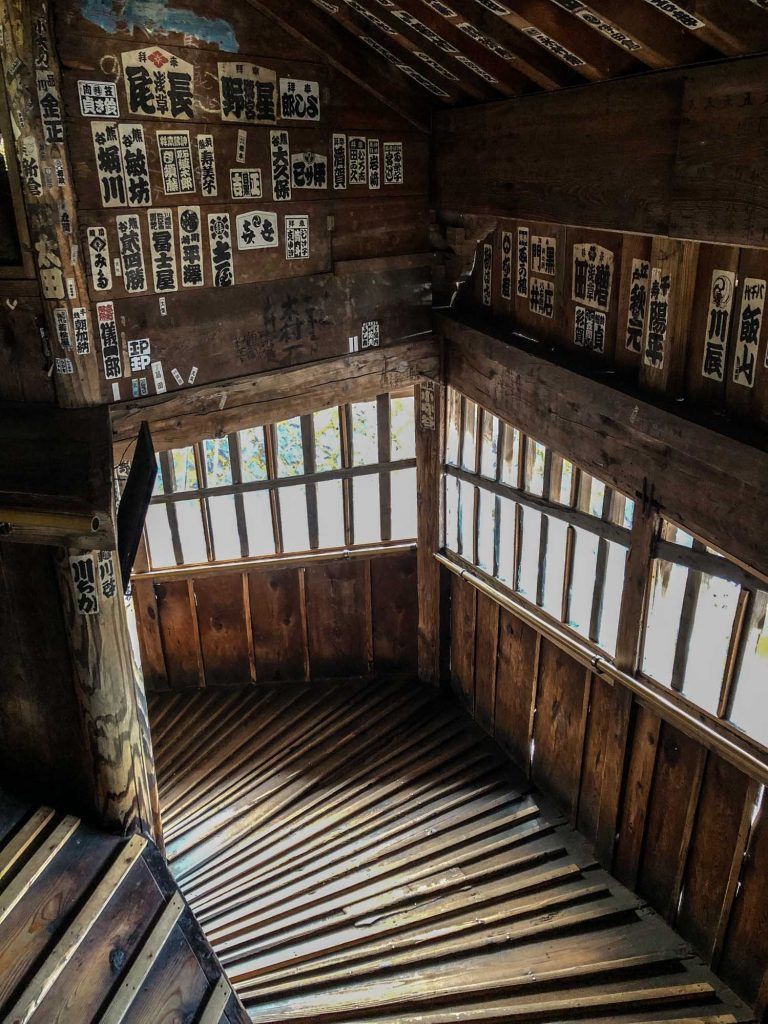
- Address : Takizawa-155 Itsukimachi Oaza Yahata, Aizuwakamatsu, Fukushima 965-0003, Japan
8. Ouchi-juku
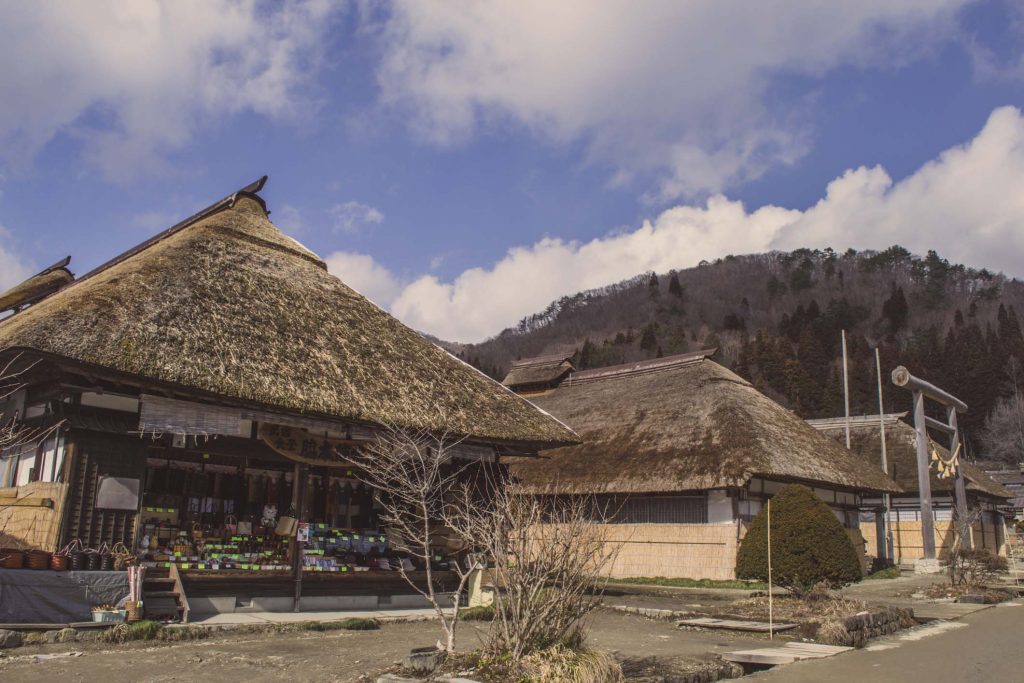
This former post town (a town located right next to the main roads with used to service travellers back in the old days) along the Aizu-Nishi Kaido trade route is a popular tourist attraction as it reflects the lifestyle during the Edo Period.
The restored village is known for its thick thatched roof houses, of which most have been converted to craft shops, restaurants, and minshuku (small, family-run Japanese-style B&Bs).
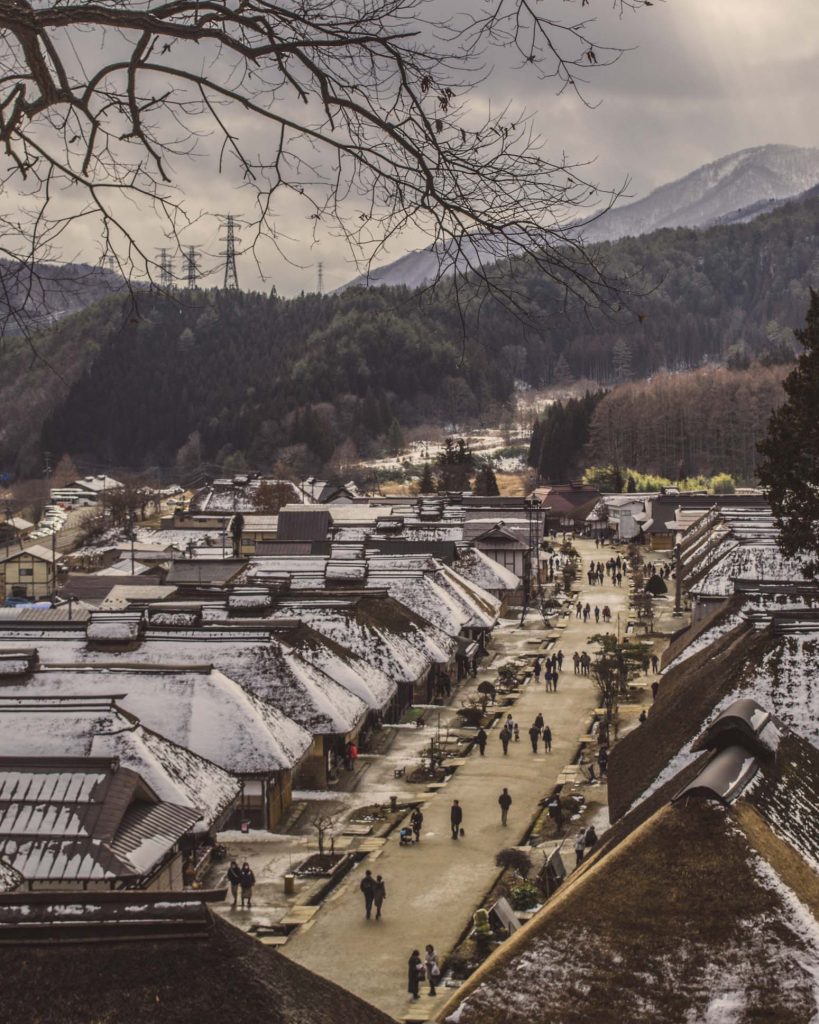
Walking through the unpaved wide-open streets here, you’ll feel the nostalgia in the air. You can visit Ouchi-juku’s Honjin (former inn that houses high-ranking officials) and witness examples of what the higher-class house interiors looked like, and see displays of many artefacts. At the end of the main strip, there is a temple that offers a great view overlooking the street.
Here’s how it looks the village looks like when it’s covered by snow.
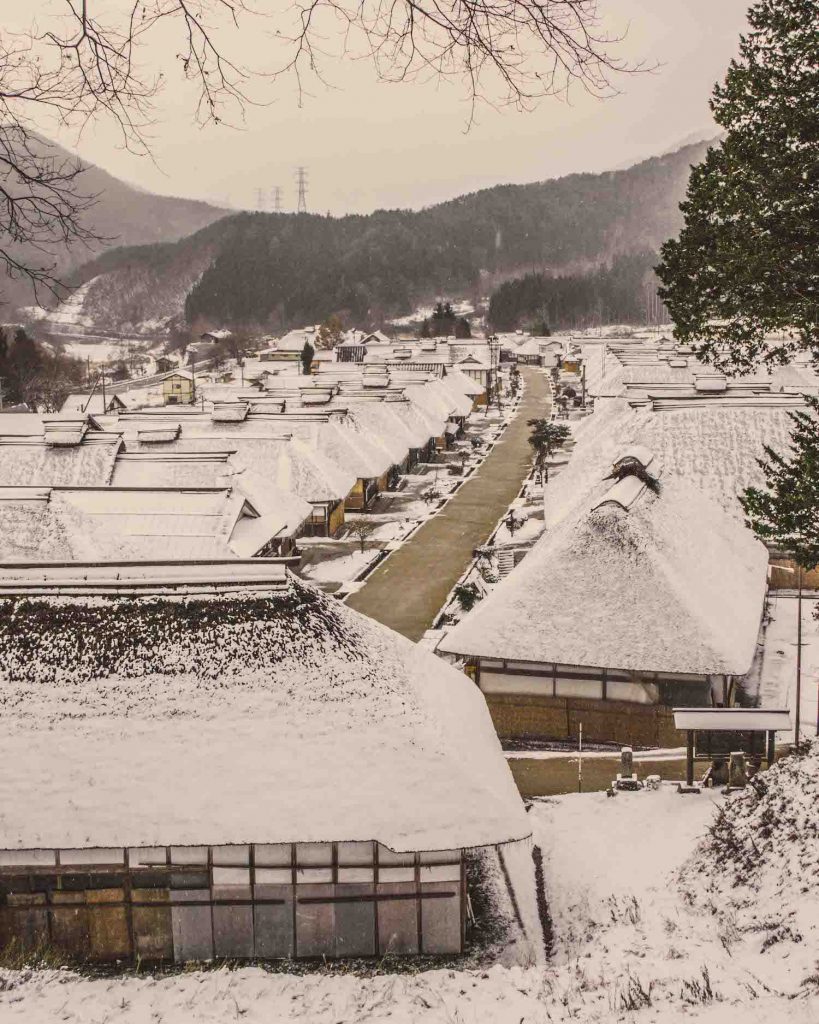
Ouchi-juku is a great half or full day trip that will transport you back in time and provide history buffs with some fun and interesting insight into a slice of Japan’s history that’s not quite in mainstream media yet, and that’s the best part.
And if you want to visit another ancient post town, check out the amazing Narai Juku in Nagano prefecture !
- Address : Yamamoto-8 Ouchi, Shimogo, Minamiaizu District, Fukushima 969-5207, Japan
- Access : From Aizu Wakamatsu, take the train to Yunokami Onsen. It will take 35-minutes and cost 1,030 yen.
Aizu Wakamatsu may be a popular destination with locals now, however, sooner or later we think of the tragic and beautiful history of the place will spread far and wide. Looking beyond that, this region is full of culture, and due to its location, makes it an obvious next destination if you’re visiting something like Nikko or Niigata.
Samurai enthusiasts, there is way that you would miss visiting a place like this, and for all other travellers, well, let’s just say that if you come home equipped with extensive knowledge of the history of samurais and a rather exclusive slice of Japan’s history, you’ll be very popular indeed!
If you are interested in Japanese history, you should also read this blog post: 10 Popular Historical Japanese Persons .
Leave a Reply Cancel reply
Your email address will not be published.
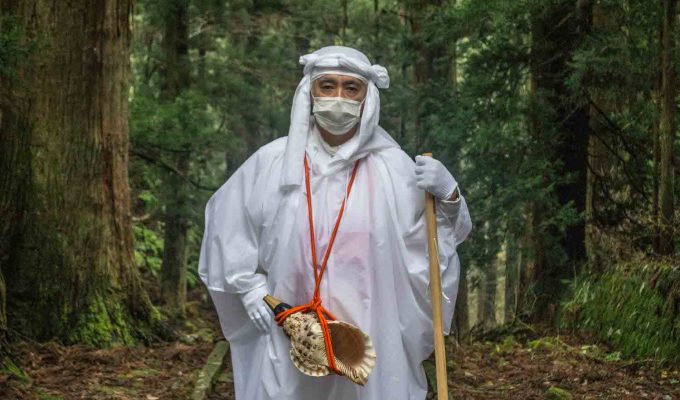
Discover Yamabushi, The Mountains Monks Of Dewa Sanzan In Yamagata
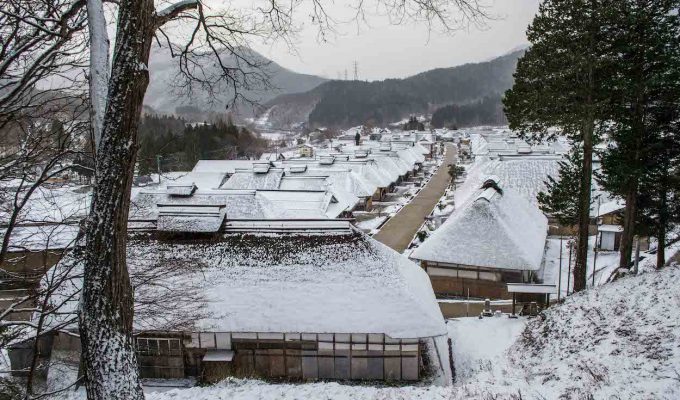
Let’s Explore The Beautiful Area Of Aizu Wakamatsu In Tohoku
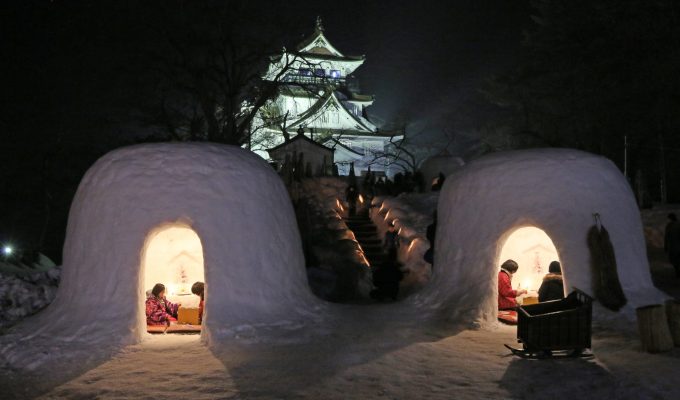
Akita Japan – All You Need To Know To Enjoy This Gorgeous Area In Tohoku
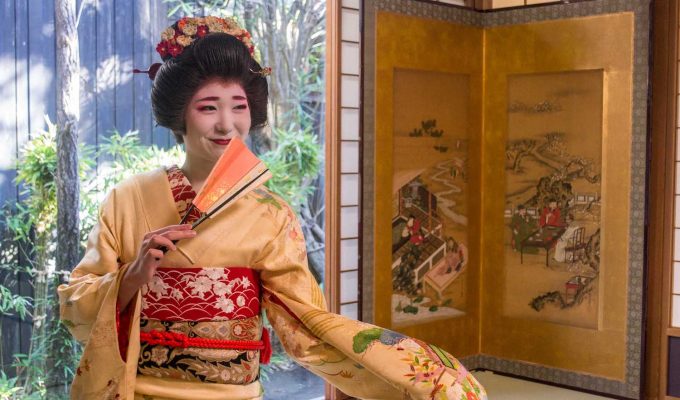
Meeting The Furumachi Geigi, The Geishas From Niigata
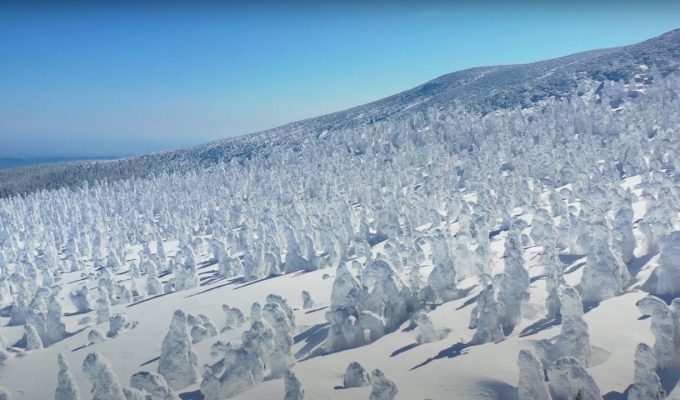
This Drone Footage Of Zao Snow Monsters Is AWESOME!
The 10 coolest & most unique hotels in japan.
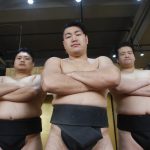
Welcome To The New Sumo Restaurant In Tokyo: Asakusa Sumo Club
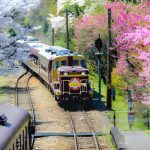
A Complete Guide To Enjoy Peach Blossom In Japan
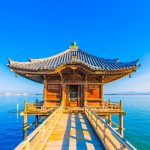
Discover Otsu – 10 Things To Do In This Beautiful Hidden Town Near Kyoto
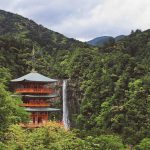
Japan Travel Blog 2024 – The Ultimate Guide To Visit Japan
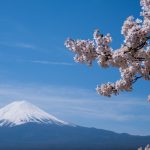

Cherry Blossom Forecast Japan Spring 2024 – When To Enjoy Sakura
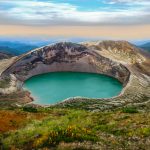
Zao Onsen – Get Off The Beaten Track And Visit This Gorgeous Onsen Town
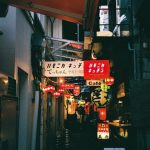
Explore Kichijoji in Tokyo – Full Area Guide You Have To Read!
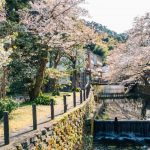
The 7 Best Onsen Towns Near Kyoto You Have To Explore
- Search Search Search …
- Search Search …

The Best 9 Things to Do in Aizu Wakamatsu
If I start by saying that the only reason we planned to come to Aizu Wakamatsu was to ride a train, it sounds (and is) very unfair. But that’s the heart of it. We came here to ride one of Japan’s scenic trains and found a glorious small friendly city perfect for a couple of days of exploration. Aizu Wakamatsu is at the heart of samurai country, is famous for a certain type of water, sashimi (again of a certain type), and has both a fabulous castle and a glorious garden to visit. Here’s our guide to the best things to do in Aizu Wakamatsu.
THIS POST MAY CONTAIN COMPENSATED AND AFFILIATE LINKS MORE INFORMATION IN OUR DISCLAIMER
We got here in a somewhat convoluted manner, we had after all traveled down from the far north of Japan, Wakkanai, via Sapporo and Hakodate to get here. That’s not a normal route, it’s just the way of things when you have a JR Pass and you’re making the most of it. And we definitely were. Most people come to Aizu for one of two reasons. The first is the samurai history here (and it is fabulous) and the second is the Tadami Line train and yes that is glorious too. And I’ll explain about both of them.
TOP THING TO DO

Visit the Castle in Aizuwakamatsu
This glorious castle is unique, in its tile color, and as the stronghold of the samurai. Come visit and learn about the history of Samurai City.
The 9 Best Things to Do in Aizu Wakamatsu
Aizu Wakamatsu is the primary city in the Aizu region of Fukushima Prefecture, we spent several days here exploring, sometimes on foot, and other times using the tourist office buses that will take you on set routes around the city. We explored the castle, because, you know we just LOVE Japanese castles , we found out a whole lot more about Japanese samurai history, ate some of the food specialties of the region, and then took the train as part of our route back to Tokyo.
1. Take the Tadami Line Train
This was our number one reason for visiting Aizu Wakamatsu. It’s one of the top scenic train journeys in Japan. It was closed for 11 years as repairs to the line were made following rainstorm damage but reopened in October 2022. The Tadami Train Line goes from Aizu Wakamatsu to Koide – from Fukushima Prefecture to Niigata Prefecture on single, narrow gauge track and it’s a truly glorious 135 kilometer (84 miles) route that takes about 4.5 hours as it curves around the mountainous route through 36 different station stops. My guide to the Tadami Train Line is here.
There are glorious views on this route, whatever time of year you take the train (and it’s covered on the Japan Rail Pass, or you can buy tickets specifically for it). The most famous view of the Tadami Line is actually of a train crossing the Tadami River, but you’ll have to get off the train to see that.

There are no reserved seats, so you’ll want to get there early to guarantee a seat. This is a popular route with domestic tourists. You can make a day of it, use it as your onward transport, or go there and back in one (long) day. This is a fabulous scenic train journey in Japan and it is worth coming to Aizu Wakamatsu for this trip alone

2. Visit Tsugara Castle in Aizu Wakamatsu
I’ll be upfront and tell you that this Japanese Castle is a reproduction, but that doesn’t take anything away from it. It’s a glorious castle. The current floor plan dates from 1593, but there has been a castle here since 1384. The castle was integral to the Boshin War of 1868 and was home to the Byakkotai, often known as the last samurai or the White Tiger Brigade. You can easily get to the castle from the train station, but it is also covered on the tourist office circular bus routes. While the castle is now concrete, the moats and some of the walls are original. The official name of the castle is Tsugara, although it is also known as Wakamatsu Castle. You can skip the line and buy your tickets for the castle here.

The castle is centered in the Tsugara Castle Park, and in spring, this is a lovely time to check out the Cherry Blossoms. We were just a little too late, and although there were some blossoms left, the peak had passed. Inside the castle, there’s a teahouse, the Rinkaku Teahouse, where you can take tea, and explore this historic place where feudal lords took tea ceremonies.

What’s unique about Tsugara Castle is the red tile roof. Red is an unusual color for Japanese castles, they tend to be black and white. Here the original tile color dates from 1603-1867, the Edo Period in Japan. While for many years the tiles were black, they reverted to the Edo colors in 2011. And that’s what’s behind the name of the castle “Tsuru” – it means crane.
The views from the top of the castle are also glorious.

The castle grounds are pleasant to walk around and it’s a peaceful place to explore. You’ll also find an exhibition inside the castle on the castle itself as well as the samurai lifestyle and several artifacts.
3. Visit the Oyakuen Garden in Aizu Wakamatsu
There are nearly 400 herbs still grown here in this traditional Japanese garden, the name Oyakuen translates as Medicinal Herb Garden, and it’s possible to walk down the rows of herbs (some are noted in English, some not).

There’s also a delightful pond and tea house here, as well as pathways amongst the trees. The garden has been here since the 18 th century. Originally this garden was a villa for the feudal lords of the time, and the medicinal herb garden started as his way of trying to protect the citizens from the plagues of the day. Oyakuen is now a preserved important national asset.

There’s a tea house here, and a small shop, but the delight of this garden is simply being able to walk around and explore the hidden corners within it. There’s a restored tea house on the small island within the gardens.

Oyakuen is open from 08:30 until 17:30 and while there is parking here, it’s also a stop on the tourist bus that runs from the Aizu Wakamatsu station. Entrance fees to Oyakuen are 330 JPY for adults.
4. Explore Aizu Bukeyashiki – aka Samurai Residence
Also on the route of the sightseeing bus is Aizu Bukeyashiki – and you really shouldn’t miss this stop. It’s a traditional samurai residence and it’s enormous. It was empty of other visitors when we visited and just glorious. Bukeyashiki was home to some of Aizu’s most important samurai during the Edo period and the layout has been faithfully represented and dressed to show how life would have been here.

There are 38 rooms to explore, and while the original building was destroyed during the Boshin War it was rebuilt as a replica. It’s a fascinating place to visit. There’s a self-guided walking tour with an English language leaflet available, with points of interest marked.

If you’re lucky enough to visit during Cherry Blossom season there are glorious blooms in the gardens here.

Entrance fees are 850 JPY per adult and opening times are 08:30 to 17:00 (April to November) and 09:00 to 16:30 (December to March).
5. Walk up Limori Hill and Pay Respects to Aizu’s last Samurai
You’ll be able to get close to the base of Limori Hill in Aizu using the tourist shuttle, but then you’ll have to walk up. During the summer season there is an elevator for part of the way (it costs 250 JPY).

The hill, also known as Mt. Iimoriyama (飯盛山) is associated with the Samura group called the White Tiger Battalion, or the White Tiger Force, or Byakkotai. The story has it that, during the Boshin War, a group of 19 teenage samurai had retreated here to Limori Hill. They saw Tsuraga Castle burning in the distance and thought it had fallen. All 19 committed ritual suicide.
Their graves are on Limori Hill and there are several museums in the area about them.

6. Visit the Sazaedo Temple in Aizu Wakamatsu
While you’re on Limori Hill, also take a visit to Sazaedo Temple. Made completely of wood, it has two spiral staircases, they go in opposite directions, so you’ll never cross paths with someone going the other way, meaning that you won’t be disturbed during your prayers by people returning. It’s often described as the “Double Helix Temple and it’s also known as the sea snail temple. The temple was constructed in 1796 and is three stories high, it is a designated National Important Cultural Property.

This temple has 33 statues said to represent the temples of the Saigoku 33 Kannon Pilgrimage. You can pray at each in place of visiting the actual temples and receiving blessings. Praying at each earns pilgrims good fortune and merit (and of course saves time by not going on an actual pilgrimage!)
The temple is open year-round from April to December from 08:15 to sunset and January to March from 09:00 to 16:00. Entry fees are 400 JPY.
Other places to visit on Limori Hill
If you have more time there are several other places to explore on Limori Hill, they include
The Byakkotai Museum: It’s privately owned and includes exhibits related to the Byakkotai and the Boshin War. Entry fee 400 JPY.
The Byakkotai Legendary Museum: Another privately owned museum on the Byokktotai containing more than 5000 artifacts. Entry fee 300 JPY.
The Tonoguchi Weir Cave: This looks more like a small spring or waterfall, it’s where the Byakkotai escaped to, it was here that they emerged and saw Aizu Castle in flames.

The Byakkotai Graves: There’s a grave for each of the teenagers who committed suicide believing that Aizu Castle had fallen. While the date on the graves reads 23 August 1868, it was based on the lunar calendar that was used at the time, in today’s calendar it equates to 8 October 1868. Other Byokkotai who perished are also buried here.
The Byakkotai Harakiri Memorial: You’ll find this at the location where the White Tiger Battalion committed suicide. Legend has it that only 16 succeeded, 3 others survived but died in later fighting and finally, one was left to tell the tale of what happened.
There are various other monuments on the hill including:
A Monument from the City of Rome – this came from a temple at the Pompei ruins and was dedicated by Mussolini in 1928.
A German Monument gifted by a German Diplomat
7. Take a Sake Brewery Tour (and taste) at Suehiro Sake Brewery
Aizu Wakamatsu is known for its sake, rather like Saijo , the sake brewery town that we visited near Hiroshima, the combination of pure water, and great rice production has led to centuries of sake production here.
The most famous of the Aizu sake breweries is Suehiro, its accessible easily on the Aizu tourist and sightseeing bus loop. When they’re giving tours (check with the tourist information) you can get a free tour and tastings, they’re only at specific scheduled times and may not be in English. Sake has been brewed here at Suehiro by the same family for 8 generations, since 1850. They use a traditional method of brewing, called Yamahai, which delivers a complex, full flavor using slow-open fermentation.
There’s also a café, store, small museum, and Japan’s biggest private collection of film cameras here.
8. Understand Samurai at the Samurai School in Aizu Wakamatsu
Aizu Wakamatsu is the heart of samurai country in Japan. Its location, surrounded by mountain ranges, helped it to be one of the last samurai strongholds during the Edo Period (1603-1868). The area was particularly active during the Boshin War of 1868-1869. The Boshin War is also known as the Japanese Civil War or the Japanese Revolution was fought between the Tokugawa shogunate and a coalition seeking power. It had been the opening of Japan to foreigners in the previous decade that led to increased dissatisfaction with nobles and samurai.
You can learn much about the samurai, the Boshin War, and the fall of Aizu Castle here in Aizu, and the best place to start is the Nisshinkan or Samurai School. The school was built in 1803 and was where boys of the Aizu Clan learned martial arts, culture, and had academic classes to become samurai.
There are self-guided tours around the school, with some explanatory detail – but for detail, you’ll want to take a guided tour in English . The school is now a museum, and it’s huge. You can take lessons in archery here, zen meditation, and tea ceremonies – all things that the boys who were taught here would have learnt. Entrance is 850 JPY. The sightseeing bus doesn’t go out this far so you’ll need to take a taxi or drive to reach the school.
9. Relax at the Higashiyama Onsen
There are a bunch of hot spring resorts around this valley, and the best known is Higashiyama Onsen, it’s at the end of the line of the tourist sightseeing bus, but it feels like you’re miles and miles away from the city up here, even though it’s just 10 minutes by car from Aizu Wakamatsu. The bathhouses here are traditional Japanese style.
If you’re looking for a traditional ryokan and onsen experience in Aizu, then this is the place to come. My guide to ryokan etiquette is here. There are several ryokan here, the highest rated of which is the Onyado Toyo , which comes with traditional Japanese rooms with the most magnificent of views, glorious onsens, and seasonal food options. These rates include breakfast, dinner, and private bathrooms (which have sinks and toilets), bathing is in the shared onsen facilities. Come during snow crab season for a fabulous dining experience! There’s a shared shuttle available from the train station in Aizu, or you can also leave your bags for a free bag transfer, and catch the tourist shuttle at the end of a day sightseeing. Book a Room here.
How to get around Aizu Wakamatsu
The easiest way to get around the main attractions of Aizu Wakamatsu is to take the tourist bus that sets off from the train station. There are two routes – the Haikara-san and the Akabe town bus.

The bus tickets cost 600 JPY per adult and last one day. If you show your bus tickets at various Aizu Wakamatsu’s attractions you’ll also get discounted entry. The timetable is great, it allows you enough time to explore each of the attractions and then simply get the next bus.

You can also choose to buy combo tickets that includes the cost of entry. So it’s best to check which locations you’ll want to visit and pick the best combo ticket for you. If you’re here in the very early spring or late fall season then there are likely to be a lower number of buses each day and the timetable might not be full. Check at the tourist office, which is found opposite the train station. That’s also where you can buy the tickets for the sightseeing buses. (Walk out of the station, go straight ahead, and cross the road. Turn left as though heading towards the Toyoku Inn and the tourist information office is just there.)
Take a Day Trip from Aizu Wakamatsu to Ouchijuku
Our first experience of Japan’s old post towns was the hike from Magome to Tsumago and it was glorious. Japan’s post towns date mainly from the Edo Period, when traders, tax collectors, and travelers journeyed on one of the main Edo routes. The towns developed and served as places where the government of the day could control the highway system, they were places where travelers could rest, stay the night, and obtain food. Ouchijuku is on the old Aizu Nishi Kaido Route. This route was a 130-kilometer (81-mile) route that connected Imaichi, in modern-day Tochigi Prefecture with Aizu Wakamatsu Castle in Fukushima Prefecture.

The town has been preserved and is a delight to visit. To get to Ouchijuku take the train from Aizu Wakamatsu to Yunokami Onsen Station. From there you’ll need to take a taxi or a bus to Ouchijuku. Don’t miss their famous soba noodles. Don’t worry if you can’t handle chopsticks, here they give you a leek which you use to eat them (!).
The Saruyu-go bus runs from April until late November and a 1 day pass that’ll take you to and from the station to Ouchijuku costs 1,000 JPY. There are 8 buses a day in each direction, the last bus is at around 16:00.
What to eat in Aizu Wakamatsu
There are some specific dishes that the Aizu area is famous for and Aizu Wakamatsu is one of the best places to try them. Here’s what you should look for
Yanaizu Sauce Katsudon
Katsudon is a breadcrumbed fried pork fillet served on a bowl of rice that also has shredded cabbage. A special sauce is drizzled over the top of it. It’s slightly sweeter than you’d normally expect from a katsu sauce, but delicious all the same. The best place to get Katsudon in Aizu is the tiny but fabulous Katsuichi ( here’s a map link for you ).

If you eat nothing else from the local area you should try this.
The next thing that you should try in Aizu Wakamatsu is Dengaku. Here in Aizu, these are skewers basted with a miso paste and roasted over an open flame. And you’ll want to head to Mitsutaya for these, you sit right up at the bar, and choose your skewers, which are basted for you and then stuck into the charcoals, right in front of you.

Don’t worry the staff will come back and rescue you when they’re done and get them out of the flames and onto your plate. They’re great for sharing.
Drink Suehiro Sake
Founded in 1850, Suehiro Sake Brewery is the most famous of Aizus sake breweries. This family-owned for 8 generations brewery does do tours and tastings, but you’ll have to ask locally about when they are (use the tourist information office for this), as they depend on the season.

If you’re not able to get on a tasting, then head to one of the small supermarkets in Aizu – they sell Suehiro sake, and it is well worth tasting it while you’re here, you’re unlikely to find it outside of the area unless you go to a specialist liquor store.
Where to Stay in Aizu Wakamatsu
For me, there are two options of where to stay in Aizu. If you want somewhere close to the train station, you can’t beat the Toyoko Inn . It’s about a 5-minute walk (you can see the hotel sign when you get off the train), they provide an included Japanese breakfast buffet and while the rooms are Western style, they also provide yukata and all the toiletries that you’ll need. The staff is great here and they also provide a luggage store service if you arrive before check-in, or want to explore the city after you’ve checked out. Check room rates and book here.
If you prefer to make more of an experience to your visit to Aizu, then head to the Higashiyama Onsen area of Aizu. Up here, just 10 minutes in a taxi from the station you’ll feel like you’re a million miles away. Book a traditional Japanese-style room at the Onyado Toyo , where rates include breakfast, dinner, and private bathrooms. Book a Room here.
Travel Tips for Exploring Japan
- Considering travel insurance for your trip? World Nomads offers coverage for more than 150 adventure activities as well as emergency medical, lost luggage, trip cancellation, and more.
- Get online immediately with an eSIM for Japan
- Take the right POWER ADAPTER to Japan
- Download and install a VPN BEFORE you travel to Japan > discount coupon here
- Read our guide to the Japan Rail Pass here
- You can buy JR Passes from Klook > check details here
- Or buy JR Passes from JRailPass here with delivery in 24-48 hours (including to your hotel in Japan)
- Want to know what its like at a Maid Cafe ?
- Read about experiencing Sumo Practice in Japan
- Read about staying in a Ryokan town in Japan
- Learn to cook Japanese food in Chef’s kitchens in Japan
- Read about ATM fees in Japan here.
- Save money in Japan with a Wise debit card
- Find the right accommodation for you via Booking.com
- Book an incredible ryokan experience in Japan
Final Words on the 9 Best Things to Do in Aizu Wakamatsu
Aizu Wakamatsu is a delightful city in Fukushima Prefecture. Don’t let the term city put you off, this is a small local place with some great things to see and do. The samurai history is incredible, the castle a glorious rebuild and you’ll definitely feel as though you’ve fallen well off the tourist trail. Come here on the Tadami Line train and have another great experience too.
We receive a fee when you get a quote from World Nomads using our affiliate links. We do not represent World Nomads. This is not a recommendation to buy travel insurance.
ASocialNomad is a participant in the Amazon Services LLC Associates Program, an affiliate advertising program designed to provide a means for sites to earn advertising fees by advertising and linking to amazon.com, amazon.co.uk, and amazon.ca. Amazon and the Amazon logo are trademarks of Amazon.com, Inc. or its affiliates. As an Amazon Associate, I earn from qualifying purchases .
Sarah Carter
Leave a comment cancel reply.
Your email address will not be published. Required fields are marked *
Save my name, email, and website in this browser for the next time I comment.
Privacy Overview

Aizu-Wakamatsu
The castle town of the samurai era in fukushima.
Aizu-Wakamatsu is a city nestled in the mountains in the west of Fukushima prefecture, in Japan’s Tohoku area. Once the former feudal capital of Aizu domain, the city has become a touristic destination renowned for its castle and samurai clans’ heritage. Amateurs of retro shopping will also enjoy the local traditional craftsmanship.
About 3 hours by train 🚅 from Tokyo station, Aizu-Wakamatsu is an interesting introduction to Fukushima prefecture and more broadly to northern Japan. The city is surrounded by grandiose natural landmarks such as Lake Inawashiro , Mount Bandai , and the marvelous Oku-Aizu Valley . Outdoor activities are plenty, from skiing in winter to long hikes in summer .
Aizu-Wakamatsu’s downtown is also worthy of interest thanks to several places that are reminders of the city’s past glory as Aizu domain’s samurais’ capital during the Edo period (1603 – 1868) . Let’s have a closer look at the sightseeing possibilities.

The iconic Tsuruga Castle
Tsuruga Castle 🏯 (or Aizuwakamatsu-jo) was inaugurated in 1384 by Ashina Naomori. Several daimyo lords of various clans would rule the domain over time. The Matsudaira clan settled in the domain during the Edo period and ruled for several generations until 1869 and the Boshin Civil War , consequence of the restoration of the imperial power in the early Meiji Era. Considered one of the last bastions of samurais faithful to the Tokugawa shogunate, the castle was dismantled in 1874 by the emperor’s government.
The present days five-story keep , with white walls and red tiles roofing dates back to 1965. The reconstructed castle shelters a museum dedicated to its history and displays some typical feudal warriors’ gears, such as swords and kabuto helmets. On the upper floor, an outdoor observation gallery was arranged and offers a beautiful panorama on Aizu-Wakamatsu on clear weather days.
The park at the foot of the castle is large and still displays the remnants of the stronghold that can be discovered in a pleasant walk. Cherry trees 🌸 and maple trees are abundantly growing in this green space and guarantee beautiful colors in spring and in autumn . Lastly, a specific enclosure is home to a traditional teahouse named Rinkaku .
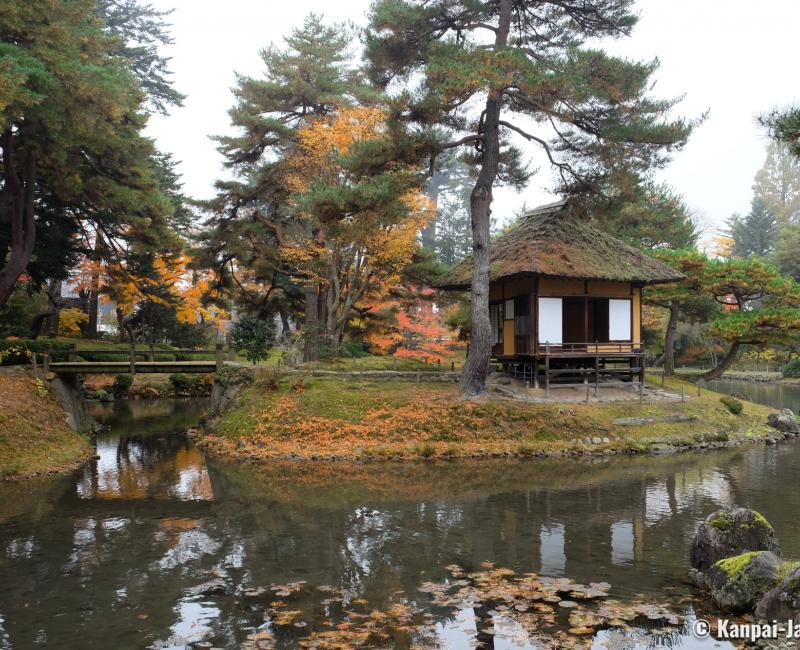
Oyakuen, the medicinal herbs garden
About ten minutes’ walk from Tsuruga Castle, it is highly recommended to visit the lovely Oyakuen seigniorial garden . Specialized in medicinal herbs , it was re-designed in 1696 in a typical Japanese promenade garden , around a main pond, small stone bridges and miniaturized waterfalls. Designated National Place of Scenic Beauty in 1932 and opened to the public in 1953, Oyakuen is a beautiful example of a garden built during the Tokugawa shogunate.
Several tea houses are also arranged in the garden, such as:
- Rakujutei , a small traditional kiosk on the pond’s central inlet, and,
- The large house Ochaya-goten , that was initially composed of three rooms: Kaminoma reserved to the feudal lord, Tsuginoma and Hikaenoma. In 1882, the room Matsunoma, as a reference to the Matsudaira clan who reigned over Aizu for a long time, was added as well as a two-story wing.
Oyakuen is particularly beautiful in autumn , when the koyo 🍁 foliage of the maple trees spread in flamboyant red hues throughout the grounds.
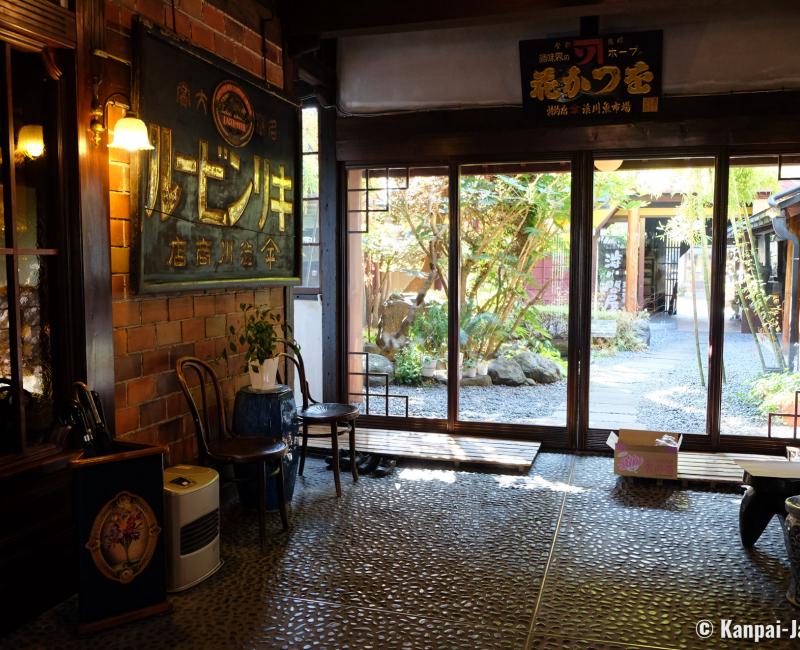
The shopping avenue Nanuka-machi Dori
The scenery changes around Nanukamachi JR station, in Aizu-Wakamatsu’s shopping neighborhood characterized by older times architecture, with:
- Old Japanese warehouses named kura , that now accommodate various local shops, and,
- More recent buildings, with western-style fronts testimony of Japan’s opening during the Taisho era in the early 20th century.
In the main avenue Nanuka-machi Dori vintage shopping amateurs will find a comprehensive overview of the local craftsmanship : hand painted candles ( e-rousoku ) that are decorated with seasonal flowers at Hoshiban, Aizu lacquerware , as well as cotton fabric and its manufacture open to the visit.
As for the local gastronomy, it is represented by sake 🍶 at Suehiro Kaeigura brewery , where it is possible to learn about the Japanese alcohol’s brewing process in a guided tour visiting five kura converted into sake breweries.
Keen visitors might notice tombstones, that seemed abandoned, interspersed between souvenir shops and restaurants. Most of them are affiliated to Amida-ji temple whose grounds lies at the entrance of the district. More than 1,300 warriors of the Aizu clan, who died during the last siege of the castle are entombed here. They used to be protected by a great statue of Buddha, but it was used as war effort material in 1939-1945.
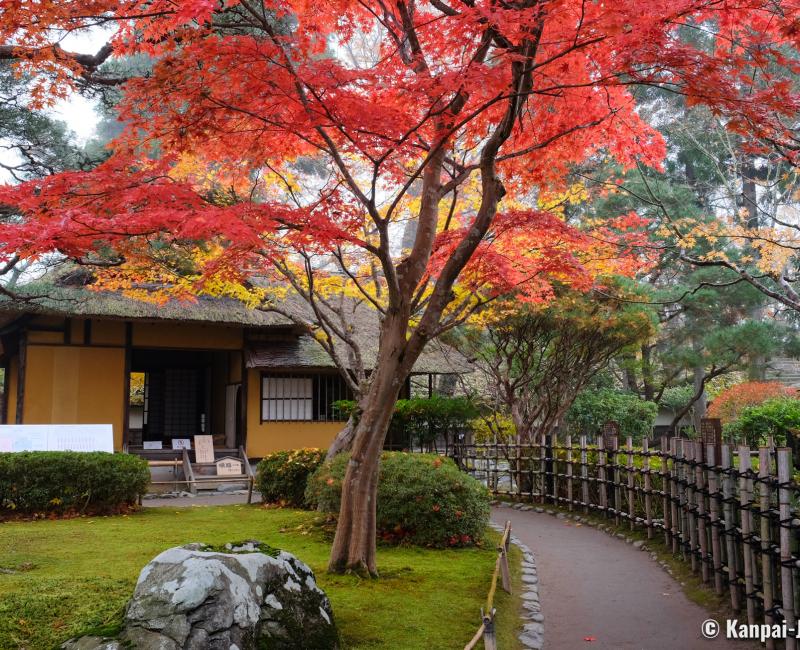
The best of Aizu-Wakamatsu in a few places
Aizu-Wakamatsu is an easy access by train, bus, or car 🚙 . From Tsuruga Catsle’s Park , that is the ideal starting point to discover the city, one can go:
- Toward south, to walk Ouchi-juku main street: this former post house on the Nishi Kaido road connected Aizu Wakamatsu to Nikko during the Edo period and is now renowned for its preserved thatched roof architecture.
- To the north-east of the city’s downtown, to discover the original Sazaedo pavilion , and then climb to the top of Mount Iimoriyama : there contemplate the tombs of the nineteen young warriors of the Byakkotai group, who committed suicide after they (wrongly) thought that their castle was burning and seized by the troops of Meiji emperor in 1868.
- To the east, to walk in Oyakuen garden , then visit the beautiful large reconstitution of the samurai house Aizu Bukeyashiki , and lastly go to Higashiyama Onsen ♨️ to stay one night in a lovely ryokan inn.
We recommend staying one to two days for a better immersion in this Japanese city’s history at the times of the samurai.
- Flights and Airports
- Accommodation
- Transportation
- Internet & Phones
- Budget and money
- Japanese Food
- Visit with Kids
- Seasons: spring / summer / autumn / winter
- Weather forecast
- Time in Japan
- Holidays & Festivals
- Natural Disasters
- Customs and Duties
- Works and Closures
- September 3 -- Anniversary date of Tokyo's establishment after the Meiji restoration in July 1868
- September 16 -- Tsurugaoka Hachimangu (Yabusame) Festival in Kamakura
- September 16 -- Day of the elderly in Japan (Keiro no Hi - holiday)
- September 21 -- Autumn starts in Japan
- September 23 -- Autumn Equinox (Shunbun no Hi - holiday)
- From October 9 to 10 -- Hachiman Matsuri (the Autumn Takayama Festival)
- Tokyo : Shinjuku , Shibuya , Harajuku , Asakusa , Akihabara , Odaiba , Ikebukuro , Ueno , Roppongi , Chiyoda , Ryogoku ...
- Around Tokyo: Kamakura , Nikko , Hakone , Mount Fuji , Mount Takao , Yokohama ...
- Kansai: Kyoto , Nara , Osaka , Mount Koya , Himeji , Kobe , Kinosaki , Kumano Kodo , Ise ...
- Japanese Alps: Kanazawa , Matsumoto , Takayama , Shirakawa-go , Nakasendo ...
- West: Hiroshima , Miyajima , Shikoku , Onomichi , Naoshima , Izumo , Kurashiki , Matsue ...
- South: Kyushu , Okinawa , Yakushima ...
- North: Hokkaido , Tohoku ...

- Temples and Shrines
- Gardens and Parks
- Hiking and Trekking
- Observation Decks
- Public Baths (Onsen and Sento)
- Festivals (Matsuri)
- Amusement Parks
- Visit on a Budget / Luxury

Keikaku is a travel agency specialist of Japan and providing different kind of services:
- Japan Rail Pass
- English speaking Guides
- Pocket Wi-fi
- Japan Nightlife
- Working in Japan
- Religion and Spirituality
- Arts and History
- Movies / Animated Movies
- Japanese Music
- Studio Ghibli
- Photos / Videos
- Weird Japan
- Translations
- Kana & Kanji
- Japanese Swear Words
- Honorific Suffixes (san, kun, chan...)
- Introducing yourself
- Thank you / Apologize
- Count / Say Your Age
- Say the Date / Tell the Time
- Happy birthday
- Enjoy Your Meal
- Writing your name

Kanas are the much-needed basic characters of written Japanese language. Memorize them at a fast pace with our method.

Ask any kind of question and share your knowledge about Japan in Kanpai’s community space, our Q&A section Kotaete.

Isshoni means "together" in Japanese: share your trip details (dates, places you would like to visit) and find companions to travel in Japan.

Create your Kanpai account to manage your profile and view your participation history (questions, answers).
- About Emily
- About This Blog
- Personal Posts
- My Travel Stories
- Central America
- North America
- South America
- Tours and Activities
- Transport and Travel
- Packing Tips
- Travel Gear
- Travel Fashion and Beauty
- Work with me

Aizuwakamatsu Travel Guide
- Last Updated 18 April 2023
Some posts on this site contain affiliate links. If you book or buy something through these links, I earn a small commission (at no extra cost to you). Take a look at my privacy policy for more information.
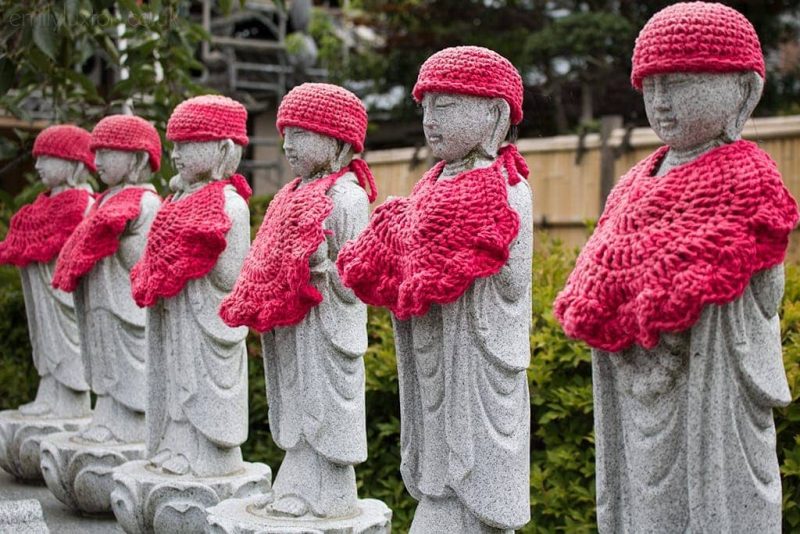
Aizuwakamatsu is a castle city in Japan’s Fukushima Prefecture, a few hours north of Tokyo. Easily reached by train, the city is surrounded by green countryside and sloping mountains. This small but fascinating city has so much to offer – especially in terms of culture and history. Drawing on a rich heritage as Japan’s “Samurai City” , Aizuwakamatsu is a must visit for those interested in learning more about Japanese traditions or martial arts.
Visit a samurai school to learn Japanese archery, or head to an edo-period sake brewery. Explore the famous castle and discover the sad stories of the samurai wars fought around it. Or simply head to the nearby countryside and onsen resorts to relax! My Aizuwakamatsu travel guide tells you everything you need to know to have the perfect two- or three-day trip. This is everything you need to do, see, and eat in Aizuwakamatsu…
How to Get to Aizuwakamatsu
Wait, is fukushima safe, 11 things to do in aizuwakamatsu, more information.
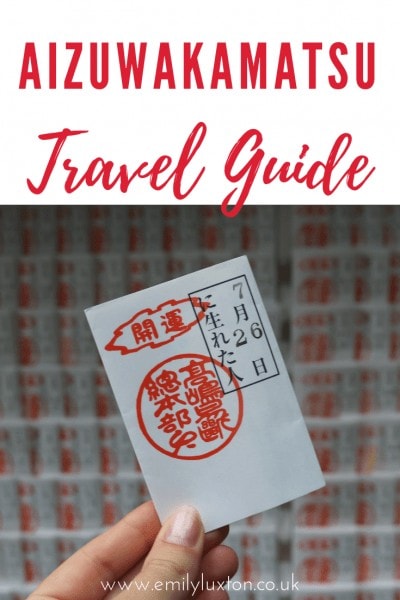
From Tokyo Station, take the JR Tohoku Shinkansen to Koriyama (about 1.5 hours). If you really want to travel in style, book Green Car tickets – the first class of the JR line. At Koriyama the transfer is easy: a huge mural welcomes you to the platform for boarding the train to Aizuwakamatsu. Hop on the JR Ban-etsu West Line to Aizuwakamatsu (about 1 hour 20 mins). It’s the last station so it couldn’t be easier!
The whole journey should take around three hours and there’s only one change – easy! But if you prefer, you can always hire a car (prices start from £15 a day on RentalCars.com ) and drive yourself there. That way you can make the most of the local countryside, and even stop off at some of the small towns around Aizuwakamatsu.
READ MORE: 17 awesome places to get off the beaten path in Japan
Back to Top
Perhaps memories of the 2011 reactor disaster in Fukushima are putting you off travelling to the region. Since I’m no expert, let me point you in the direction of this much cleverer article for peace of mind. But in brief; most of Fukushima Prefecture is safe to return to.
Numerous tests have been carried out and have found that radiation levels in many areas are back to a safe level. Aizu itself is very far from the site of the accident – and “levels in the entire region are now as low as normal background radiation around the world”. So yes, it’s safe to visit Aizuwakamatsu.
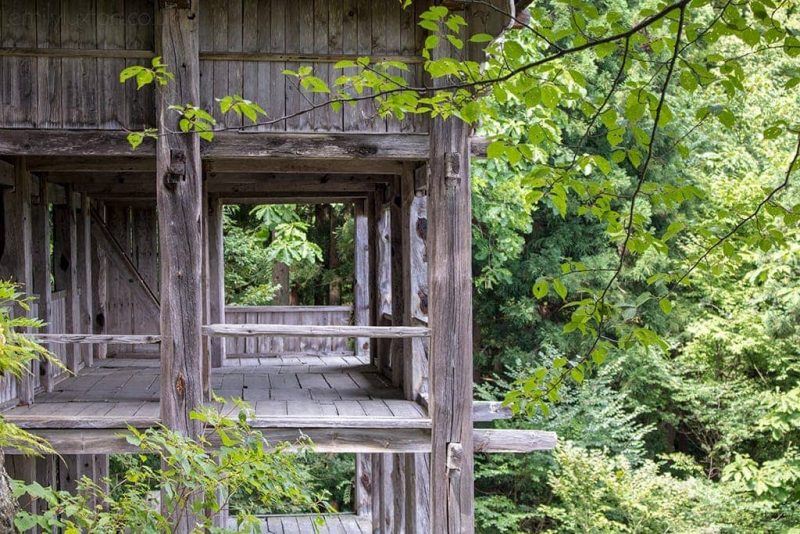
My round-up of the top things to do in Aizuwakamatsu and the surrounding area. This lot should keep you busy for a couple of days…
RECOMMENDED TOUR: Aizu Half-Day Private Trip with Nationally-Licensed Guide , from £65.75
Practice Kyudo (Archery) at the Nisshinkan Samurai School
One of the best things to do in Aizuwakamatsu is to visit the Nisshinkan . This was a school established in 1803 for the children of local samurai families, and it was famous for its high education levels and strict moral code. Today, you can visit to discover all about Aizuwakamatsu’s samurai history. You can also try your hand at kyudo , Japanese archery, which is ideal for those interested in martial arts. Other activities include zen meditation, tea ceremonies, or painting local crafts.
Entry: ¥560 (archery ¥300 for ten minutes). Or you can book this tour with an English-speaking guide through Vitor, from £273.12.
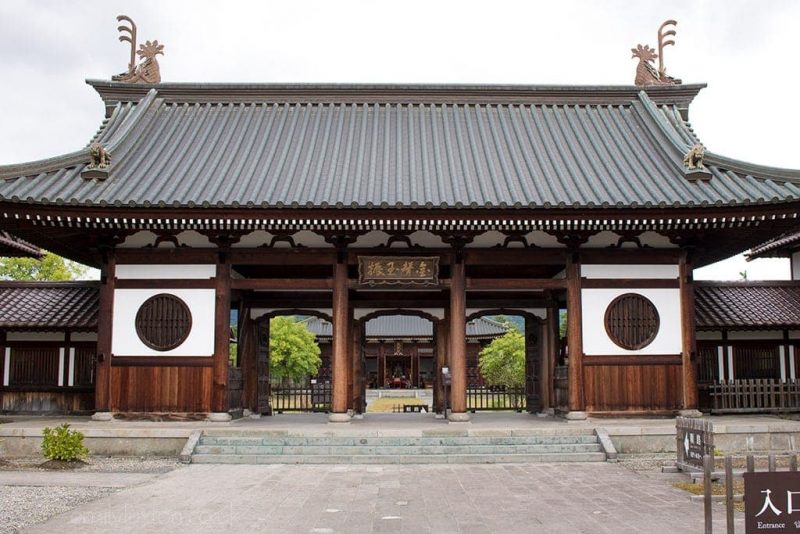
Aizuwakamatsu Castle
Also known as Tsuruga Castle or Tsurugajō, the historic castle at the city centre is known for its iconic red-tiled roofs. This is definitely one of the top things to do in Aizuwakamatsu and an absolute must-see. Again, you can learn all about the fascinating (and often brutal) samurai history of Aizu. And the views from the top of the castle are incredible.
Entry: ¥410, or ¥510 including Tea Room entrance.
Learn the Sad Story of the Byakkotai
One of the most popular, and memorable, stories from Aizu’s recent history is that of the Byakkotai, or White Tiger Batallion. These were a group of samurai fighting in the Boshin War of 1868 – and they were among the last of the samurai in Japan. Retreating from battle, a group of twenty teenaged samurai, all aged around 17 years old, saw Aizu burning from the slopes of Mount Iimoriyama.
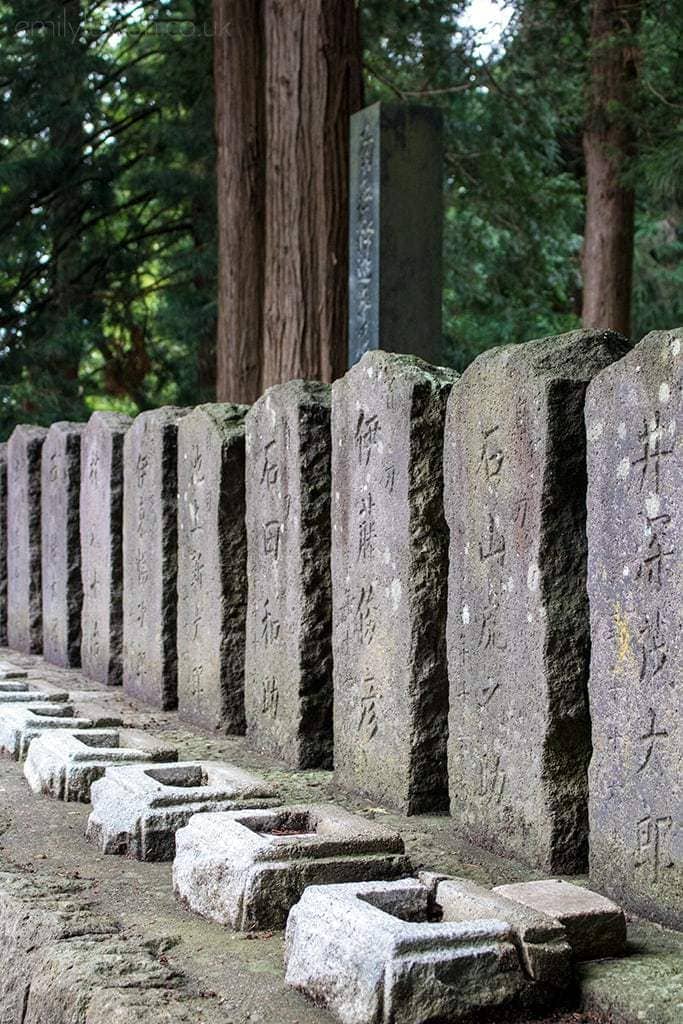
Mistakenly thinking that the castle was also on fire, and that the battle was lost, they followed samurai culture and committed seppuku – ritual suicide – using their own swords. It was important to samurai to die with honour, rather than surrender or be caught. The sad part of the story is that the battle wasn’t lost that day, and the suicides were needless. Because the samurai were fighting the emperor, the government wouldn’t allow their bodies to be buried for over a year – so their remains were left on the side of the mountain where they fell. Today, there is a proper grave and a memorial which you can visit. go with a guide to get the full story, or visit the nearby museum .
Entry: free
Sazaedo Temple
Also on the slopes of Mount Iimoriyama is a fascinating temple that’s truly one of a kind. The tall, spiral-shaped Sazaedo Temple is built entirely from wood and dates from 1796. That’s not the most impressive part, though. It’s unique double-helix structure means that people climbing up the twisting path inside never pass those coming down, as it’s a totally separate path. The temple is pretty amazing, considering when it was built, and is full of history. Definitely a must do in Aizuwakamatsu.
Entry: ¥400
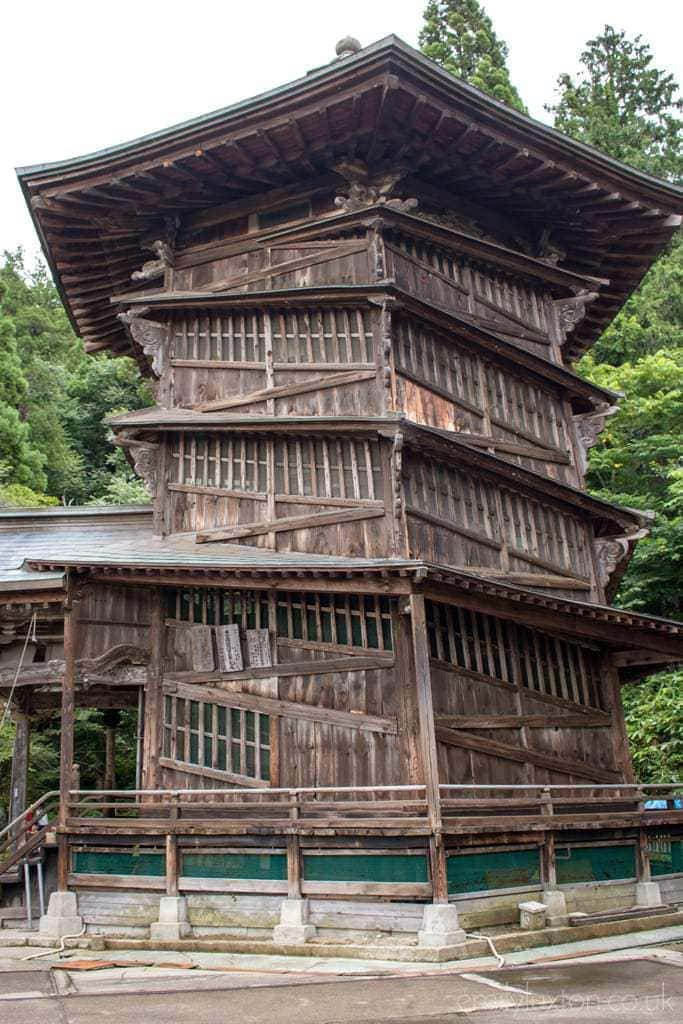
Explore a Samurai Residence
If you want to learn more about the samurai history of the city, the Samurai Residence is another great thing to do in Aizuwakamatsu. Here, you can discover more about every day life as a samurai, and about what life was like during the Edo Period. It’s also a beautiful example of traditional edo period architecture.
Entry: ¥850
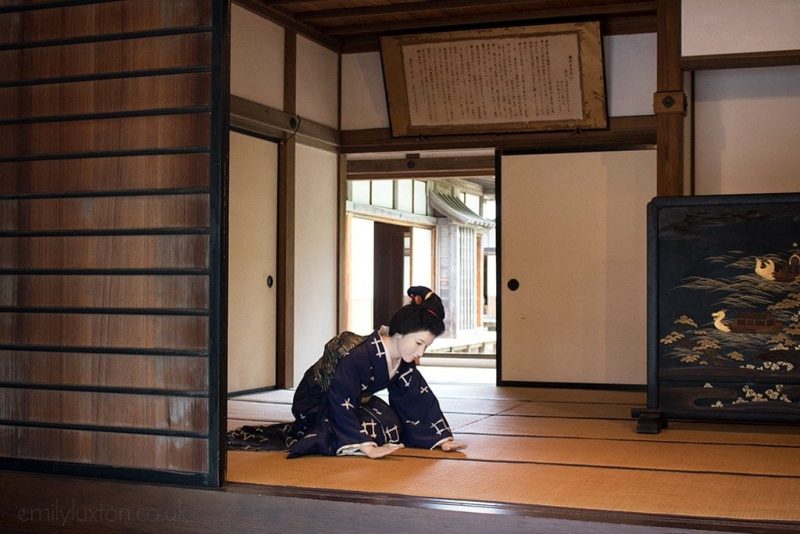
Sake Brewery Tour and Tasting at Suehiro Brewery
Aizu is famed for its sake, thanks to pure waters and fertile rice fields. There are several gold medal winning sake breweries in town, so don’t miss the chance to try a few of the local drinks. At Suehiro Brewery , visitors can enjoy a free tour of the brewery, a lesson in how sake is produced, and an exploration of the upper rooms of this historic brewery. More importantly, you can enjoy a tasting of several of the brewery’s current offerings! Since they don’t export, this is also one of the only places you can enjoy these award-winning sakes.
Entry: Tours and tastings are free – you just show up at one of the scheduled tour times.
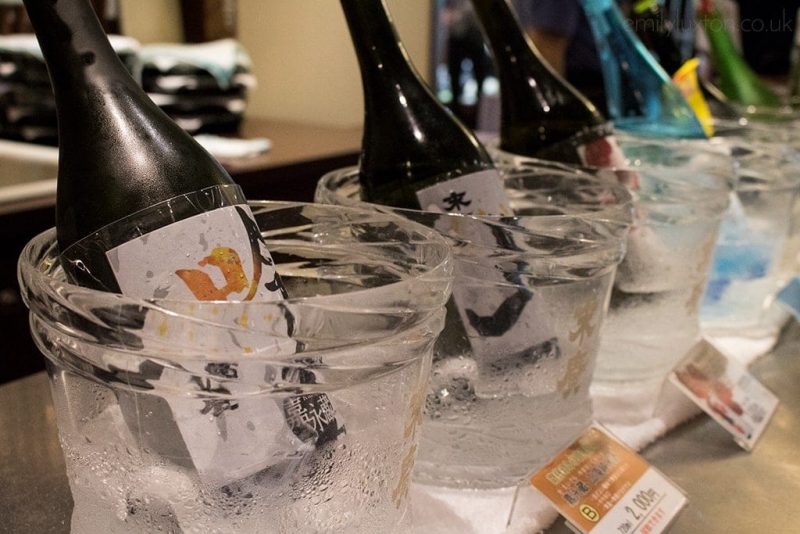
Sakudari Kannon Temple
If you have time, a visit to the Sakudari Kannon temple is one of the best things to do in Aizuwakamatsu. It’s actually a little way out-of-town, down the road in Aizumisato – so you may find it easiest to hire a car to get there. This is another beautiful wooden temple, built to house a statue of Kannon (the Bhuddist goddess of mercy). There are 33 kannon temples around Aizu, which form a local pilgrimage, and this is the 21st on the route. Not only is this centuries-old wooden temple an impressive site, but it’s a great excuse to get out into the beautiful countryside that surrounds Aizuwakamatsu.
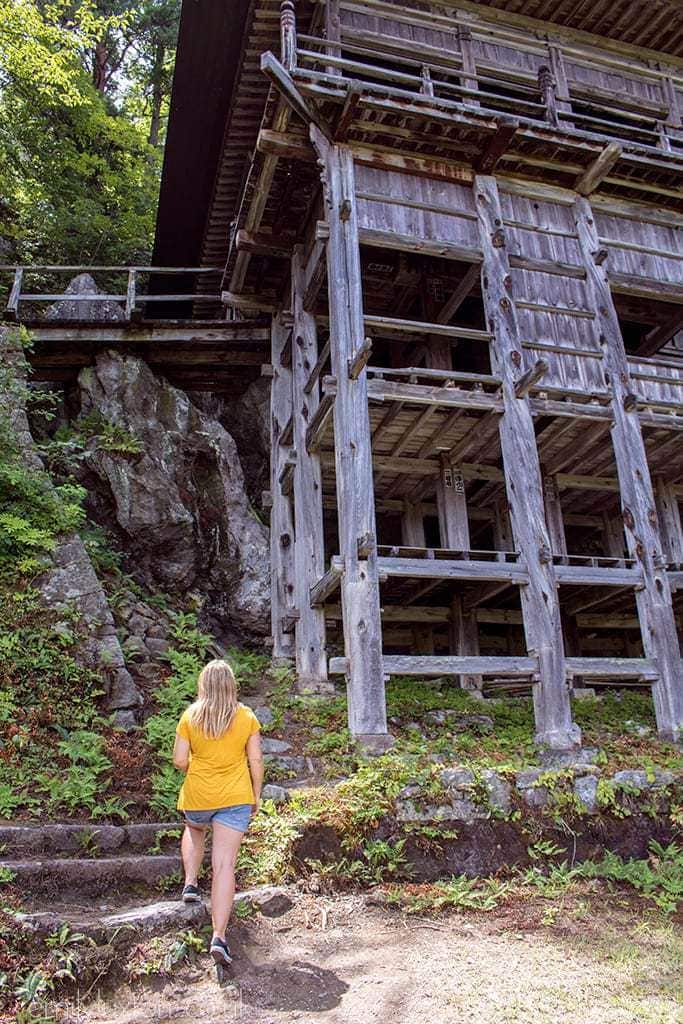
Rent a Kimono in Aizuwakamatsu
It’s hard to resist the idea of a photo-op in a traditional kimono or yukata . Get stuck in to Japanese way of life and spend some time in a kimono – a great way to immerse yourself in the local culture, and look pretty doing it! Rent a kimono in Aizuwakamatsu from Sozai Hiroba and get Instagramming!
Recommended Tour: Samurai Kimono With hair and makeup Professional photography plan , from £124.93
Price: from ¥6,000 + tax
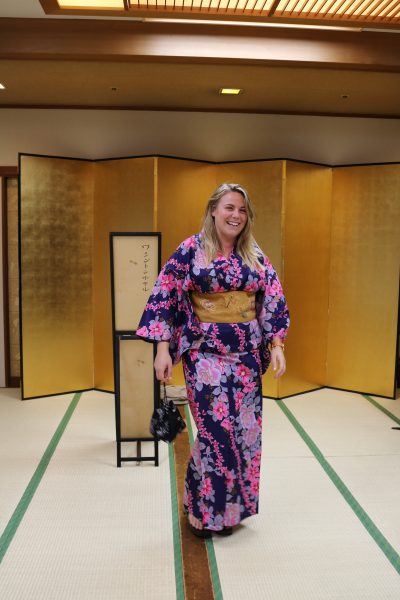
Hit the Traditional Shops on Nanukamachi street
Dotted along Nanukamachi street at the centre of Aizuwakamatsu are dozens of boutique shops and traditional craft stores. It’s the perfect place to pick up a few gifts, and support some local artisans at the same time. My personal favourite was Nagatoya, a traditional sweet shop that’s over 170 years old. If you’re on the hunt for souvenirs, local crafts that you should keep an eye out for include:
- lacquerware
- painted candles
- Aizu cotton cloth (it has a distinctive striped pattern)
- the adorable local folk toy Akabeko (a red cow that I’m obsessed with – you’ll find a giant singing one outside the train station).
- Okiagari Koboshi (another super cute folk toy and a symbol of luck and resilience)
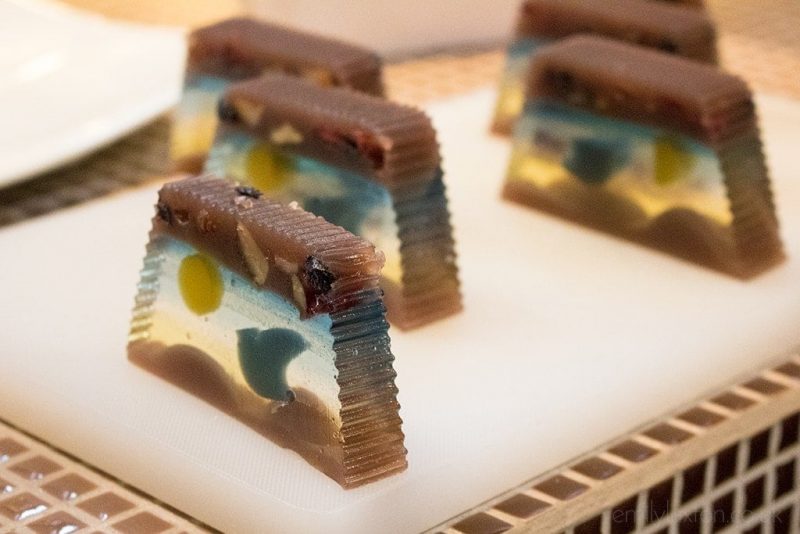
Learn How to Decorate Lacquerware
Lacquerware craft was established in Aizu in 1590 and it’s still a thriving industry in the local area. Head to Suzuzen to try your hand at one of the more creative things to do in Aizuwakamatsu! You can choose a piece of ready-made lacquerware to decorate using coloured powders and varnish. It’s a delicate process, but perfect for creative types. And you’ll be left with a brilliant souvenir of your time in Japan.
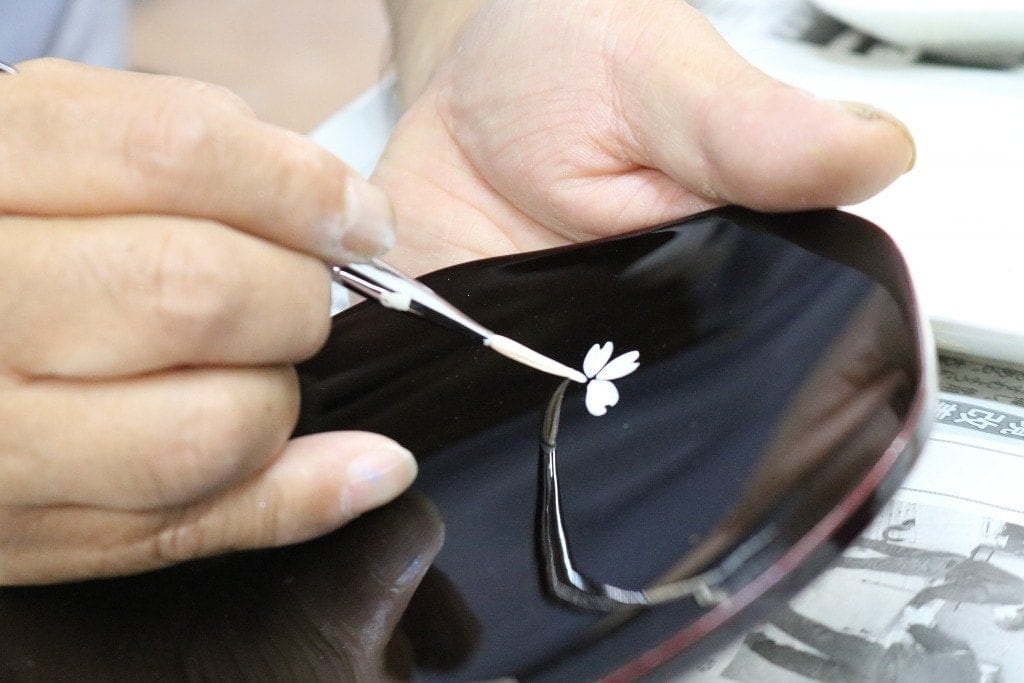
Price: ¥1,600 to ¥2,500 (depending on which item you want to paint). You need to make a reservation before arriving.
Recommended tour: Half-day tour experiencing local crafts in Aizu .
Relax at Higashiyama Onsen
If all that culture and history leaves you in need of some relaxation time, you’re in luck. Aizuwakamatsu is blessed with natural hot springs, which are surprisingly close to the city centre. To best enjoy them, spend a night or two at an onsen hotel, or ryokan, at Higashiyama Onsen.
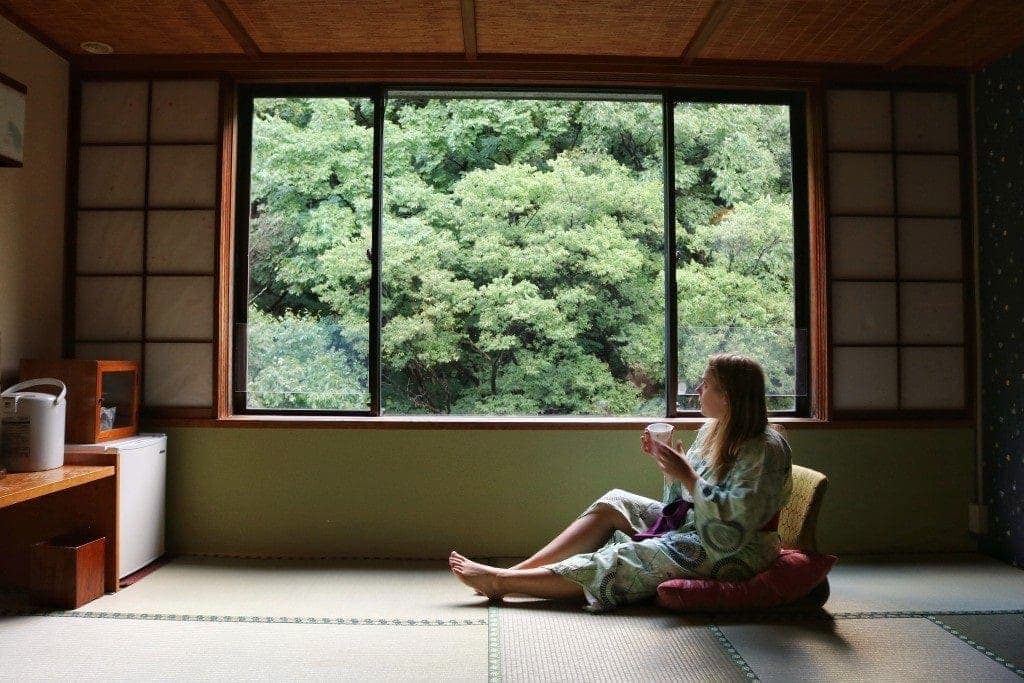
I stayed at Harataki Ryokan which is a gorgeous, traditional hotel with rooms overlooking the Yugawa mountain stream. Views of thick forest greenery and the sound of rushing water are the perfect way to relax… and the onsens themselves are glorious. There’s an outside bath nestled into a private corner right beside the river, from which you can have a view of one of the small waterfalls that dot the river.
Price: From £140 GBP per night. Check prices on Hotels.com or Booking.com .
Best Restaurants in Aizuwakamatsu
Every region of Japan has its own local delicacies and speciality cuisine, and Aizu is no different. Below, I’ve rounded up some of the must-try local dishes in Aizuwakamatsu and recommended some of the best places to find them. Enjoy…
Must Try Dishes in Aizu
- Sauce Katsudon – a breadcrumbed pork cutlet, deep-fried in a special sauce, and served on a bowl of rice and shredded cabbage. This is Aizu’s signature dish and should not be missed!
- Kitakata Ramen – characterized by unique, firm noodles, ramen from the small town of Kitakata is among the most popular styles of ramen in Japan, so it’s a must-try in Aizuwakamatsu.
- Wappameshi – a local dish of rice, fish, and veg steamed in a circular wooden box.
- Aizu beef – less famous than kobe beef, but equally as delicious!
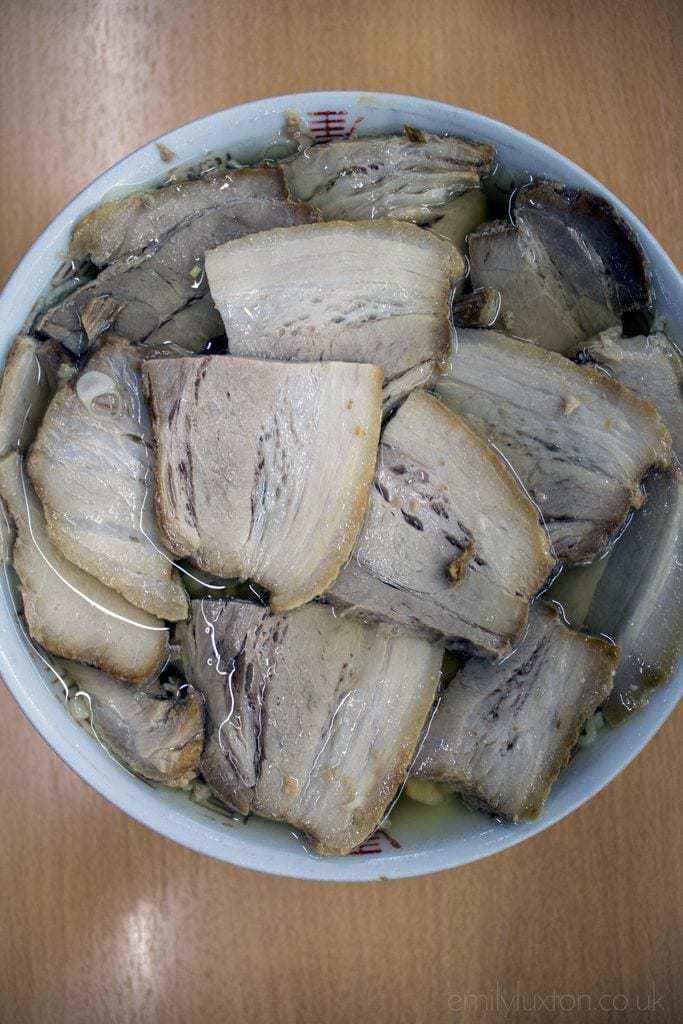
- Horse sashimi – raw chunks of local horse meat. Perhaps not super tempting to Westerners, but surprisingly tasty. Enjoy with sake.
- Dengaku – skewers of food basted in miso and grilled over an open flame. Apparently a samurai staple once.
- Nishin Sansho-zuke – dried herring fillets sandwiched between sansho leaves and pickled in vinegar, sake, and soy sauce.
- Kozuyu – a regional speciality and a must at wedding feasts in Aizu. It’s a hearty soup veggies, shiitake mushrooms, and balls of wheat gluten.
- Peaches – the region of Aizu is known for its peaches, which are huge and super juicy.
One of the best restaurants in Aizuwakamatsu is Takino . It’s housed inside a beautiful, restored house that’s around 200 years old, and is a must-visit. They serve up an array of Aizu’s most traditional dishes, and this is probably the best place to try both wappameshi boxes and kozuyu. I had the most enormous and delicious lunch here – don’t miss it!
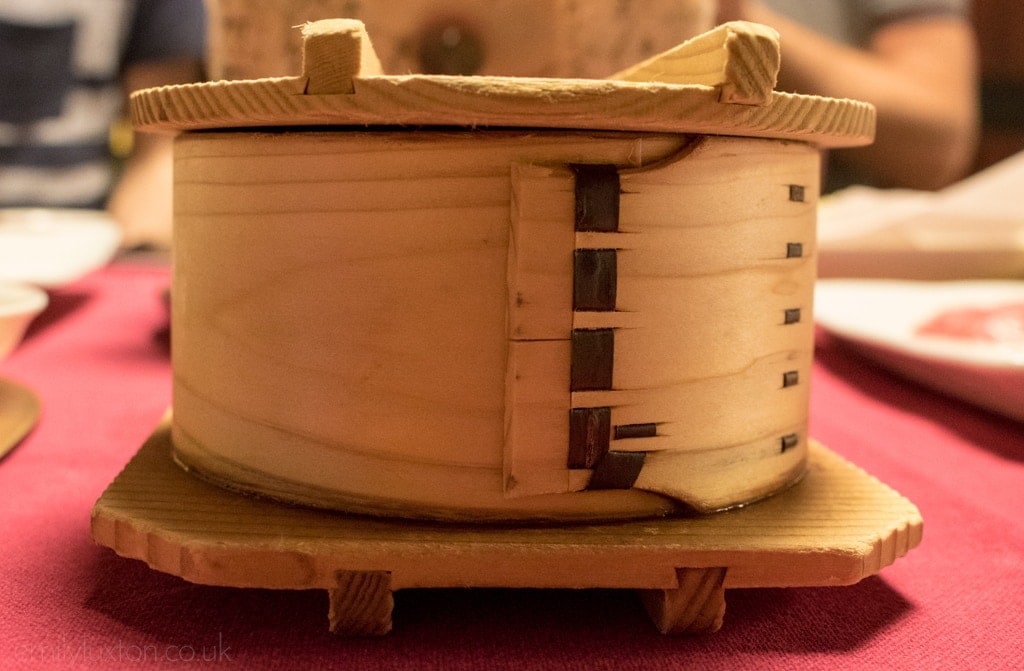
Bannai Shokudō
In the neighbouring town of Kitakata you’ll find this insanely popular little ramen joint! Bannai Shokudō is actually part of a chain, but it was born right here in Kitakata and is the reason why the Kitakata ramen style is so famous. Although there are many places to try Kitakata ramen, this is probably the most iconic. Go early as there’s usually a queue every morning and at lunchtime.
If you’re looking for the best place in town to try sauce katsudon, Jumonjiya is right up there. Every restaurant has its own secret recipe for the sauce, so it’s always different. But you can’t go wrong with Jumonjiya – my serving of sauce katsudon was amazing. Be warned – you’re going to need ALL your inner samurai strength just to pick up the enormous pork cutlets with chopsticks, let alone finish the dish!
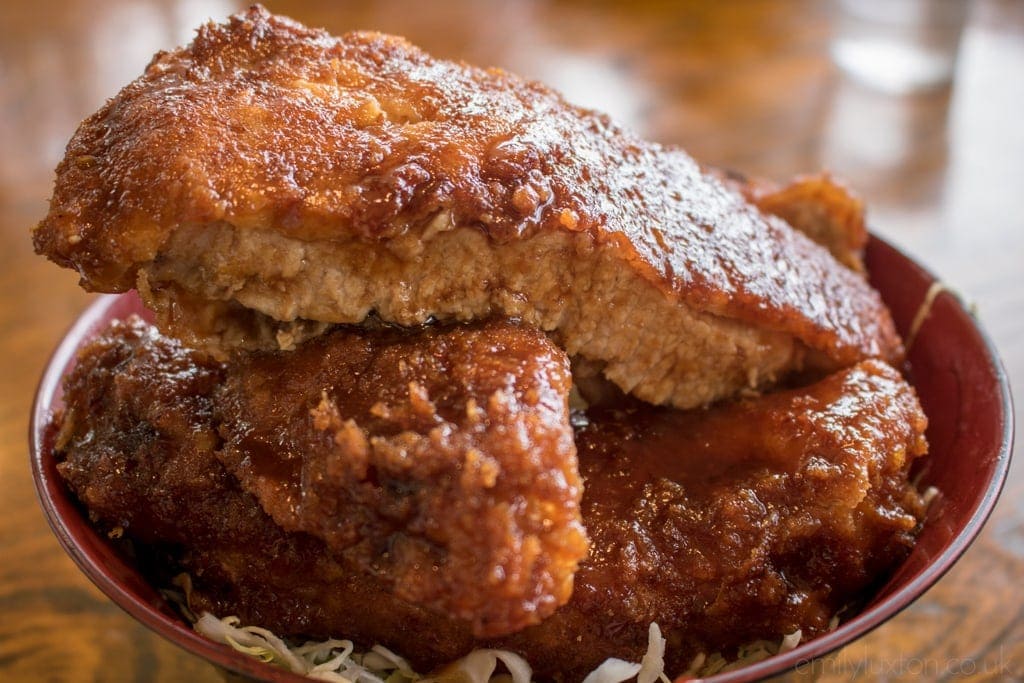
Harataki Ryokan
If you’re heading to Higashiyama Onsen, Harataki Ryokan is a great spot for dinner. Waterside dining in a lovely restaurant with lots of traditional local dishes to try.
Back in the city centre, Mitsutaya is one of the best places to try those super tasty dengaku skewers. You can sit at a stool around the kitchen and watch your chef grill the skewers over an open flame. I recommend trying one of everything – it’s all delicious!
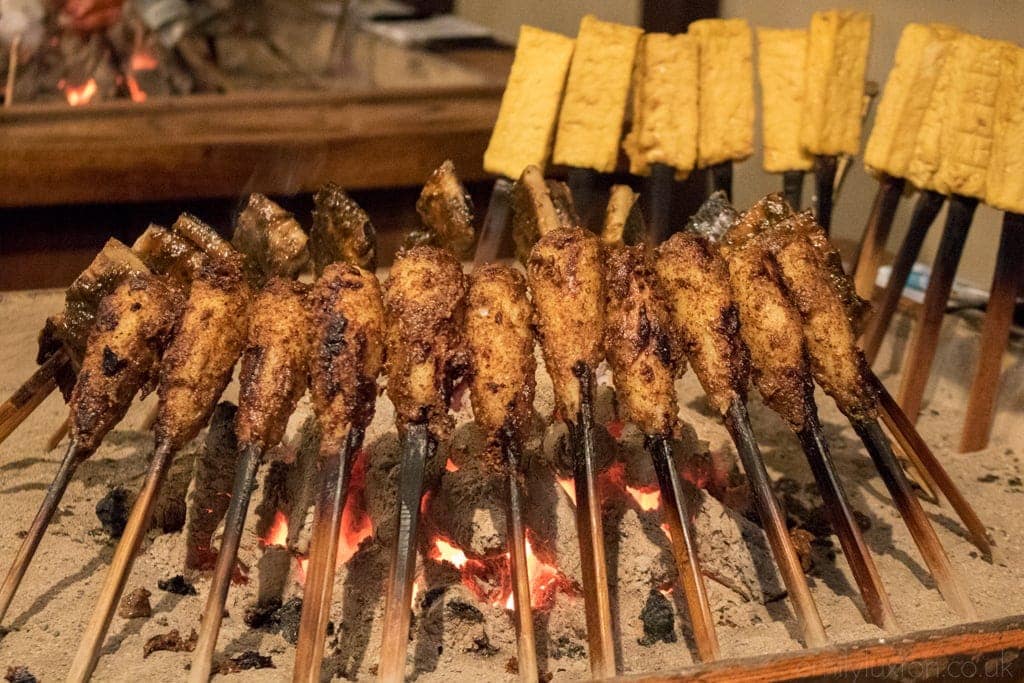
Izakaya Hairansyo
A cosy, traditional local spot, Izakaya Hairansyo is the perfect place to discover local snacks like Nishin Sansho-zuke and horse sashimi. Be sure to order some of the local sake to wash it all down. They have dozens of bottles for you to try!
If you need assistance, or want to pick up an English map, head to the local tourist office. There’s one at Aizuwakamatsu Station, or at Tsurugajo Castle. Check out the city’s official websites below for more information.
Aizuwakamatsu Tourism Bureau
Samurai City – Aizuwakamatsu Tourist Website
17 off the beaten path destinations in Japan
Some of the links in this post are affiliate links which support the running of my site, but don’t affect the price you pay at all. All the tours I’ve recommended are from my affiliate partner, Voyagin. I trust them and have always had great experiences with their tours.
My trip to Aizuwakamatsu was organised by All About Japan and the local tourist board. But, as always, all words and opinions are my own!
Pin This Post!
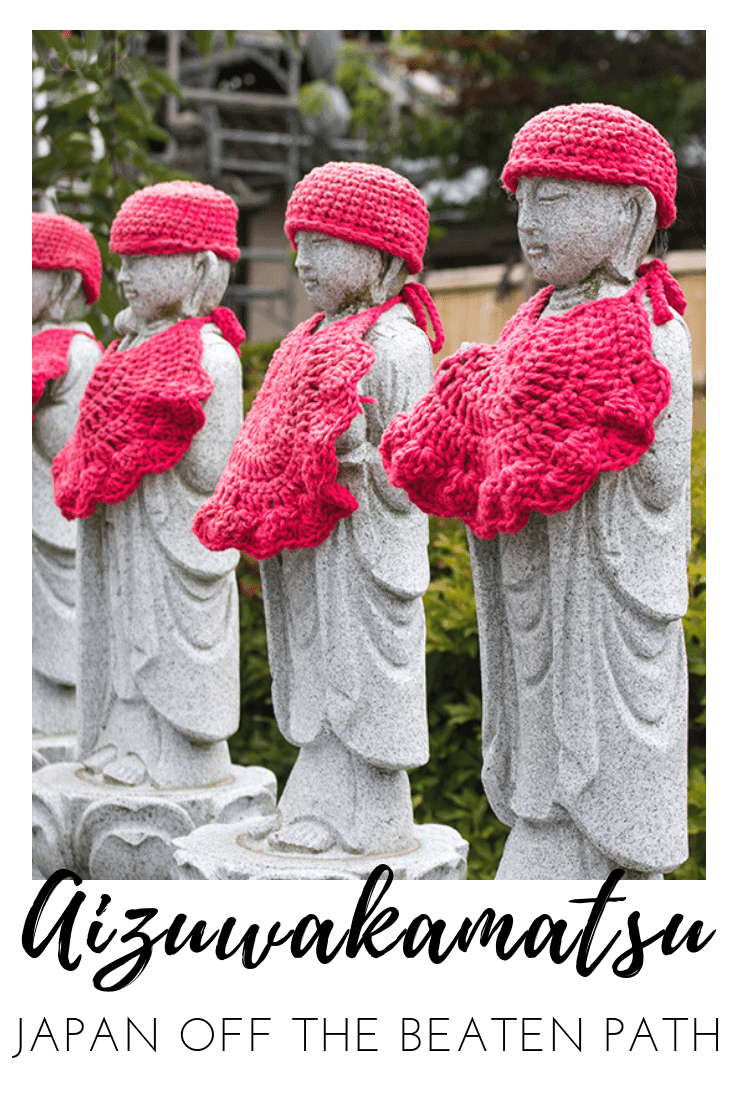
Related Posts
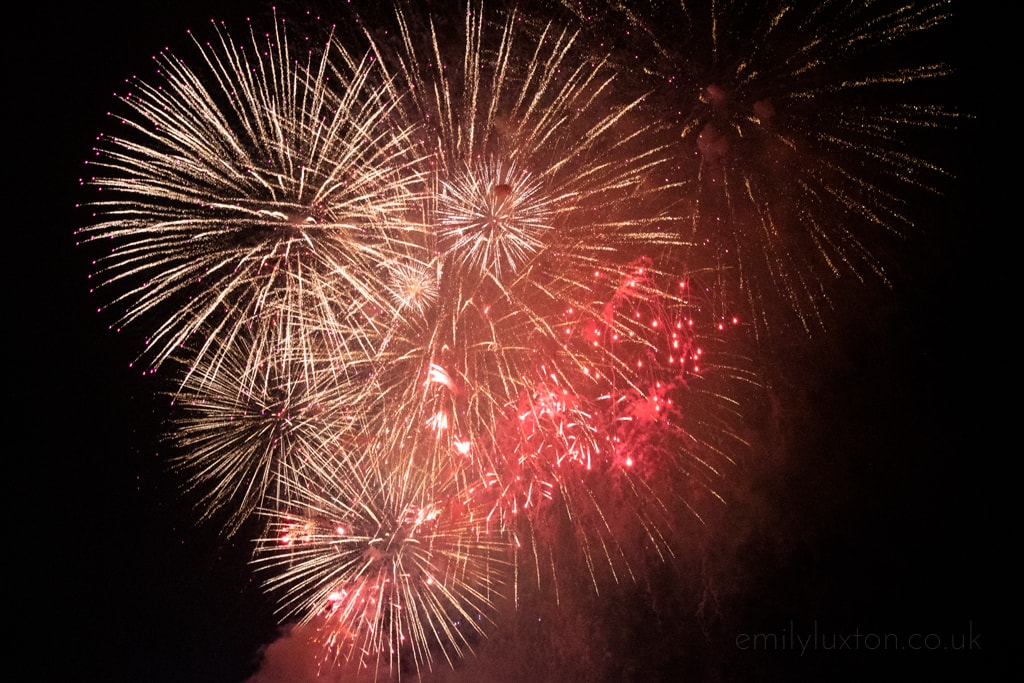
Edogawa Fireworks Festival – Blown Away in Tokyo!
- Japan , My Travel Stories
- Last Updated 25 March 2021
A surreal experience at Edogawa Fireworks Festival in Tokyo – an incredible even which turned out to be much bigger than I expected!

8 Utterly Bonkers Tokyo Food Adventures
- Last Updated 14 July 2023
Looking for the craziest things to do in Tokyo? Don’t miss my round up of Tokyo themed cafes and other bonkers foodie experiences!
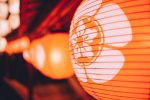
17 Off the Beaten Path Destinations in Japan
- Last Updated 21 August 2024
A bunch of awesome travel bloggers share their recommendations for exploring Japan off the beaten path. Add these destinations to your Japan itinerary!
2 thoughts on “Aizuwakamatsu Travel Guide”
Thanks for the detail record of the places. I will be going this December, and I have found your information very helpful.
Oh that’s awesome to hear – have an amazing time!
Leave a Reply Cancel reply
Your email address will not be published. Required fields are marked *
This site uses Akismet to reduce spam. Learn how your comment data is processed .
Aizuwakamatsu

- 1.1 Tourist Information
- 2.1 By plane
- 2.2 By train
- 3 Get around
- 4.1 Nanokamachi Street
- 4.2 Iimoriyama
- 5.1 Higashiyama Onsen
<a href=\"https://tools.wmflabs.org/wikivoyage/w/poi2gpx.php?print=gpx&lang=en&name=Aizuwakamatsu\" title=\"Download GPX file for this article\" data-parsoid=\"{}\"><img alt=\"Download GPX file for this article\" resource=\"./File:GPX_Document_rev3-20x20.png\" src=\"//upload.wikimedia.org/wikipedia/commons/f/f7/GPX_Document_rev3-20x20.png\" decoding=\"async\" data-file-width=\"20\" data-file-height=\"20\" data-file-type=\"bitmap\" height=\"20\" width=\"20\" class=\"mw-file-element\" data-parsoid='{\"a\":{\"resource\":\"./File:GPX_Document_rev3-20x20.png\",\"height\":\"20\",\"width\":\"20\"},\"sa\":{\"resource\":\"File:GPX Document rev3-20x20.png\"}}'/></a></span>"}'/>

Aizuwakamatsu (会津若松) is the main city in the Aizu region of Fukushima Prefecture , in the north of Honshū island, the largest of Japan . With a population of 120,000, Aizuwakamatsu has a rich warrior history, stretching back 1,000 years. Although the city is most known for the Byakkotai, a force of about 300 young samurai (13-17 year olds) in the Boshin Civil War. Nineteen of them committed suicide, declining surrender. Today, sake and lacquerware are the two main industries in Aizuwakamatsu. The Aizu region has spectacular natural scenery. Most visitors also make a journey to Mt. Bandai and Inawashiro for skiing, fishing and onsen.
Tourist Information
- 37.507679 139.930329 1 Aizu Wakamatsu Station Tourist Information Center ( 会津若松駅観光案内所 ). Has pamphlets, maps, and information about local sights, restaurants, and events. If you are a guest staying at any of the ryokan in Higashiyama Onsen or Ashinomaki Onsen, they have a baggage delivery service that will take your baggage to your hotel so you can enjoy the day sightseeing and collect your bags when you check-in. ( updated Feb 2024 )
- 37.498665 139.928556 2 Aizu Area Information Center ( あいづ広域観光情報センターiらんしょ ). Pamphlets, maps, and information about each of the cities and towns in the Aizu Region (Western Fukukushima Prefecture). ( updated Feb 2024 )
- SAMURAI CITY Aizuwakamatsu is the city's official multilingual guide site.

Fukushima Airport only has flights to Osaka Itami Airport and Sapporo Chitose Airport. If you're using this airport, there are buses from the airport to Koriyama Station where you can catch a train bound for Aizu-Wakamatsu Station. For most travelers, Sendai Airport or one of Tokyo's airports will be more convenient. Sendai Airport has buses that travel directly to Aizu-Wakamatsu Station. If you fly into Tokyo, you can transfer to the Shinkansen or take a bus (see below).
The fastest and most convenient way to access Aizuwakamatsu is to take the Shinkansen from Tokyo to Koriyama, and transfer to the Ban-etsu Saisen Line. It takes about 3 hours and ¥9480.
Tobu Railway and Aizu Railway also serve the area. Although Tobu Railway runs from Asakusa in Tokyo, it takes a lot more time to reach Aizu Wakamatsu than using JR, so these will be most useful for people in the Nikko/Kinugawa Onsen area or those who purchased travel passes from these railways.
JR East offers a direct highway bus service to Aizuwakamatsu from Tokyo 's Shinjuku Highway Bus Terminal (located near the New South Exit of Shinjuku Station) to Aizuwakamatsu Bus Terminal (located opposite Aizuwakamatsu Station). There are also limited connections from Tokyo Station. It takes about 4 hours with 2 rest stops along the way. A one-way ticket costs around ¥2,500 and can be purchased at any JR ticket office.
There are also buses from Niigata and 4-6 departures arrive per day from Sendai . From Nagoya , there is a night bus to Koriyama from which you can catch a train to Aizu-Wakamatsu Station.
From within the prefecture, there are also buses from Iwaki .
To visit the major sightseeing spots, take the Sightseeing Bus from Aizuwakamatsu Station. You can buy a one-day pass for ¥500. There are two loop buses that go in opposite directions around the same route, so make sure your bus is going in the direction that will get you to your destination the fastest. If you're more adventurous (or if the bus times work against you), it takes about 40 minutes to walk to the castle or Iimoriyama and the Sazaedo from Aizu Wakamatsu Station.

- 37.485546 139.953534 5 Samurai Residence ( 会津武家屋敷 ). A preserved samurai estate featuring a teahouse, magistrate's office, a warehouse, and a rice mill in addition to the Aizu chief retainer's house. There is also a restaurant and a gift shop, and visitors can participate in a variety of hands-on activities throughout the year. ( updated Feb 2024 )
- 37.4847 139.911071 6 Kagetsu-tei Garden Museum ( 可月亭庭園美術館 ). ( updated Feb 2024 )
Nanokamachi Street
A historic street with a variety of nostalgic buildings and sites related to Hideyo Noguchi, a man who did research in bacteriology and whose face is on the 1000 yen bill, and the Shinsengumi.
- 37.497606 139.927181 7 Hideyo Noguchi Seishunkan ( 野口英世青春館 ). A former hospital built in 1897. It's where Hideyo Noguchi's hands were treated at age 16 that gave him full use of his hands for the first time. When he was one year old, he suffered a burn that caused his left hand to remain clenched. The doctor's ability to return his hand to normalcy is said to have been what inspired him to study medicine himself. The buildings today has a museum dedicated to Noguchi on the second floor and a cafe on th first floor. ( updated Feb 2024 )
- 37.496295 139.930328 8 Sakaemachi Church ( 栄町教会 ). The church where Hideyo Noguchi was baptized at age 18. ( updated Feb 2024 )
- 37.498657 139.923854 9 Hideyo Noguchi's Baptism Spot ( 野口英世洗礼の地 ). This is the original spot where Sakaemachi Church stood when Hideyo Noguchi was baptized. He also learned English and met his first love here. ( updated Feb 2024 )
- 37.500539 139.921318 10 Aizu Shinsengumi Memorial Hall ( 会津新選組記念館 ). Located on the 2nd floor of an antique shop, the museum features artifacts from the Shinsengumi, the battles they fought in, and art and documents related to them. ¥300 . ( updated Feb 2024 )
- 37.500427 139.919338 11 Hajime Saito Grave Monument ( 斎藤一の墓 ). The grave of the leader of the Shinsengumi in the grounds of Amidaji Temple. ( updated Feb 2024 )

Mt. Iimoriyama (飯盛山) is famous for its associations with the Byakkotai (白虎隊, meaning White Tiger Force). After being defeated in a battle against the imperial forces, nineteen teenagers of the Byakkotai retreated to this hill. When they saw Tsuruga Castle burning, they thought it had fallen to the enemy and committed suicide. Their graves are on Mt. Iimoriyama where incense is always burnt on their behalf. Visitors can walk up the many steps to see the graves, or take the escalator for ¥250.
- 37.504404 139.953158 13 Byakkotai Museum ( 白虎隊記念館 ). ¥400 . A private collection of exhibits related to the Boshin War and the Byakkotai. ( updated Feb 2024 )
- 37.505122 139.952327 14 Byakkotai Legendary Museum ( 白虎隊伝承史学館 ). Over 5000 artifacts are on display from the Byakkotai, Shinsengumi, and Boshin War. ¥300 . ( updated Feb 2024 )
- 37.504912 139.954386 15 Tonoguchi Weir Cave ( 戸ノ口堰洞穴 ). It looks like a small spring, but is actually part of an ancient irrigation tunnel. It took over 50,000 men over 3 years to dig here from Lake Inawashiro. It is best known today as the tunnel used by the Byakkotai to escape after their defeat from the Battle of Tonoguchihara. Upon emerging from the tunnel, they saw smoke around Tsuruga Castle and believed the entire domain had fallen. ( updated Feb 2024 )
- 37.503226 139.95407 16 Byakkotai Hara-kiri Memorial ( 白虎隊自刃の地 ). A statue and monument built over the sight where the 20 Byakkotai soldiers saw the burning castle and committed ritual suicide however, it is believed that only 16 of them succeeded here. Three of them are thought to have died later either in battle or suicide elsewhere and one was rescued as he was attempting to kill himself here and nursed back to health. It was this survivor who recounted the story that people know today. ( updated Feb 2024 )
- 37.503949 139.954393 17 Byakkotai Graves ( 白虎隊の墓 ). Graves for each of the 19 boys who committed suicide on October 8, 1868 (the date written reads August 23 which is from the old lunar calendar used at the time. It coincides with October 8 on modern calendars) when they believed their castle had fallen to the enemy. Villagers hid their bodies in a nearby temple so that they would not be defiled by the Western Army and later returned to Iimoriyama in 1989. Each of the boy's names are written on one of the small gravestones. Additionally, there are graves for other Byakkotai soldiers who died in battle. ( updated Feb 2024 )
- 37.503876 139.954315 18 Monument from the City of Rome ( ローマ市寄贈の碑 ). A monument made from the pillar of a temple that was uncovered from the ruins of Pompeii dedicated in 1928 by Benito Mussolini who found the story of the Byakkotai inspiring. It reads, "Rome, Mother of Civilization, pays its undying respect to the brave Byakkotai by displaying the axe of the Fascist Party symbol, representing the authority of ancient Rome, and commemorating the thousand-year-old ancient symbol of eternal greatness". On the reverse side, it originally said, "Dedicated to the Spirit of Bushido", but this was etched out by the occupied forces after WWII. Just like the German monument, this one was removed and later returned, and is viewed as a timeless dedication, connecting the greatness of Aizu to the greatness of ancient Rome over its ties to Mussolini. There is a lot of pride in foreign recognition of Aizu's great warriors. Its historic importance as a relic from Pompeii also distracts from its donors. ( updated Feb 2024 )
- 37.503934 139.954271 19 Byakkoitai German Monument ( 白虎隊ドイツ記念碑 ). A monument gifted to the city by Hasso von Etzdorf, a diplomat from Nazi Germany who was inspired by the story of the Byakkotai and felt it spoke to the German condition of the time. It reads, "To the young samurai warriors of Aizu". The monument was removed by occupying American forces after WWII however, it was returned after the 1951 San Francisco Peace Treaty restored sovereignty to Japan. This monument is viewed positively as showcasing that the story of the Byakkotai has international reknown, as a timeless gift from Germany rather than a gift specifically from one regime. To this point, the reason given for its return to Iimoriyama along with the Roman monument was to "once again connect the spirit of Aizu to the world". ( updated Feb 2024 )
- 37.506223 139.952831 20 Former Takizawa Honjin ( 旧滝沢本陣 ). A resthouse that was used as a headquarters during the Boshin War. The Byakkotai left here to fight in the Battle of Tonoguchihara. ( updated Feb 2024 )

- 37.498887 139.949936 1 Akabeko Crafter Bansho ( 赤べこ製造処番匠 ). One of Aizu's most famous souvenir, the Akabeko, is produced here, and they offer visitors the opportunity to paint their own Akabeko. Alternatively, you can paint a bell of the town's mascot, Aka-bee. No reservation necessary. They also have a shop where you can buy Akabeko and other Aizu souvenirs. ¥1300 to paint your own Akabeko or Akabe . ( updated Feb 2024 )
Higashiyama Onsen
A picturesque onsen area that is said to have been founded over 1300 years ago by the Priest Gyoki. Higashiyama Onsen has geisha (called geigi ). They are famous for their sad dance in honor of the death of the Byakkotai boys. These geisha can be reserved for ¥15,000 per performer for 90 minutes. The water at Higashiyama Onsen is sulfate (specifically sodium-sulphate) which is said to be good for the skin, healing cuts, and high blood pressure. For those who want to enjoy the onsen without staying in Higashiyama, nine of the hotels and ryokan have hours for day visitors to enjoy the hot springs.
- Tokaichi Market ( 十日市 ). January 10 . A New Years tradition for over 400 years, the market center's around purchasing Okiagari Koboshi. ( updated Feb 2024 )
- Aizu Painted Candle Festival ( 会津絵ろうそくまつり ). The second Saturday in February and the Friday before it . ( updated Feb 2024 )
- Aizu Higanshishi ( 会津彼岸獅子 ). Held on the day of the Spring Equinox . ( updated Feb 2024 )
- Higashiyama Onsen Oyukake Festival ( 東山温泉お湯かけまつり ). August 10 . Geisha from Higashiyama Onsen, known as geigi , are carried in portable shrines and throw water from the onsen (oyukake) onto onlookers. ( updated Feb 2024 )
- Higashiyama Onsen Bon Odori , 東山温泉盆踊り . August 12 . ( updated Feb 2024 )
- Aizu Festival ( 会津まつり ). Late September . Events are held around the castle along with a parade in the town ( updated Feb 2024 )

Akabeko (赤べこ) - In the local Aizu dialect, "Akabeko" literally means "red cow". Akabeko has become the symbol of the Aizu region due to two local legends. First, during the construction of Enzo-ji Temple, red cows worked tirelessly to help move wood. Second, children who possessed a wooden toy Akabeko survived a plague that killed thousands of children. Wooden Akabekos similar to those featured in the latter legend can be bought. The most common design features a "bobbing" head mechanism where the head of the cow bobs. A large Akabeko can be found outside Aizuwakamatsu train station. Akabeko can be found at most souvenir shops throughout the city, but for the best variety in terms of number and size options, visit the Akabeko Crafter Bansho (See "Do" above).
Okiagari Koboshi (起き上がり小法師, literally "getting up apprentice") - A 400 year old pear-shaped, roly-poly craft with a happy face traditionally found wearing red or blue. Originally, these were purchased at the Tokaichi Market on January 10th as part of Aizu's New Years tradition. The proper way to buy them was to get one for each member of your family plus one more in hopes of blessing the family with a new child. For example, a family of 3 should buy 4 dolls. The Tokaichi Market is still held today, but Okiagari Koboshi can be bought any time of the year at most souvenir shops. A yellow version has also appeared since the 2010s.
- 37.499392 139.925119 1 Nozawa Mingei ( 野沢民芸 ). A shop where many local craft products are produced. You can buy 3 different sizes of Okiagari Koboshi, 8 different sizes of Akabeko, Aizu Tenjin dolls, masks, and other products. They also have their own unique varieties of traditional goods such as an Edvard Munch "The Scream" Okiagari Koboshi and a "Handsome Blossom" variant of Akabeko which was featured in the NHK drama Yae no Sakura. ( updated Feb 2024 )
- 37.501636 139.926081 2 Yamada Mingei Kojo ( 山田民芸工房 ). Self-advertised as an Okiagari Koboshi producer, they have the traditional varieties as well as versions that look like Doraemon, Pikachu, etc. They also offer visitors the option to paint their own Okiagari Koboshi for ¥800. ( updated Feb 2024 )
Aizu Wakamatsu is famous for its Sauce Katsudon , pork cutlets covered in a sweet sauce served with shredded cabbage over rice. Eggs are an optional local addition.
- Agemanju . "Age" means deep-frying and "Manju" means Japanese style bun stuffed with adzuki bean paste. Therefore, Agemanju means deep-frying Japanese style bun stuffed. It is a traditional sweet in Aizuwakamatsu and it is sweet and soft, but it has high calories because of frying. It is especially popular among children and older people. There are a lot of shops which sell Agemanju about ¥100. ( updated Jul 2017 )
- 37.502215 139.929053 1 Wakamatsu Shokudo ( 若松食堂 ). 11:00-20:00 . A popular sauce katsudon restaurant. ( updated Feb 2024 )
- 37.489506 139.93756 2 Sumire Shokudo ( すみれ食堂 ). A popular restaurant, offering ramen, udon, and sauce katsudon sets. ( updated Feb 2024 )
- 37.507504 139.931707 3 Marumo Shokudo ( マルモ食堂 ). A ramen and sauce katsudon restaurant conveniently located near Aizu-Wakamatsu Station. ( updated Feb 2024 )
- 37.495537 139.931359 1 Jazz Cafe Dorothy ( じゃず喫酒ドロシー ). 20:30-2:30 . A jazz bar. ( updated Feb 2024 )
- 37.479167 139.9628 1 Kutsurogi-Juku ( くつろぎ宿 ). A historic hot spring hotel in Higashiyama Onsen with two separate builings, the Shintaki and Chiyotaki each featuring a variety of picturesque baths.The Taisho-era painter, Yumeji Takehisa, is said to have loved Higashiyama Onsen and stayed at the Shintaki in 1903, 1912, and 1930 and painted during his stays. The Takehisa Yumeji Gallery found in the lobby of the Shintaki features some of his Aizu paintings. The galleries are open to hotel guests. ( updated Feb 2024 )
- 37.495114 139.92859 2 Hotel Takako ( ホテル タカコー ). A business hotel near Aizu Wakamatsu Castle. Staying guests can have room service delivery of sauce katsudon and other dishes from the restaurant (Hokuto) on the first floor. ( updated Feb 2024 )
- 37.506994 139.933779 3 Washington Hotel ( 会津若松ワシントンホテル ). A typical business hotel. ( updated Mar 2024 )
- Mount Bandai - skiing, fishing
- Inawashiro - beach resorts, swimming, camping, boating
- Kitakata - famous for delicious ramen
- Aizu-Misato
- Has custom banner
- Has map markers
- Has mapframe
- Eat listing with no coordinates
- Has routebox
- Usable cities
- Usable articles
- City articles
- Has Geo parameter
- Fukushima (prefecture)
- All destination articles
- Pages with maps
Navigation menu
- Media & Industry
- Meetings & Events
- Select Language 简体中文 繁體中文(香港) 繁體中文(臺灣) India (English) Bahasa Indonesia 한국어 ภาษาไทย Tiếng Việt Singapore (English) Philippines (English) Malaysia (English) Australia/New Zealand (English) Français Deutsch Italiano Español United Kingdom (English) Nordic countries(English) Canada (English) Canada (Français) United States (English) Mexico (español) Português العربية Japan(日本語) Global (English)
- India (English)
- Bahasa Indonesia
- Singapore (English)
- Philippines (English)
- Malaysia (English)
- Australia/New Zealand (English)
- United Kingdom (English)
- Nordic countries(English)
- Canada (English)
- Canada (Français)
- United States (English)
- Mexico (español)
- Global (English)
- Fujiyoshida
- Shimonoseki
- Ishigaki Island
- Miyako Island
- Kerama Island
- Tokyo Island
- Koka & Shigaraki
- Hida Takayama
- Ginza, Nihonbashi
- Beppu & Yufuin (Onsen)
- Ginzan Onsen
- Nagasaki Islands

- Kumano Kodo
- Shikoku Karst
- Amami Oshima
- Hachimantai
- Omihachiman
- Aizuwakamatsu

- Diving in Japan
- Skiing in Japan
- Seasonal Flowers in Japan
- Sustainable Outdoors
- Off the Beaten Track in Japan
- Scenic Spots
- World Heritage
- Home Stays & Farm Stays

- Japanese Gardens
- Japanese Crafts
- Temple Stays
- Heritage Stays
- Festivals and Events
- Theater in Japan
- Japanese Tea Ceremony
- Cultural Experiences in Japan
- Culture in Japan

- Local Cuisine Eastern Japan
- Local Cuisine Western Japan
- Local Street Food
- Japan's Local Ekiben
- Japanese Whisky
- Vegetarian and Vegan Guide
- Sushi in Japan Guide
- Japanese Sake Breweries

- Art Museums
- Architecture
- Performing Arts
- Art Festivals
- Japanese Anime and Comics
- Japanese Ceramics
- Local Crafts

- Scenic Night Views
- Natural Wonders
- Theme Parks
- Samurai & Ninja
- Iconic Architecture

- Wellness Travel in Japan
- Japanese Ryokan Guide
- A Guide to Stargazing in Japan
- Relaxation in Japan
- Forest Bathing (Shinrin-yoku)

- Experiences in Japan
- Enjoy my Japan
- National Parks
- Japan's Local Treasures
- Japan Heritage
- Snow Like No Other
- Wonder Around Japan

- Visa Information
- Getting to Japan
- Airport Access
- COVID-19: Practical Information for Traveling to Japan
- Anime Tourism
- Countryside Stays
- Accessible Tourism
- Hokkaido Great Outdoors
- Scenic World Heritage in Tohoku
- Shikoku’s Nature and Traditions
- Southern Kyushu by Rail

- Traveling by Rail
- How to Travel by Train and Bus
- JR Rail Passes
- Scenic Railways
- Renting a Car
- Sustainable Travel in Japan
- Travel Brochures
- Useful Apps
- Online Reservation Sites
- Eco-friendly Accommodation
- Luxury Accommodations
- Traveling With a Disability
- Hands-free Travel
- How to Book a Certified Tour Guide
- Volunteer Guides
- Tourist Information Center

- Japanese Manners
- Spring in Japan
- Summer in Japan
- Autumn in Japan
- Winter in Japan
- Cherry Blossom Forecast
- Autumn Leaves Forecast

- Japan Visitor Hotline
- Travel Insurance in Japan
- Japan Safe Travel Information
- Accessibility in Japan
- Vegetarian Guide
- Muslim Travelers
- Safety Tips

- JAPAN Monthly Web Magazine
- Arts & Cultures
- Nature & Outdoor
- Festivals & Events
- Insider Blog
- Things to do
- Local Guides
- Food & drink
- Traditional
- Hokuriku Shinetsu

My Favorites
${v.desc | trunc(25)}
Planning a Trip to Japan?
Share your travel photos with us by hashtagging your images with #visitjapanjp
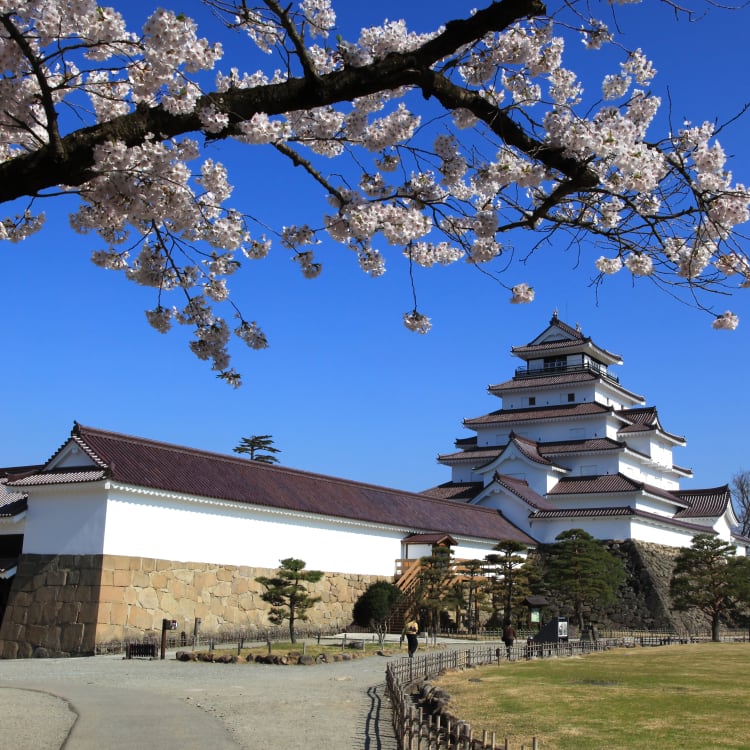
ITINERARIES Exploring Aizu's Samurai Spirit Live and breathe Japan's history of samurai warriors and merchants
Immerse yourself in the philosophy of the samurai through an exploration of castles, temples and post towns., how to get there, from tokyo: 3 hours.
Take the Tohoku Shinkansen from Tokyo Station to Koriyama Station, which takes about 1 hour 30 minutes. Then take a Shin-Joban Kotsu bus from just opposite Koriyama Station (1 hour 15 minutes). Tsurugajo Castle is near the "Tsurugajo, Godo-chosha-mae" bus stop.
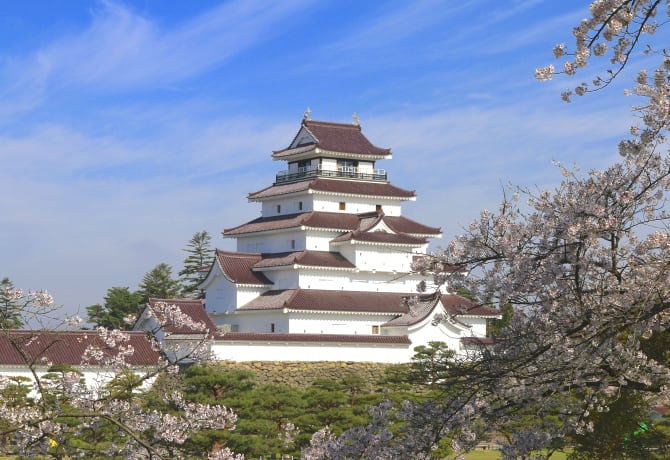
Stand on the grounds where one of the fiercest samurai battles in the Boshin War of 1868 was fought. As one of the last strongholds of Aizu samurai loyal to the Tokugawa Shogunate, this was where an uprising against the new government was fought.
The castle, which was first built in 1384, had been destroyed in the process but was rebuilt in the 1960s. It has since been recognized as a symbol of the brave samurai who proudly fought until the very end. One distinctive feature to take notice of is its red-tiled roof, which is unusual for castles in Japan. Spend some time at the onsite museum, where you can learn more about the history and culture of the Aizu region.
Take the Aizu Loop Bus to the Aizu Bukeyashiki-mae stop
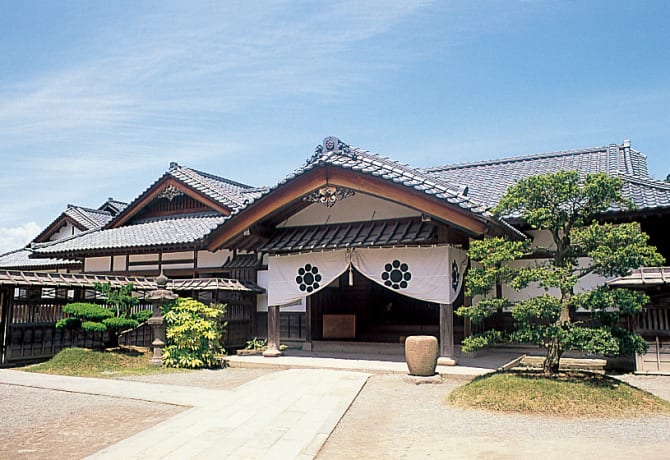
Imagine living as a samurai in feudal Japan at the Aizu Samurai Mansion—known as Bukeyashiki in Japanese—which had served as the quarters for the Aizu clan’s highest-ranked samurai, his family and his servants.
The prestige means the residence is quite large, with dozens of rooms and sections including gardens, a tea house and even an archery range. There are mannequins of the former inhabitants in many of the rooms portraying scenes of day-to-day activities.
Take the Aizu Loop Bus to the Iimoriyama-shita stop, then walk three minutes to the Byakkotai Museum
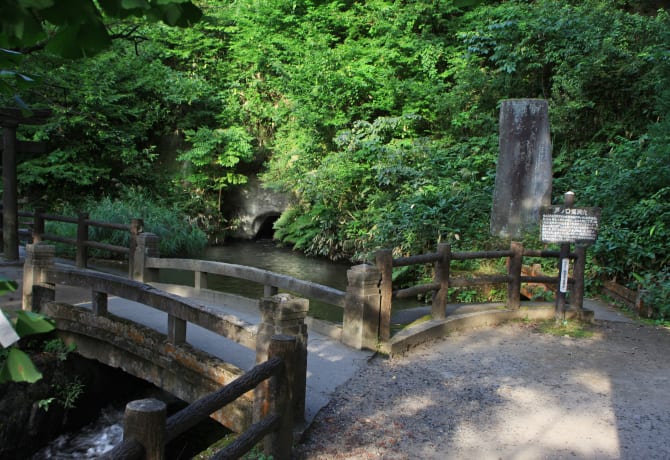
The Byakkotai were a group of teenage samurai warriors, aged 16 and 17, who fought in the Boshin War. They decided to take their own lives when, at Mt. Iimori, they saw flames coming from the direction of the Tsuruga Castle and thought they had lost the civil war.
Today, you can visit the spot where the boys lost their lives and the Byakkotai Museum at the base of the mountain has information about the boys.
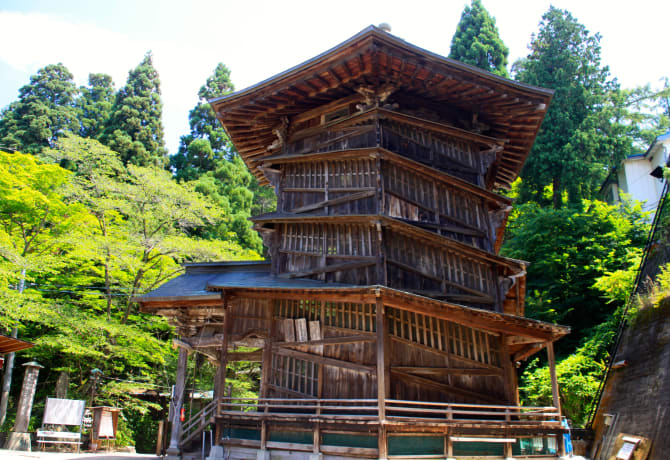
Built in 1796, Aizu Sazaedo is a hexagonal, three-tiered temple that stands at 16.5 meters tall and is located a short walk up Mt. Iimori. It is one of the most unusual architectural structures in the world—there are no stairs on the gradual ascent, and you must take different paths as you go up and down the building. A journey up and down Sazaedo is supposed to represent the Saigoku Kannon Pilgrimage to 33 Buddhist temples.
Take an Aizu Loop Bus to Wakamatsu Station. Change to a bus bound for Ashinomaki Chuo Machiaisho.
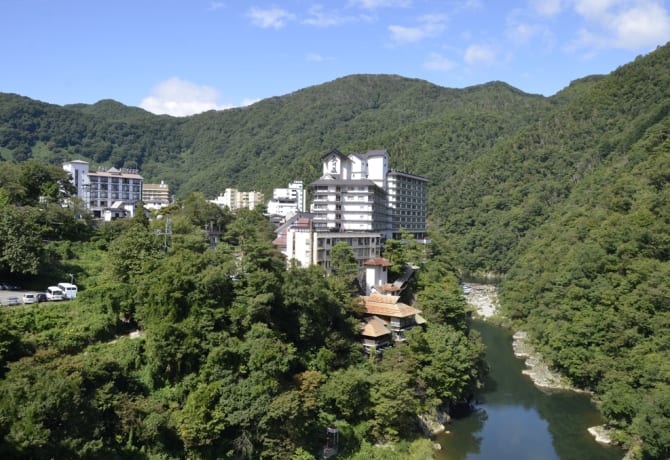
With a history of over a millennium, the Ashinomaki Onsen was said to have been established by the famous eighth-century priest Gyoki. Spend the night in one of the many inns along the Okawa River, and take a dip in one of the outdoor baths that offer beautiful views of the gorge no matter the season you are visiting in.
Take a bus to Ashinomaki-onsen Station. Board a train to Tonohetsuri Station.
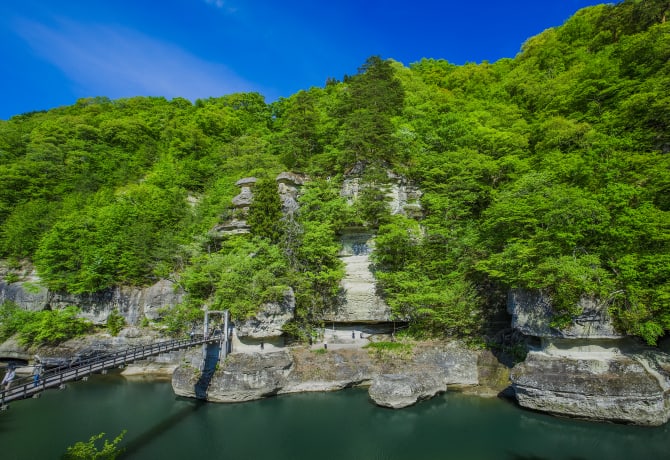
"Hetsuri" means cliff in the Aizu dialect, and it is designated a national monument. This scenic spot has unusually shaped rocks, formed millions of years ago.
Take a train to Yunokami Onsen Station. From there, board a bus to the Ouchi-juku bus stop.
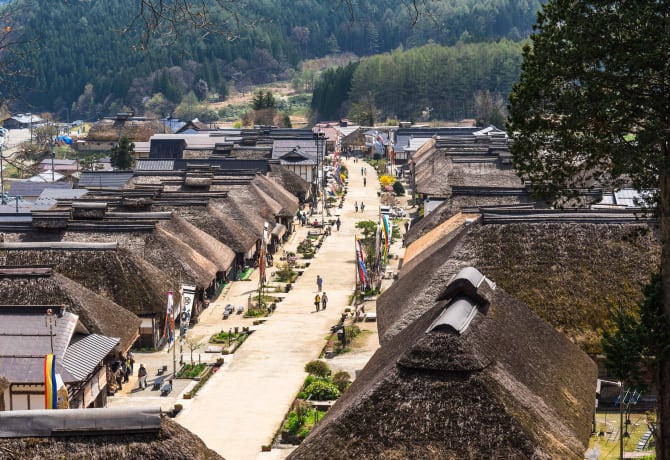
With its thatched roofs and a broad main thoroughfare, you might almost expect samurai warriors in period garb to come wandering down the streets at Ouchi-juku. This was formerly one of numerous “post towns," places where weary travelers could rest, that dotted Japan.
Be sure to try the local specialties of scallion soba noodles, and grilled char fish.
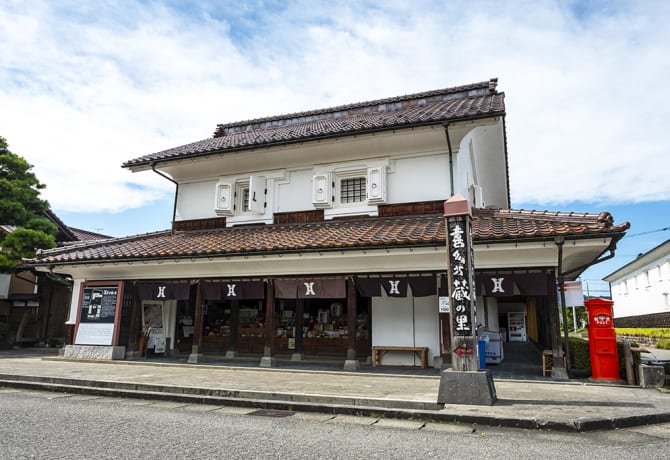
If you are a sake connoisseur, you will appreciate the rich history of the Yamatogawa Sake Brewery Northern Museum, a storehouse that was established in 1790. Learn about how sake is brewed through displays of the tools and equipment used, in order of the era they were from, to see their evolution. Cap your visit at the sake-tasting corner, where you can sample about 10 types of sake.
Recommended for You

- Itineraries
- Exploring Aizu's Samurai Spirit
Please Choose Your Language
Browse the JNTO site in one of multiple languages

Discover Aizu, Japan’s Samurai Region: Sake, Cuisine, and Cultural Heritage a Day Trip Away From Tokyo
Tradition is deeply ingrained in the historical area of Aizu, in western Fukushima Prefecture, reflected today in its picture-perfect rural villages, unique cuisine, and sake culture. A decade ago, you might have had to explain Japanese sake to non-Japanese people. Yet these days, it is a familiar sight in supermarkets around the world—and you may even have a bottle or two at home yourself! Such is the global popularity of sake—served in the Japanese way or in fusion cuisine or even in experimental cocktails that might surprise brewers in Japan. As for why it is such a hit, it clearly rode on the success of Japanese washoku cuisine in the West, but when it comes down to it, there is no taste quite like it. Whether smooth or crisp, hot or cold, it is a new frontier in flavor for most in the West. Add to that dedicated Japanese tableware to serve it with, and the very act of drinking it is a cultural experience. Even if sake, a.k.a. the rice wine, is instantly recognized by non-Japanese people, many still have blind spots where it’s concerned. Some tend to be uncomfortable navigating a complicated sake menu or lack knowledge about what goes into the finer bottles at the top of the sake world. With few exceptions, that knowledge can be found only in Japan itself, and any journey through the country offers countless opportunities to get closer to the essence of sake as well as the fantastic culinary culture that surrounds it.
Getting to Sake Country in Aizu, Fukushima
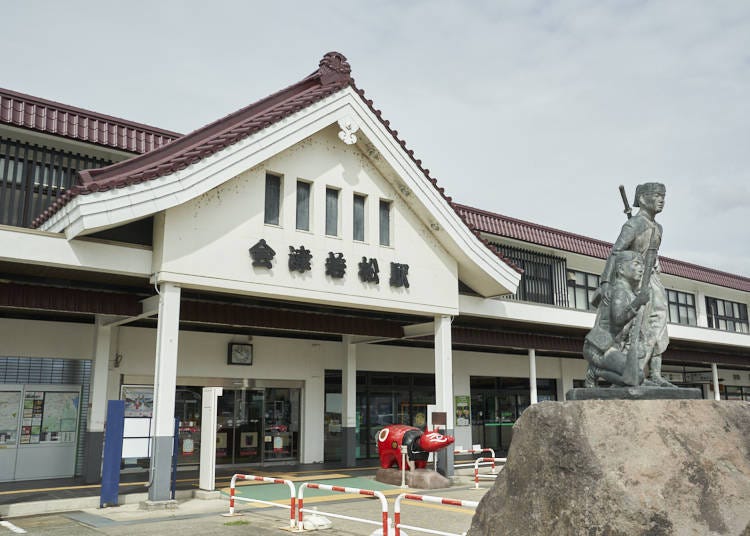
To make sake, you basically need just rice and water, as well as a bit of the fermenting agent koji to get the process going. So it is no surprise that there are sake breweries almost everywhere in Japan. But not all rice and water are equal, and for premium sake, you need quality rice and pristine water.
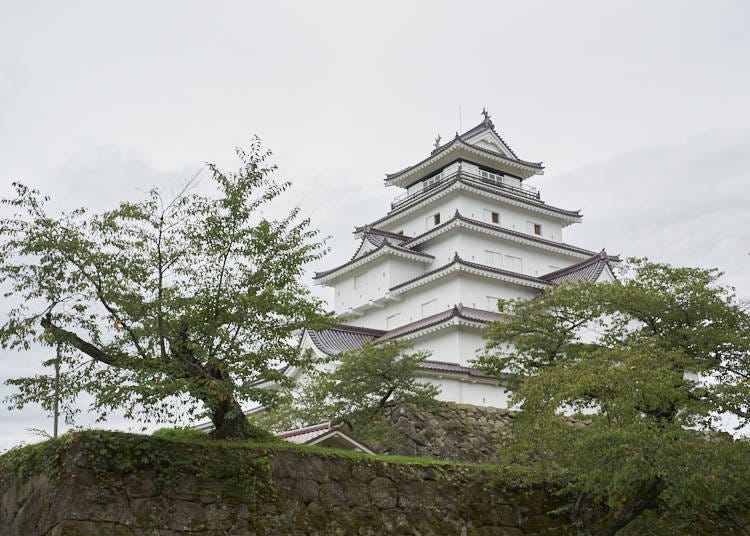
Located just north of Tokyo in Fukushima Prefecture, the Aizu region with its central city, Aizu-Wakamatsu, is close enough to be an easy trip from Tokyo, but far enough to offer a complete break from the Japan more frequently traveled. You can even get there from Tokyo Station in around three hours thanks to the Shinkansen bullet train.
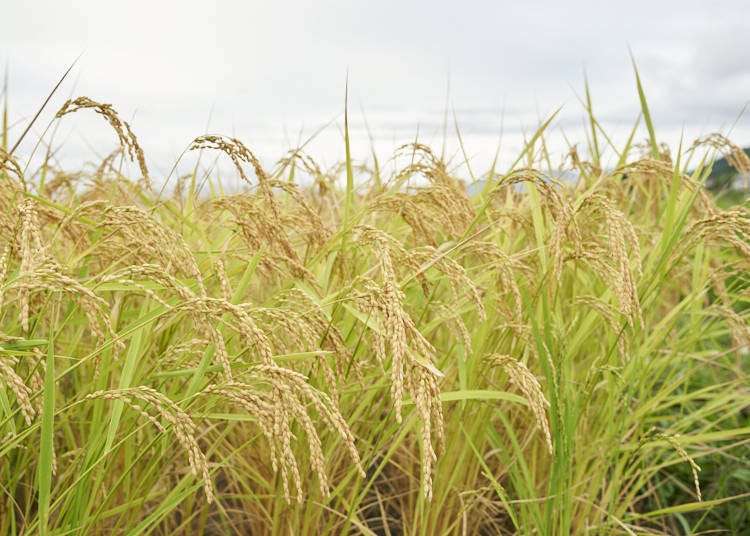
Sure to make an impact as you explore the area are all the rice fields, which will be between a verdant green and a warm yellow depending on the time of year.
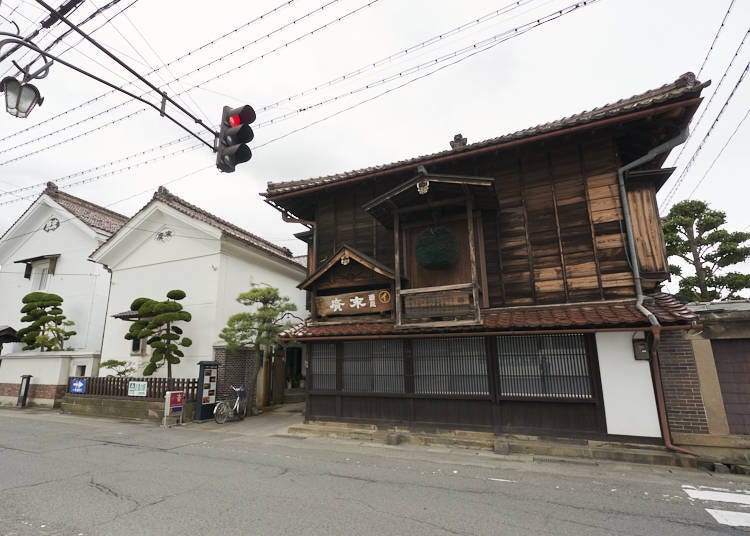
You will also spot plenty of traditional sake breweries, easily recognized by their traditional thick-walled white kura (storehouse). And why are kura built like that? To keep the temperature down—if there is any enemy of good sake, it is a variable temperature. Even if you visit in the height of the summer, you will notice the drop in temperature the moment you step inside the brewery.
Visit the Historic Sake Breweries of Aizu, Fukushima
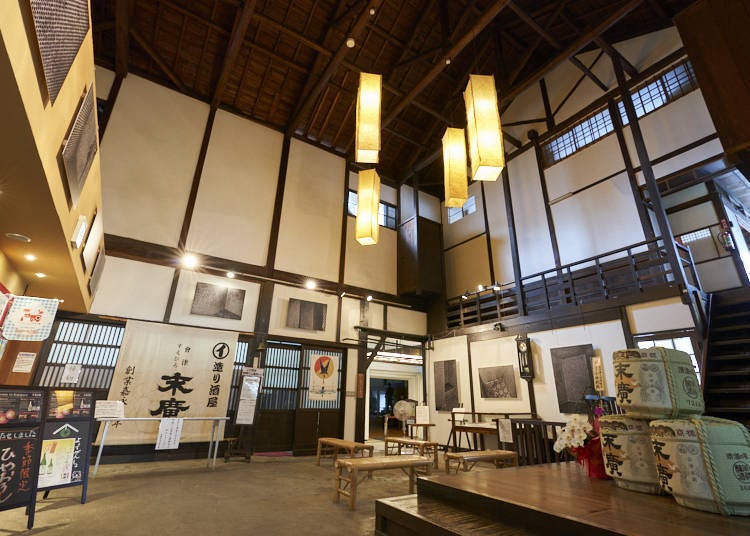
One of Aizu’s most famous breweries is Suehiro, which has been making award-winning sake since 1850. Now in its seventh generation of family ownership, Suehiro is a star on the global stage, scooping up numerous international awards for its delightfully smooth sake. Join one of the free tours to find out more(Tour is conducted in Japanese, but interpreters and translation devices are warmly welcomed).
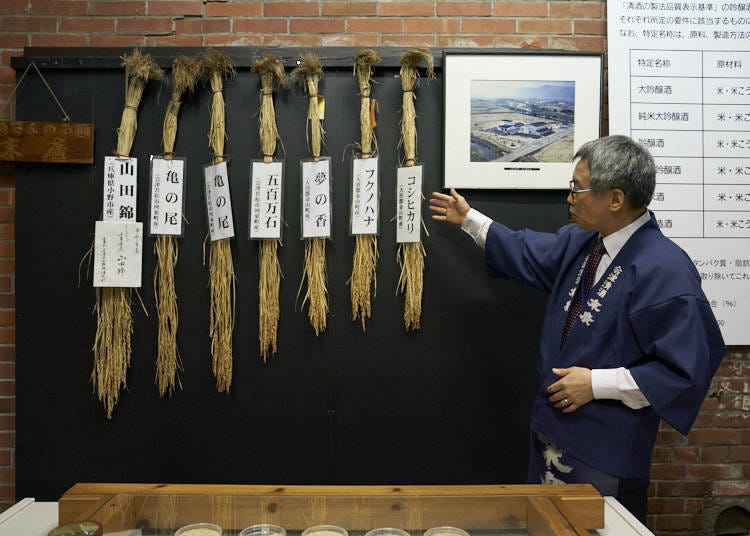
Suehiro’s success comes not just from the brewery’s provenance but also from its innovation. They are famous for pioneering a slow open-fermentation method called yamahai in Japan—a new brewing method that preserves traditional sake-making techniques.
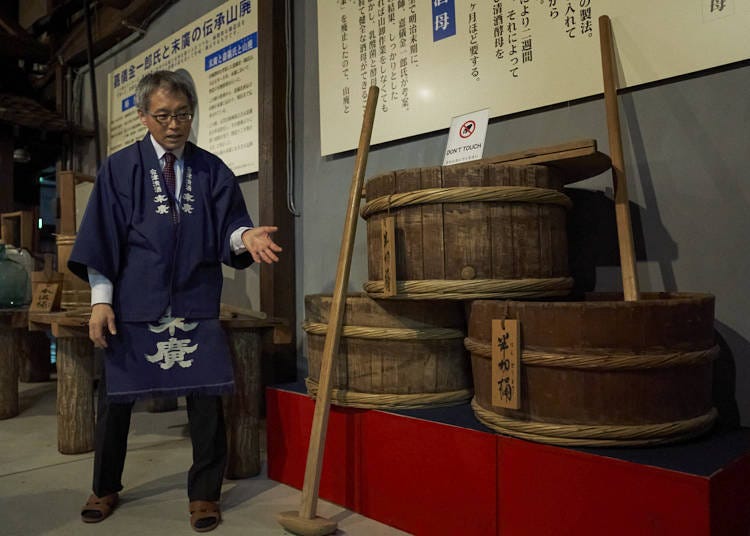
This time-consuming and labor-intensive brewing method is a paragon in the sake world, and you can relive its history by taking Suehiro’s free brewery tour (no reservation required).
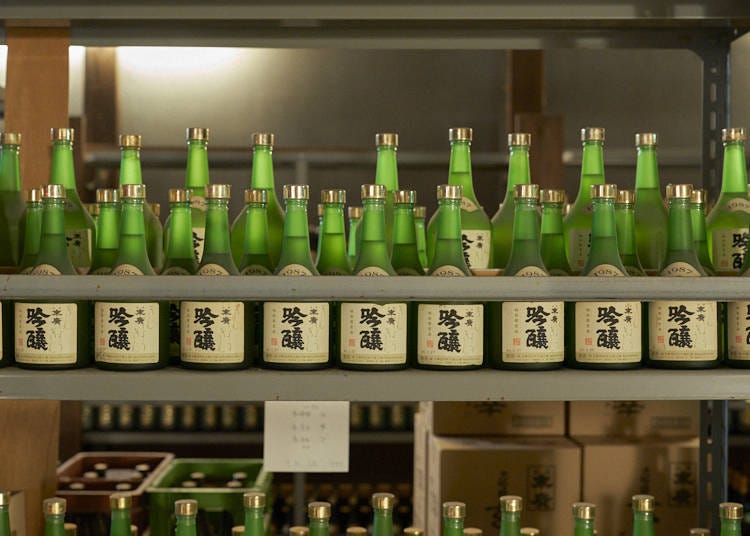
Beyond Beverages: Sake-infused Sweets!
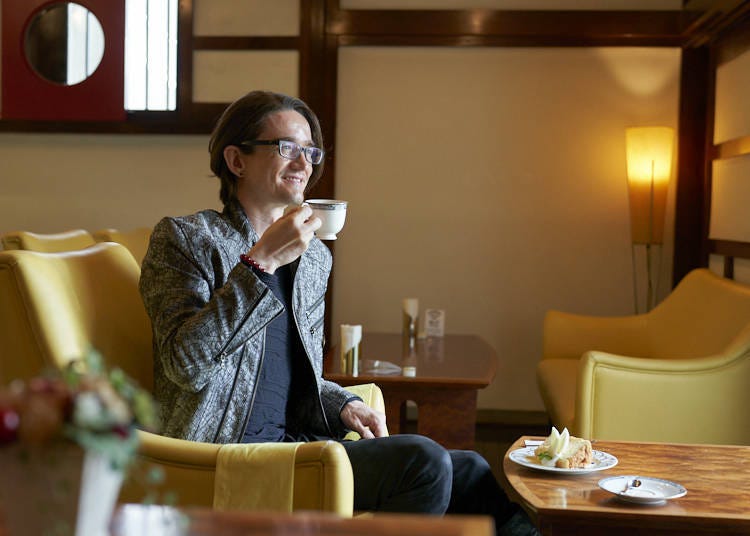
Sake is not confined to the ochoko (sake cup)—it is also a regular ingredient in Japanese cuisine. For a riff on East meets West, be sure to check out Suehiro’s café, which is actually inside an original storehouse dating from 1892.
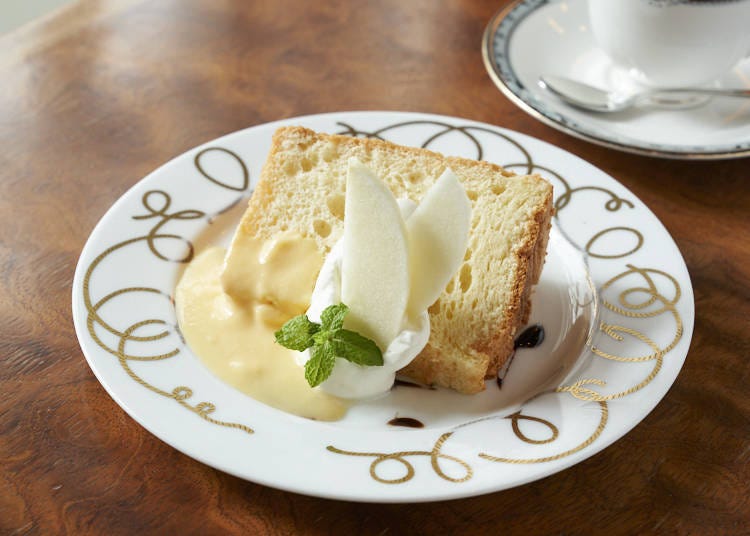
The stunning space takes you back to the early days of Western influence on Japan, best exemplified by the house specialty, Daijingo Chiffon Cake, the classic American cake infused with Suehiro’s sake. The selection of creative desserts shows that, in Aizu, Japanese tradition is alive with innovation.
- Address 12-38 Nisshin machi, Aizuwakamatsu City, Fukushima Prefecture, 965-0861
- Phone Number 0242-27-0002
Tours are free and held 10:00 AM–4:00 PM every day even on public holidays The brewery is closed every second Wednesday of the month (Tours are fully guided and held every hour from 10:00, lasting approximately 30 minutes. Advance reservations are not necessary, but tour groups will need to book in advance.)
Enjoy Aizu Sake, Paired with Soba Noodles in Ouchi-juku
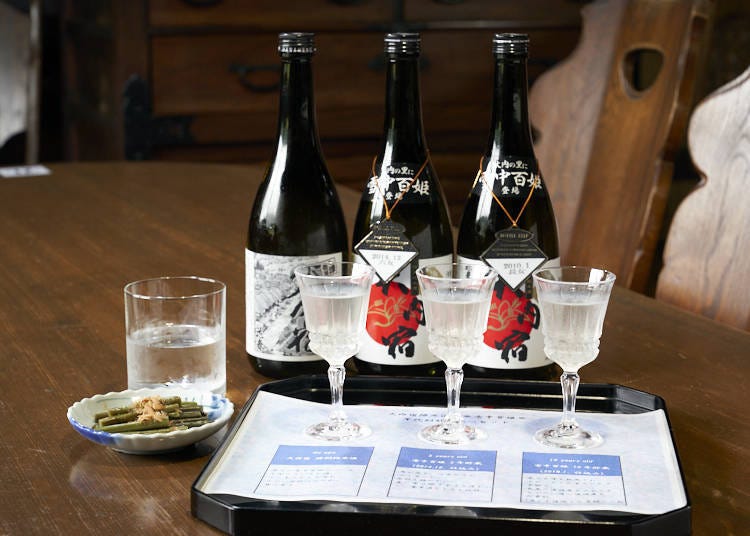
For a more traditional pairing of Japanese cuisine and sake, the food choice has to be soba (buckwheat) noodles. Japan has a long history of having a cup of sake pre-soba, and like the noodles themselves it is frequently served hot or cold to match the season. Savoring the smooth flavor of soba noodles combined with the heady glow of sake is one of the best ways to relax in a rustic setting in Japan, but you should know that in Aizu soba is done a little differently. Going all the way back to the seventeenth century, Aizu has been serving soba with a bit of a kick—namely, a hearty mound of daikon (Japanese radish). Called takato soba and best paired with a crisp karakuchi sake, the combination of rice wine and spicy soba can deliver a real burst of flavor. Takato soba was brought to the area by Hoshina Masayuki, the daimyo (feudal lord) and head of the Aizu domain Matsudaira clan in the Edo period (1603-1867). He had originally been the lord of the Takato fiefdom in present day Nagano Prefecture where soba was commonplace, so when he brought soba to Aizu, the place name of “Takato” stuck. Over time it really developed a character all of it own in Aizu, which you have to taste in person for yourself.
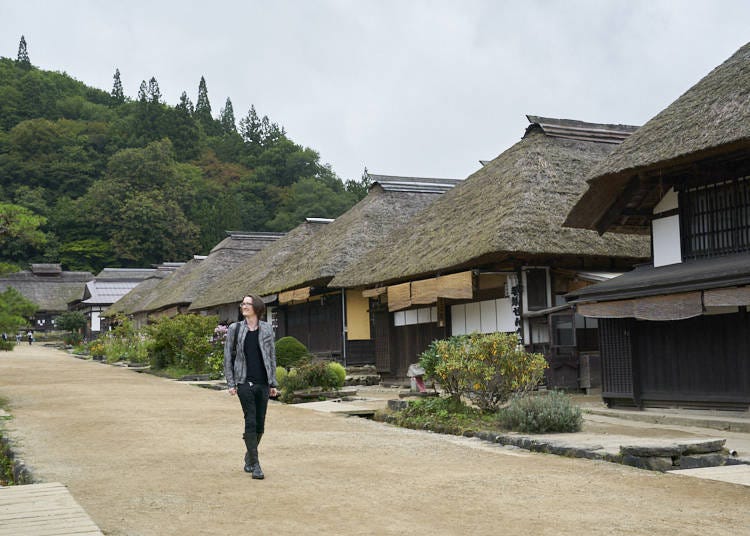
For the complete takato soba experience, head to Ouchi-juku, a traditional mountain village of thatched-roof houses, which stands largely unchanged from 400 years ago. Inside one of the historic thatched-roof buildings—soba in front of you and a cup of sake in hand—you will feel like you are back in the time when takato soba was first introduced in Aizu.
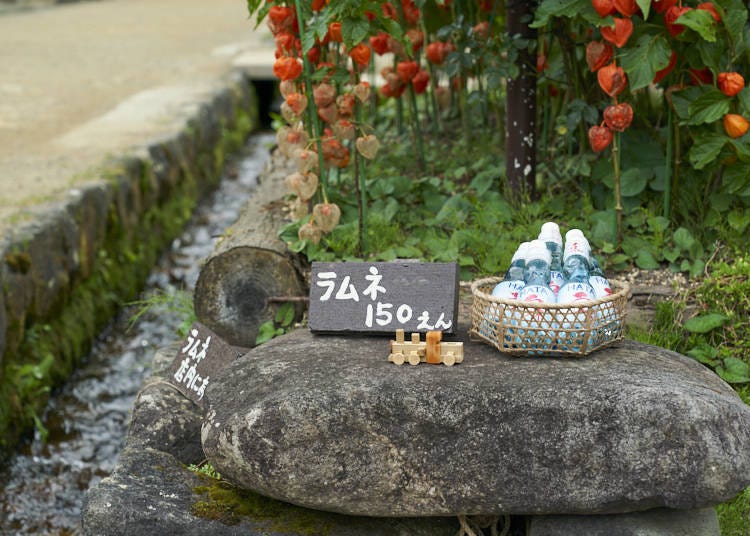
Try Next-Level Takato Soba at Ouchi-juku Miyasawa
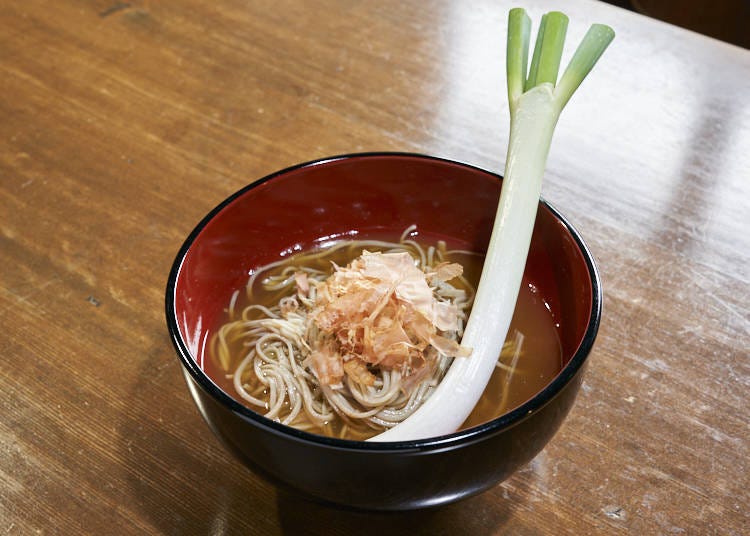
But don’t think we are done yet; there is one more flavor experience that alone is worth the trip to Aizu. As if takato soba wasn’t flavorsome enough, in the tiny town of Ouchi-juku, a number of restaurants have also incorporated the local negi (long green onion) into the dish. This custom started with the negi as a garnish on top of the noodles, but it quickly became something else entirely.
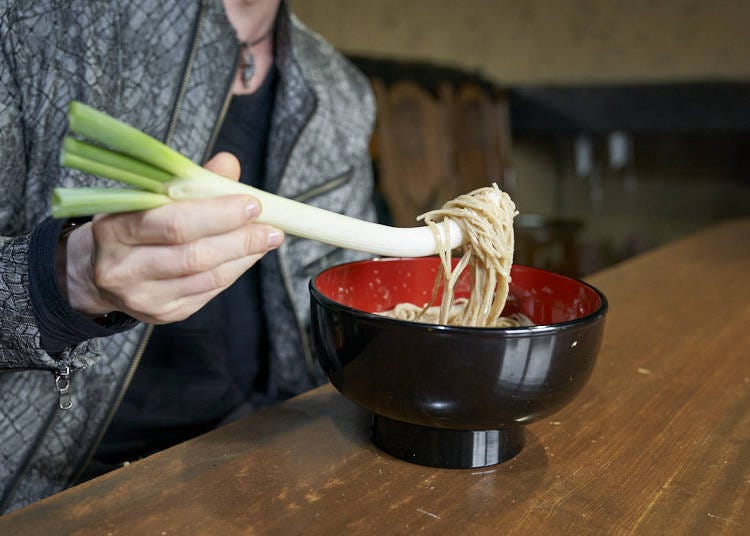
Thanks to restaurants like Misawaya, the negi in its entirety started to be served with the soba, so that you could chomp along the full length of a spicy green onion as you ate your soba. Then someone noticed that a slightly curved negi is actually a serviceable substitute for chopsticks, and in a flash one of Japan’s quirkiest culinary traditions was born.
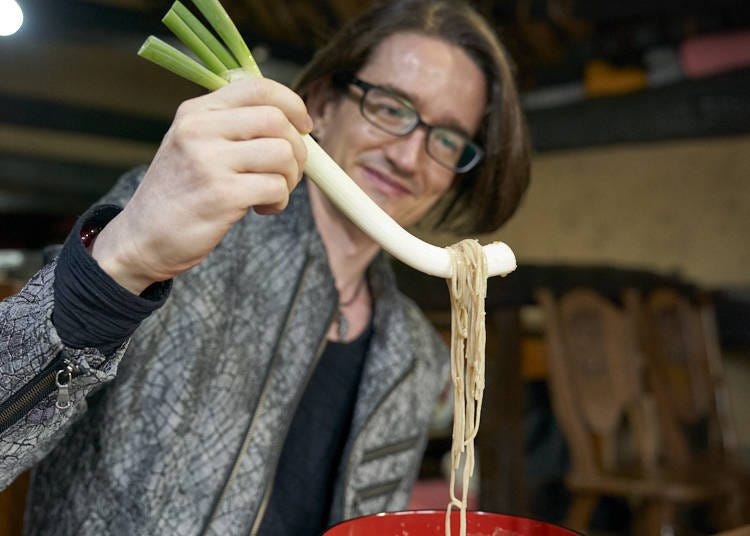
Instead of using chopsticks, you eat the whole bowl of noodles with the negi itself, a task made slightly easier since the green onions are purposely grown with a curve. As you eat, keep taking little bites of the negi, although be warned, it gets spicier and spicier the further you get from the root!
- Address 16-1 Aza Yamamoto, Oaza Ouchi, Shimogo, Minamiaizu District, Fukushima
- Phone Number 0241-68-2927
Opening hours: 9:30 AM – 4:00 PM Closed January 4-7
Explore Aizu’s Cultural Heritage Through the Aizu 33 Kannon Pilgrimage
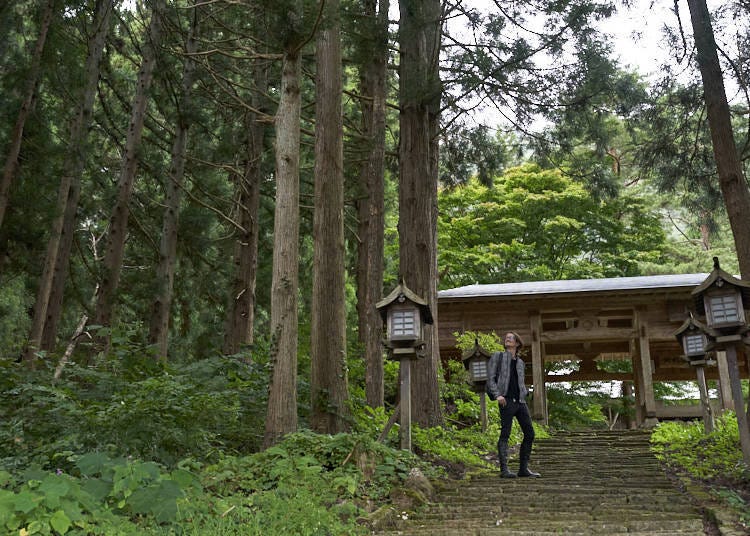
Aizu is a cuisine capital, but it is also a cultural heritage capital with rare protected cultural properties and unique sights making it one of Japan’s treasures, which is largely unexplored by international visitors. For the best excuse to travel the whole area, the designated Japan Heritage route of the Aizu 33 Kannon Pilgrimage is highly recommended. The origin of this 33-stop pilgrimage dates back to the seventeenth century, along with takato soba, which is no coincidence since both were propagated in the area by Hoshina Masayuki. Even for those who do not practice Buddhism, the pilgrimage is a great way to explore Aizu, since every temple and hall lies on the route at a spot of cultural significance or natural beauty.
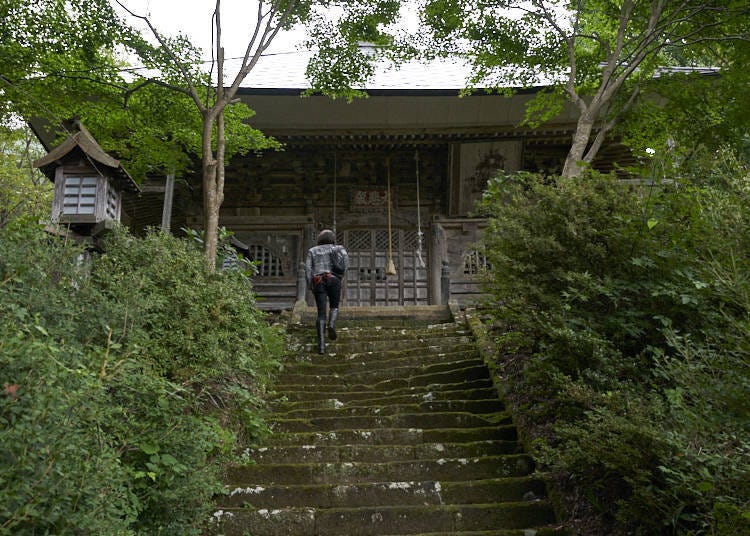
The number 33 in the name refers to Buddhist statues and images of the Kannon deity. While some are only open to the public at specific times, there are many exquisite Kannon statues and accompanying statues to be seen in truly fantastical settings. This pilgrimage is a spiritual journey that is guaranteed to make an impression—from Kannon’s image carved into a living tree at the temple Eryuji to the humble statue of Kannon that sits atop a mighty double-helix structure at the temple Sazaedo.
- Area Aizu-wakamatsu
- Category Other Nature Udon & Soba Other Sightseeing
- Sponsor Content Must-See
Share this article.

2-Day Sightseeing Getaway to Hoshino Resort Oirase Keiryu Hotel (Aomori)
by: Miyu Shimada

Enjoy the Beauty of the Hirosaki Cherry Blossom Festival in Aomori, Japan
by: Alexander Litz
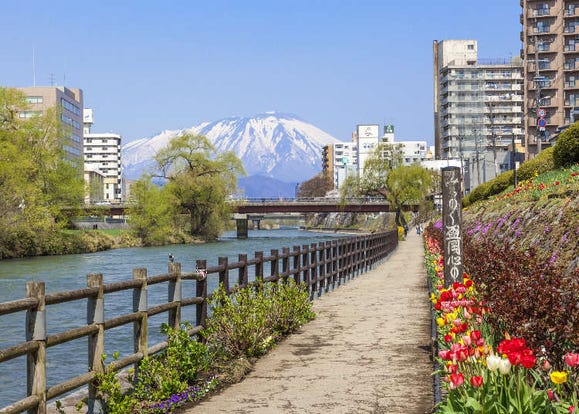
19 Best Things to Do in Morioka: See, Eat, and Shop Your Way Through Iwate's Capital City
by: Hiroko Ariga
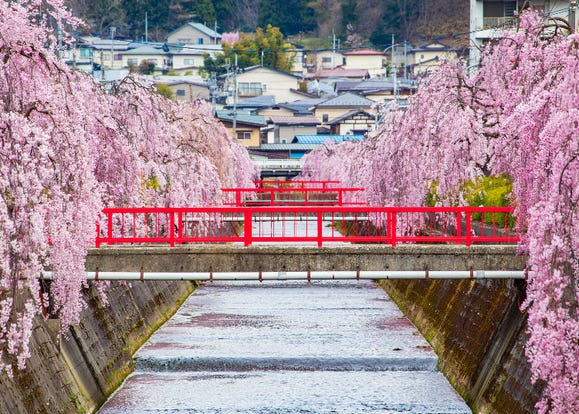
10 Breathtaking Places in Yamagata to See the Cherry Blossoms

Enjoy the Untouched Beauty of Oirase Keiryu (Aomori): Japan's Hidden Nature Gem

Iwate Prefecture Guide: Explore Rugged Coastlines, Towering Mountains, and Historic Towns in Northeastern Japan

Your Trip to Fukushima: The Complete Guide (Activities, Hotels, Savers & More)

Akiu Onsen Adventure: ‘Terroage’ Will Redefine Tourism to Miyagi and Beyond

Togatta Onsen Guide: Best 6 Places to Indulge Yourself in Miyagi Prefecture's Magical Hot Springs Resort Village

10 Important Japanese Phrases to Know Before You Enter a Japanese Convenience Store!
by: Teni Wada

Relax, Take Some Pics, Have Fun! This Winter, Head to Tohoku For Snow And Hot Springs

We Board Japan's 'Setsugekka' Resort Train And Have An Incredible Journey Through The Heartland
- Destinations
Top Things to Do in Aizu-Wakamatsu, the Samurai City
Aizu-Wakamatsu Bucket List
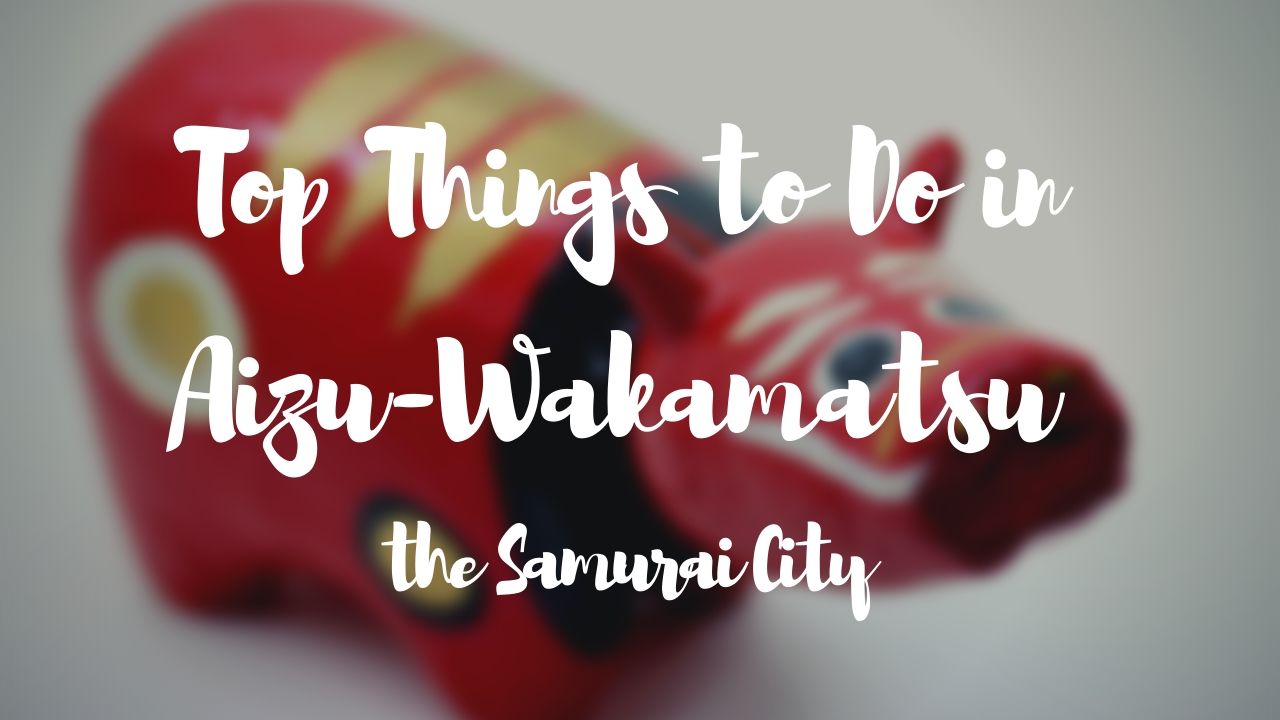
Aizu-wakamatsu, know as the Samurai City, is a city in the west of Fukushima Prefecture famous for being one of the last bastions of the samurai culture. Less known than big cities like Kyoto or Osaka, it’s the perfect place if you want to know the authentic traditional Japan without crowds of people.
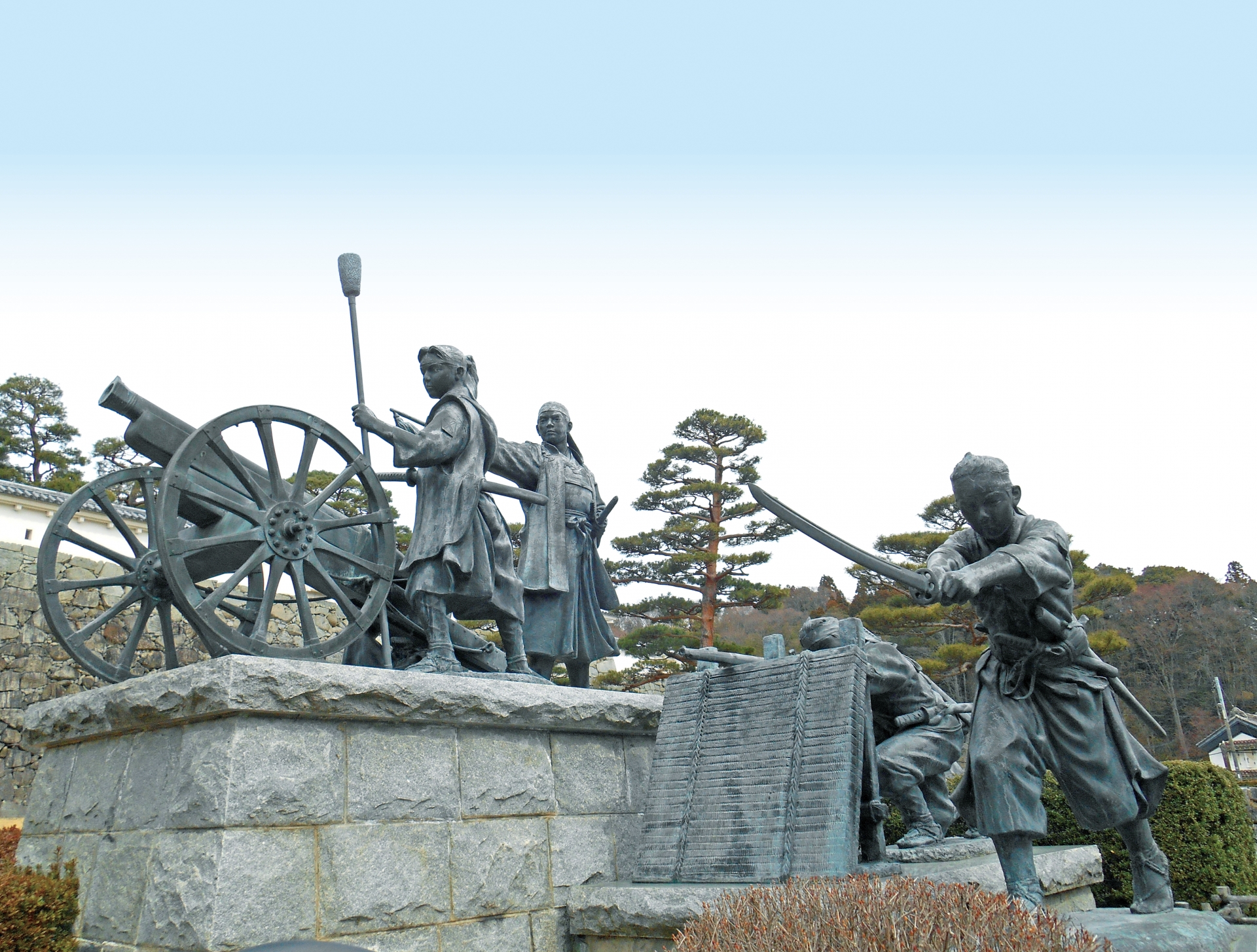
At the end of the 19th century Japan underwent a great change. For years Japan was ruled by what is known as the Tokugawa shogunate. Simplified, shogun literally means maximum army commander. Ieyasu Tokugawa was a shogun who managed to unify Japan, and de facto govern the country. The role of the Imperial Family in general and the Emperor in particular was relegated to the background. And this was so until as we explained at the end of the 19th century there was a change. For reasons that I will not stop to explain now, in Japan there was what is known as the Boshin War, a civil war between the supporters of the Tokugawa shogunate and the defenders of Emperor Meiji. Finally, Emperor Meiji’s army won the victory, giving way to what is known as the “Meiji Restoration” or “Meiji period” and ending the samurai world. A reference that surely you will all know about this historical period in Japan is the movie “The Last Samurai”. The film is situated at the end of the Boshin war.
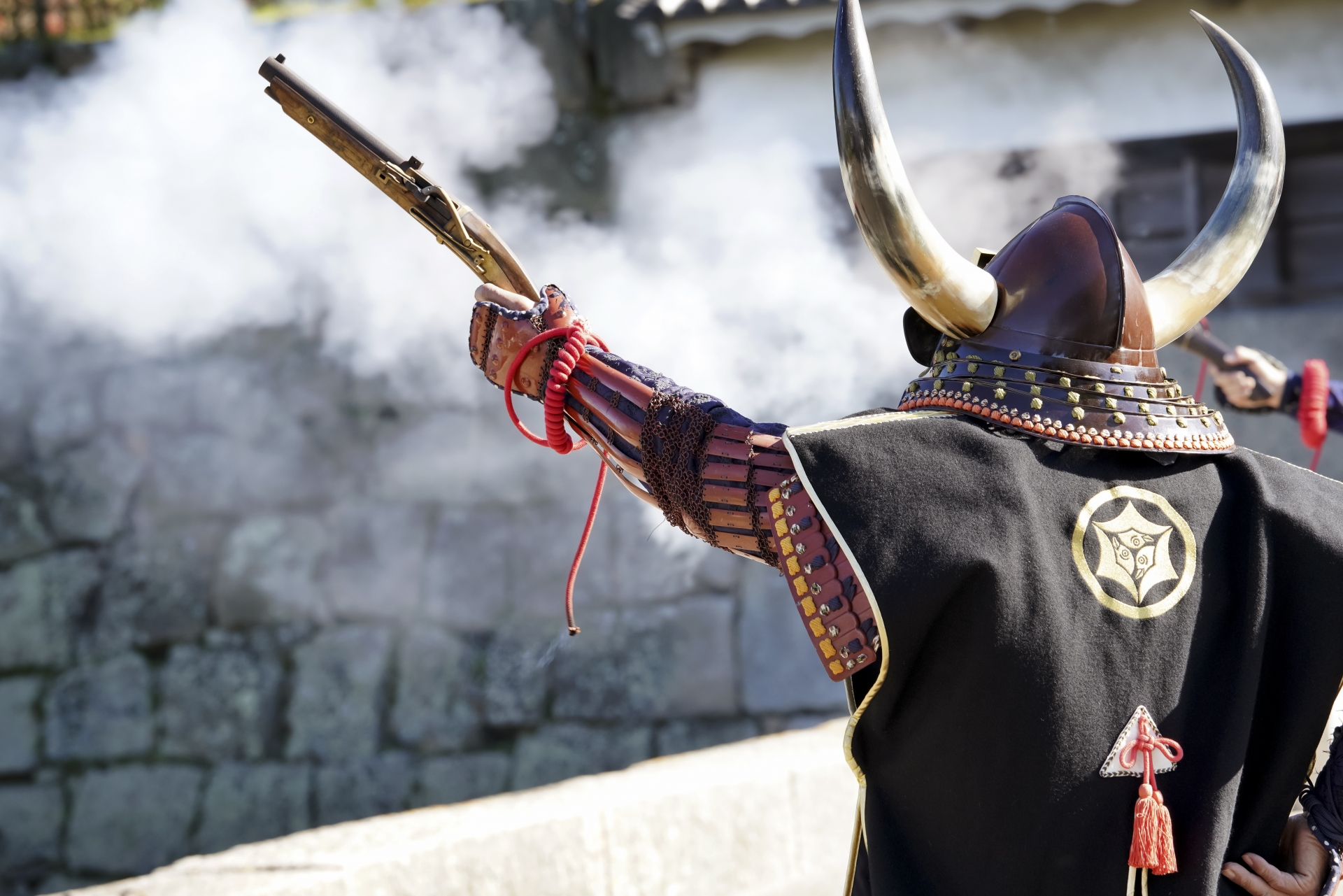
The Aizu clan remained loyal to the Tokugawa shogunate until the end and the city was one of the last to fall. This led to a strong reprisal by the Emperor once they won the war. The Aizu clan practically disappeared, and many buildings were destroyed. But despite that, the Aizu clan left a legacy of institutions, art and industry that remain the local pride.
Fukushima is an area sadly known for the great earthquake of 2011. Although Aizu-wakamatsu is in the pre-invoice of Fukushima, it is on the opposite side of the nuclear power plant and there almost no damage. Anyway, if you want to visit the area but you are worried, you can read this article and know the current situation ▶ Fukushima Now: 8 Years after the Nuclear Disaster
Tsuruga Castle
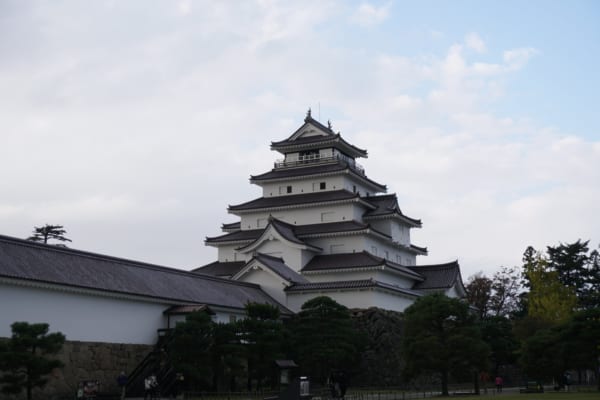
Tsuruga Castle or Aizu-Wakamatsu Castle, is one of Aizu’s gems and a must-go if you visit the city. It’s the only castle in Japan that is preserved with garnet-colored tiles. Formerly the castle was black and gold, but at the beginning of the Edo era there was an earthquake that brought down the castle and had to be rebuilt. At that time the gold and black were not considered good colors for a castle and was changed to the current design. Aizu is also famous for its porcelain, so they decided to make porcelain tiles. This decision was also taken to make it resistant to snow, since in this area in winter it snows heavily and the tiles tend to break but those of porcelain don’t.
The castle can be visited inside, and unlike what happens with the Osaka castle, which is renovated inside and has been converted into a museum, the Aizu castle is preserved inside. Although it also has a small part dedicated to the exhibition of ancient samurai armor of lords of Aizu and other historical objects, among them one of the biggest and most original samurai helmets I’ve ever seen.
Become yourself a samurai at Aizu Hanko Nisshin-kan
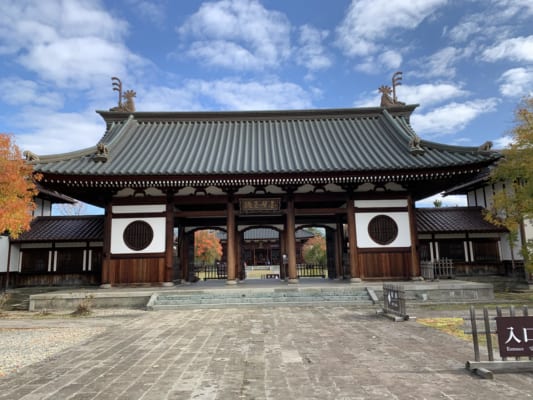
Aizu Hanko Nisshin-kan was the best among the more than 300 clan schools in the Edo era in Japan at the time due to its size, content and educational materials. At a time of special crisis for the Aizu Harunaka Tanaka clan, Mr. Katanobu Matsudaira’s trusted man believed strongly that the education of young samurai was the key to getting both the clan and the Aizu region to improve their situation. That’s why they put a lot of effort into building one of the best schools.
The students of the Aizu clan entered Nisshin-kan school at age 10 and were divided into different groups so that younger students could learn to respect their elders and proper manners, among other things.
The current school is a reconstruction of 1987, since like so many other things, the original was destroyed during the Boshin War. The original school was built in 1803 and was west of Tsuruga Castle.
Enjoy delicious Green Tea at Oyakuen Garden

We can find Japanese gardens in many cities of the country. Some, like the Kenrokuen gardens in Kanazawa, are famous for their beauty and size. The Oyakuen gardens in Aizu aren’t so big or spectacular, but they’re special. Oyakuen means “Medicinal Herb Garden”. They were created during the Muromachi period (1336-1573) as the second residence of Morihisa Ashina, head of the Ashina clan. Morihisa decided to build his second residence in this place since there was a spring of water that was said that had healing properties. In the second half of the 17th century under the command of another Lord, Matsudaira Masatune, the samurai of Aizu began growing medicinal herbs in the Oyakuen gardens to help the local population fight disease. That is when an herb known as ginseng began to be grown, which began to be exported as a specialty of the Aizu region.
Today, medicinal herbs (and non-medicinal herbs are still grown), and there is a shop where you can buy teas made from those herbs. Some people recommend going to the Japanese green tea house in front of the Trusuga Castle, but I prefer the little house in the gardens far away. Drinking green tea sitting outside while watching the lake feels really good.
Meet the legend of the Byakkotai at Iimoriyama Hill
The Boshin War left a deep mark in the Aizu region, and as in all wars, there are many sad stories related to the Boshin War. But probably the most famous is the story about the “Byakkotai.” The Byakkotai (White Tiger Unit) were a group of young samurai from the Aizu clan between the ages of 16 and 17 studying at the Hanko Nisshin-kan school. It was the youngest group, and under normal conditions, they wouldn’t have had to participate in a battle until they were more adults. However, with the side in favor of the Tokugawa shogunate losing more and more positions and the Aizu clan cornered being the last to fall, they had no choice but to send to the frontline of battle anyone who could fight.
During one of the battles, 20 members of the Byakkotai were separated from the rest of their unit and fled to Mount Iiomoriyama through a secret way inside a cave. The cave is usually full of water as it connects two lakes, but luckily at that time of year the level had dropped and allowed them to reach the other side. From Mount Iimoriyama, located about 2 km from the city center, they thought they saw the Tsuruga Castle on fire. Thinking that his clan had lost the battle, and after deliberating it for an hour between them, these 16-17 year old sons of samurai decided to commit seppuku (Japanese ritual suicide by sword) and take their own lives.
However, Iinuma Sadakichi, the smallest of the group (he was 15 years old), didn’t know how to perform the seppuku correctly and failed, which allowed him to survive and that some people found him dying in the bush and saved him. At first, ashamed for not having followed the fate of his companions, Iinuma didn’t want to talk about what happened. But finally he explained what had happened, and thanks to him today this story is known.
On Mount Iimoriyama we can find the tombs of these 19 young people, as well as that of Iinuma Sadakichi. We can also see the cave through which they managed to flee and the hill overlooking the city of Aizu-wakamatsu. From there they saw the flames. Today it’s believed that what they actually saw were the houses and buildings around the castle, but not the castle. We also usually talk about the 20 members, but in reality there were 3 who failed to get to the mountain alive (but are buried with their companions).
Eat Wappa Meshi, the local specialty
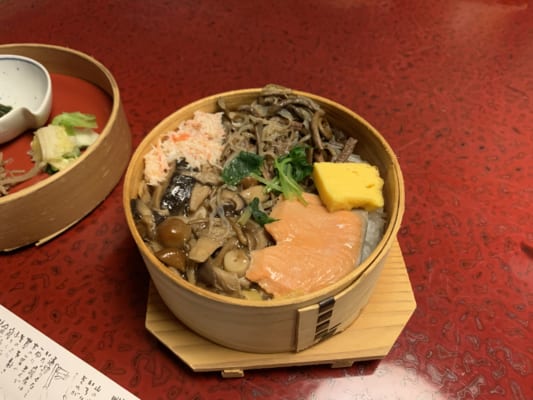
The wappa-meshi is a dish of rice and steamed food in a circular wooden bowl, which is eaten only in Aizu. It basically consists of white base rice and the ingredient you choose from those available above. Among the most common is salmon, or a combination of 5 ingredients (like the one in the photo), but there is also a special one of horse meat (in Japan it is not very common to eat horse meat). As I explained, these ingredients, like rice, are steamed. It may seem like a simple dish, but I assure you that it tastes delicious and leaves you full and with new energies to continue discovering the city.
There are many restaurants in the area that serve wappa-meshi, but I went to one called Takino Wappa-meshi , which is wappa-meshi pioneer restaurant. The place is an old rest house from the Edo period, which was moved here and restored in order to open the restaurant. So in addition to being able to eat a really delicious homemade wappa-meshi, you can enjoy an old two-storey rest house with private rooms. It is practically like eating in a house.
You can check the restaurant here
Tsurunoe Shuzo: Get Tipsy with the Best Sake in Japan

Among the Japanese, Fukushima is famous for its rice fields and rivers with pure water, which makes it the perfect place to make Japanese liquor. Or as it is known outside of Japan, “sake” (actually in Japanese ‘sake‘ means alcohol in general). And specifically in Aizu wakamatsu is the sake brewery that has won the awards for the best sake in Fukushima and the best sake in Japan for several consecutive years. Tsurunoe Shuzo is a company founded in 1794, although then it had another name. It adopted the name “Tsurunoe” early in the Meiji period (1868-1912) as a combination of Tsuruga Castle and Inawashiro Lake, two symbols of Aizu.
Tsurone Shuzo is only producing two brands. One is “Aizu Chujo”, whose production began in 1977 in honor of the firs lord of the Aizu clan, Masayuki Hoshina. “Aizu Chujo” won the gold award in the 2019 Annual Japan Sake Awards (National Research Institute of Brewing / Japan Sake and Shochu Makers Association).
The other brand is named “Yuri” is named in honor of Yuri Hayashi, daughter of the current owner of the brewery. Yuri and her mother Keiko created this new type of sake. So his father, who has a great affection and is proud of her, decided to put his name. Yuri is one of the first women in the sake industry, a mostly masculine world and one of the first female “toji”– a brewery’s chief brewer. We tried a “Yuri” brand sake that was the one chosen for a dinner between Abe and Trump!
Over 200 years in the business Tsurunoe Shuzo’s commitment to taste remains unchanged. Yuri’s father is the seventh generation in charge of this sake brewery and continue making the sake in the same way. Despite the new technologies, Yuri and his family continue to use the old machinery. So they can only make sake during the winter, since they don’t have cold rooms.
Discover how the samurai lived in Aizu Bukeyashiki
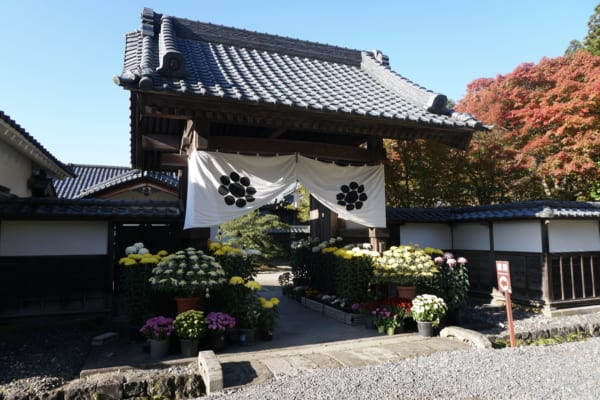
Given the great samurai legacy of the city, it is not surprising that many of the activities available in Aizu have to do with these legendary Japanese warriors. Aizu Bukeyashiki is a reconstruction of the residence of samurai Saigo Tanomo (1830-1903), one of the main generals of the Lord of Aizu.
Although for a while Tanomo was relegated from his duties as he had a point of view that cast doubt on the loyalty of the Aizu clan with the Tokugawa shogunate, he was called back to fight in the Boshin War. Initially Tanomo recommended surrendering and submitting to the demands of the imperial army, but when his lord refused to surrender, he fought alongside him to protect him. When he saw that the war was lost, he fled from Tsuruga Castle to Yonezawa and later Sendai. There he joined the Enomoto Takeaki fleet, which sailed to Hakodate, the city where the Boshin War finally ended. Tanomo became a priest after the war, and finally returned to Aizu, where he died.
The original residence was almost completely destroyed during the Boshin War but thanks to some drawings found in Tanomo’s residence it was possible to investigate and carry out a reconstruction that was completed in 1975. In the residence we find period buildings such as a historical archive, tea room and administrative headquarters.
Half day trip at the foot of Mount Bandai
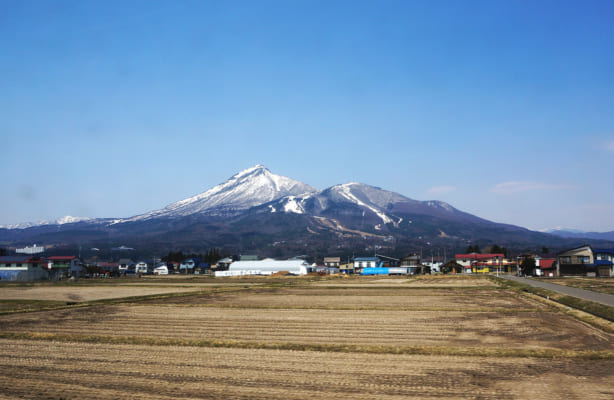
Mount Bandai is a volcanic mountain visible from several points of Aizu-wakamatsu. It’s his version of Mount Fuji in Tokyo and is famous in the region. And at the foot of Mount Bandai, in the city of Inawashiro, an hour and a half from Aizu-wakamatsu we find the Hanitsu shrine.
This shrine is dedicated to Hoshina Masayuki (1611-1673), the founder of the Matsudaira de Aizu house and the first lord of Aizu. It was built in 1675, following the will of Masayuki, who died in 1672. It’s said that the Hanitsu shrine was compared in size and beauty to the famous Nikko Toshogu, until it was destroyed during the Boshin War. The current shrine is a reconstruction of 1880 and was designated as a national historical site in 1987. Masayuki’s tomb is located north of the main enclosure.
Visit the historic and charming village of Ouchijuku
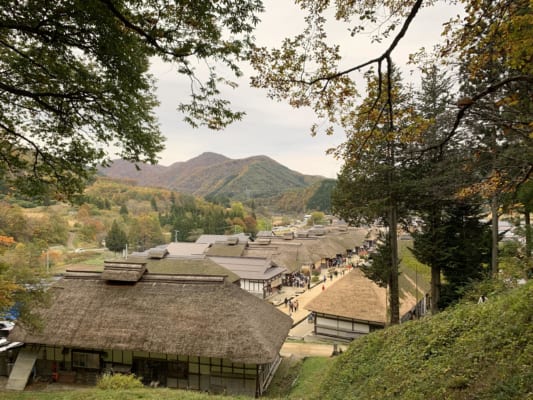
Ouchi-juku is a former post town located on the mountains southwest of Aizu-wakamatsu. During the Edo period, there is a route called Aizu-Nishi Kaido that connected the region of Aizu with that of Nikko and this route crossed the center of the village of Ochi-juku.
Under the Tokugawa shogunate, the feudal lords were ordered to live half a year in their domains and half a year in the capital, Edo (now Tokyo). Therefore, they often traveled this route and Ouchi-juku used to be a convenient stop-over for travellers to rest during their long journey on foot, providing them food and accommodations. However, when a new road opened, the feudal lords and the other people stopped using Aizu-Nishi Kaido route. That, at the time, was a problem for local villagers, who were isolated. But thanks to that it is also that today it is preserved as it was in the Edo era and has become an important tourist spot.
Take a rest and relax in a natural onsen
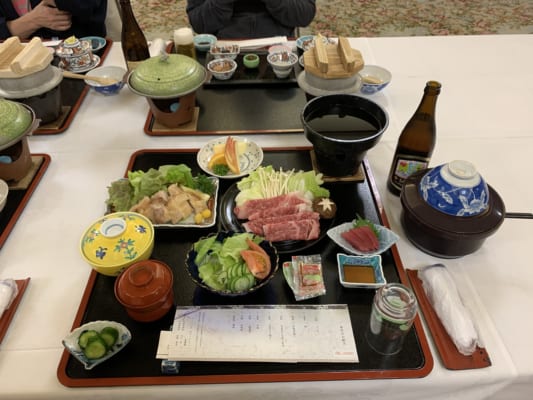
One of the best things to do in Japan is to enjoy a thermal bath or onsen. The onsen are extremely popular among the Japanese and is one of their favorite activities when they travel. Surely you have seen photos in magazines about beautiful onsen outdoors with nature. Although there are onsen in almost all of Japan , in cities like Tokyo or Osaka it’s difficult to find an authentic beautiful onsen that fits with the image that foreigners have in mind. But in more remote areas, such as Aizu, it’s very easy to find that kind of onsen.
On our second night we stayed at Active Resort Urabandai, owned by the Daiwa Royal Hotel group. The resort had absolutely everything from various restaurants and shops to a wonderful onsen with indoor and outdoor pool. We were able to enjoy a Japanese-style dinner and bathe several times in the onsen. After a day of sightseeing and walking, relaxing in hot springs with mountains in the background is the best feeling.
What do you think about the list?? If you are planning your first visit to Aizu, you should definitely add listed things to do on your bucket list and have a perfect trip in Aizu! Although I recommend you stay in the city 2 days to see all spots and enjoy the visit, it is also possible to see Aizu-wakamatsu in one day trip from Tokyo. Just pick the things you liked most on the list and plan your perfect itinerary in Osaka in one day!
How to get to Aizu-Wakamatsu from Tokyo
Shinkansen: Approximately 150 minutes through the Tohoku Shinkansen line. At the Koriyama station, change to the Banetsusai line to the Aizuwakamatsu station.
Train: Approximately 240 minutes with the Tobu Railways line from Shinjuku or Asakusa station. Change at Kinugawa-Onsen station or Aizutajima station to the Yagan-testsudo or Aizu lines to Aizuwakamatsu station.
Bus: Depending on traffic, about 270 minutes from the Shinjuku bus terminal.
Car: With the road cleared, 200 minutes through the Tohoku Highway.
▽Here are the attractions you should experience across Japan with this Japan Bucket List!▽

▽Check more things to do in Tohoku Region!▽
▶︎10 Best Things to Do in Aomori ▶︎10 Best Things to Do in Iwate ▶︎10 Best Things to Do in Akita ▶︎11 Best Things to Do in Miyagi ▶︎10 Best Things to Do in Yamagata
For more ideas about not-so-known places to travel in Japan or things to do in the Fukushima area, please check out my other articles listed below, too!
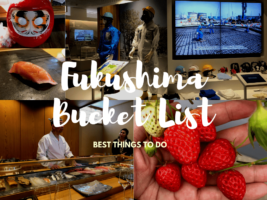
▽ Related Articles ▽
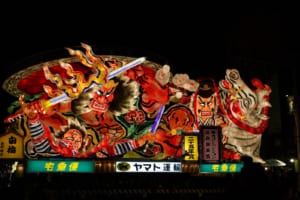
▼ Editor’s Picks ▼
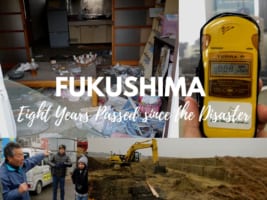
From Barcelona to Tokyo. Coffee & Adventure lover 🌏☕️
I started to like Japan because of the anime, music and doramas, but after my first trip to the country I found what I love the most: traveling around, the culture and history. I have travelled a lot in Japan, but I still have many places to discover that I want to share with you 🙋🏼♀️ Let’s discover Japan together!
Also, as a foreigner living in Japan for over 6 years I understand what kind of things are difficult when you move here and I want to help other people in the same situation that I have in the past.
- Things to Do

Aizuwakamatsu

Recommended Spots
2 days of enjoying the samurai culture and the cityscape at once.

Tsuruga Castle Tenshukaku
Aizu bukeyashiki, nanukamachi dori, suehiro sake brewery kaeigura, fukunishi honten, regional foods.

Sake experience made with quality ingredients

DENGAKU DONE WITH SIMPLICITY

WAPPA-MESHI, RICE AND OTHER STEAMED INGREDIENTS

TSURUGAJO CASTLE IN SPRING AND OLD SAMURAI RESIDENCE

A visitor plucks a cabbage growing under the snow
sightseeing

The hot spring water that comes from the moorlands is said to promote beauty

Draft horses compete in a one-in-a-kind race
Aizu-Wakamatsu Tourism Bureau
URL : https://samurai-city.jp/en/
Aizu: Getting there and around
Getting to aizu.
- ¥ 9,500
Take a Yamabiko train along the JR Tohoku Shinkansen from Tokyo to Koriyama Station and transfer to a regular train on the JR Banetsu-sai Line. Get off at Aizu-Wakamatsu Station. The entire trip takes approximately three hours, costs about 9500 yen and is fully covered by the Japan Rail Pass .
- ¥ 5,000
Multiple daytime and overnight buses are operated between Tokyo (Busta Shinjuku bus terminal) and Aizu-Wakamatsu Station. The one way trip takes 4.5 hours (7 hours by overnight bus) and costs 5000 yen one way. A limited number of discounted one way tickets are available if purchased at least one day in advance.
Nikko and Aizu-Wakamatsu are connected with each other by a rural train line that is operated by Tobu Railway, Yagan Railway and Aizu Railway. With good connections, the one way ride takes about three hours, costs around 5000 yen and requires 2-3 transfers of trains along the way, typically at Shimo-Imaichi, Kinugawa Onsen and/or Aizu-Tajima. It is not covered by the Japan Rail Pass .
Above fees and schedules are subject to change. Be sure to check current yen exchange rates .
Getting around
Aizu 's main railway station is Aizu-Wakamatsu Station, served by JR and the Aizu Railway. The city's attractions are not located within walking distance of the station and are distributed across the city center, with many concentrated in and around Tsuruga Castle Park .
The easiest way for tourists to get around are the Aizu Loop Buses which connect Aizu-Wakamatsu Station with all of the city's sites of interest. Buses running in the counter-clockwise direction are called Haikarasan and depart every 30 minutes, while buses running in the opposite direction are called Akabe and operate once per hour. The fare is 210 yen per ride or 600 yen for a day pass for unlimited rides on one calendar day.
Aizu has also a network of regular city buses , although most tourists will not need to use them, as the loop buses are easier to use. Fares for regular buses are dependent on distance traveled.
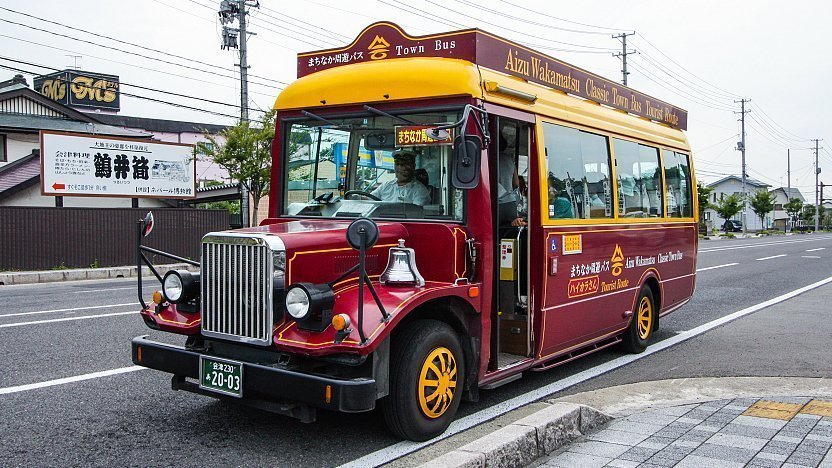
Questions? Ask in our forum .
Links and Resources
Aizu loop bus, jr bus kanto, hotels around aizu.
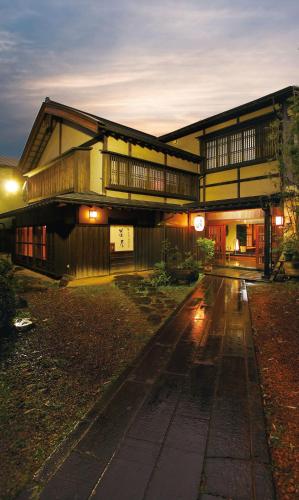

COMMENTS
Travel guide for the Aizu region in Fukushima Prefecture, famous for its samurai history.
Set in a beautiful valley, Aizu-Wakamatsu offers onsen, hiking, and river sports, as well as some well-preserved traditional townscapes. The area is also famous for its lacquerware. It was the last stronghold of the samurai at the end of the 19th century, and there is much to see of this history.
Aizu-Wakamatsu is the capital of the Aizu region on the southern part of the Aizu basin, and came to be central to the region with the construction of Tsurugajo Castle in 1384.
Things to Do in Aizuwakamatsu, Japan: See Tripadvisor's 8,128 traveler reviews and photos of Aizuwakamatsu tourist attractions. Find what to do today, this weekend, or in September. We have reviews of the best places to see in Aizuwakamatsu. Visit top-rated & must-see attractions.
Don't know where else to go that isn't just a big city? Want to make unique memories outside of the usual tourist areas? Try Aizu-Wakamatsu, a historical area that's beautiful and full of surprises!
Plan your perfect trip to Aizu-Wakamatsu with our insider's guide. Discover the top historical sites, local specialties, and unique experiences while making memories to last a lifetime. North of Tokyo, in the mountains of Fukushima Prefecture, lies the small city of Aizu-Wakamatsu. Chock-full of preserved historical sites, rich samurai culture, and award-winning local sake - but without all ...
Aizu Wakamatsu is a former castle town located in the Fukushima Prefecture with a long and eventful history. Nowadays, it brings in tourists in droves due to its wonderful variety of local landmarks and attractions that highlight its history (which is entangled with samurais!) as well as reputation for producing award-winning sake.
Aizuwakamatsu Tourism: Tripadvisor has 8,128 reviews of Aizuwakamatsu Hotels, Attractions, and Restaurants making it your best Aizuwakamatsu resource.
The 9 Best Things to Do in Aizu Wakamatsu Aizu Wakamatsu is the primary city in the Aizu region of Fukushima Prefecture, we spent several days here exploring, sometimes on foot, and other times using the tourist office buses that will take you on set routes around the city. We explored the castle, because, you know we just LOVE Japanese castles, we found out a whole lot more about Japanese ...
Aizu-Wakamatsu is a city nestled in the mountains in the west of Fukushima prefecture, in Japan's Tohoku area. Once the former feudal capital of Aizu domain, the city has become a touristic destination renowned for its castle and samurai clans' heritage. Amateurs of retro shopping will also enjoy the local traditional craftsmanship.
Aizu-Wakamatsu is a samurai town located in Fukushima prefecture. Here we explain how to enjoy the area in two days!
My in depth travel guide for Aizuwakamatsu - an off the beaten path destination in Japan that's FULL of culture, history, and great food...
Known as the "samurai city," Aizu Wakamatsu flourished as a castle town in Fukushima Prefecture. We introduce local attractions that let visitors experience true samurai history and culture, local food and lodging recommendations, as well as beautiful places to explore during a leisurely walk.
Aizu Wakamatsu Castle. Aizuwakamatsu (会津若松) is the main city in the Aizu region of Fukushima Prefecture, in the north of Honshū island, the largest of Japan. With a population of 120,000, Aizuwakamatsu has a rich warrior history, stretching back 1,000 years.
Immerse yourself in the philosophy of the samurai through an exploration of castles, temples and post towns. Start your journey in Aizu Wakamatsu, where samurai warriors once lived and their rich tradition still continues. Then make your way to nearby Kitakata, a historical merchant town with beautifully preserved storehouses and famous ramen.
Things to Do in Aizuwakamatsu, Japan: See Tripadvisor's 8,128 traveller reviews and photos of Aizuwakamatsu tourist attractions. Find what to do today, this weekend, or in September. We have reviews of the best places to see in Aizuwakamatsu. Visit top-rated & must-see attractions.
Tsuruga Castle watches over contemporary Aizu Located just north of Tokyo in Fukushima Prefecture, the Aizu region with its central city, Aizu-Wakamatsu, is close enough to be an easy trip from Tokyo, but far enough to offer a complete break from the Japan more frequently traveled.
Discover Aizu-wakamatsu, the Japanese samurai city and the best things to do, including samurai training, local food, hot springs, Japanese sake taste and more! This is the Aizu-wakamatsu Bucket List.
Aizu Wakamatsu in Fukushima Prefecture is a dynamic labyrinth of boutique shops, sake breweries, ancient temples, sprawling castles, and gourmet delights perfect for an overnight adventure from Tokyo.
Visitor guide for Tsuruga Castle in Aizu-Wakamatsu City, Fukushima Prefecture
Aizu-Wakamatsu is a beautiful castle town in Fukushima. From Tsuruga Castle to a feline station master, there is so much to see in this history-packed destination! Visitors can also admire the stunning seasonal scenery in winter.
Enjoy a gottso feast in the Samurai City Once a stronghold of the Tohoku region, Aizu was long-governed by feudal warlords. Aizu is a castle town surrounded by mountains and blessed with an abundance of natural beauty, including the pristine scenery of Lake Inawashiro and Mount Bandai. The food and sake culture of Aizu has developed in conjunction with the four seasons of the year and is ...
The tourist information office at Aizu-Wakamatsu provides a free-of-charge, same-day luggage delivery service for tourists staying at ryokan/hotel at Higashiyama onsen. This is a good service for tourists wanting to go sightseeing before checking-in into their accommodation. I gave the name and address of my accommodations to the staff, drop ...
The city's attractions are not located within walking distance of the station and are distributed across the city center, with many concentrated in and around Tsuruga Castle Park. The easiest way for tourists to get around are the Aizu Loop Buses which connect Aizu-Wakamatsu Station with all of the city's sites of interest.
Aizuwakamatsu has a hot-summer humid continental climate (Köppen Dfa) characterized by warm summers and cold winters with heavy snowfall.Although it is located in an inland valley, Aizuwakamatsu's climate resembles that of the Hokuriku region on the Sea of Japan coast. Snowfall is very heavy during the winter at 4.78 metres (190 in), and snow cover reaches an average maximum of 0.39 metres ...